Emperor of the holy roman empire Stock Photos and Images
(5,156)See emperor of the holy roman empire stock video clipsQuick filters:
Emperor of the holy roman empire Stock Photos and Images
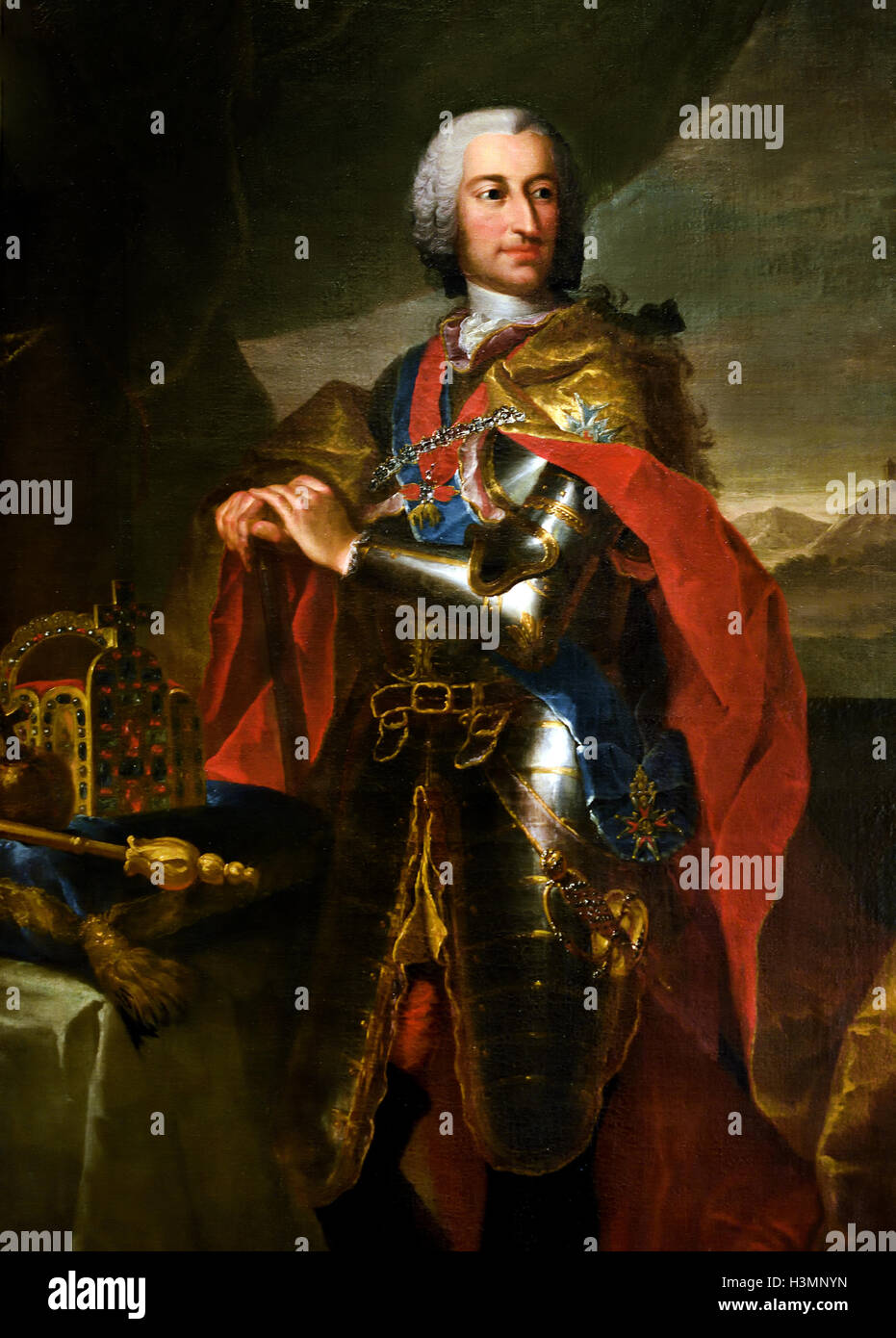 Karl VII Kaiser des Heiligen Römischen Reiches Deutscher Nation - Charles VII Emperor of the Holy Roman Empire of the German Nation (1742-1745 ) 1756 by Des Marées, George Germany Stock Photohttps://www.alamy.com/image-license-details/?v=1https://www.alamy.com/stock-photo-karl-vii-kaiser-des-heiligen-rmischen-reiches-deutscher-nation-charles-122772825.html
Karl VII Kaiser des Heiligen Römischen Reiches Deutscher Nation - Charles VII Emperor of the Holy Roman Empire of the German Nation (1742-1745 ) 1756 by Des Marées, George Germany Stock Photohttps://www.alamy.com/image-license-details/?v=1https://www.alamy.com/stock-photo-karl-vii-kaiser-des-heiligen-rmischen-reiches-deutscher-nation-charles-122772825.htmlRMH3MNYN–Karl VII Kaiser des Heiligen Römischen Reiches Deutscher Nation - Charles VII Emperor of the Holy Roman Empire of the German Nation (1742-1745 ) 1756 by Des Marées, George Germany
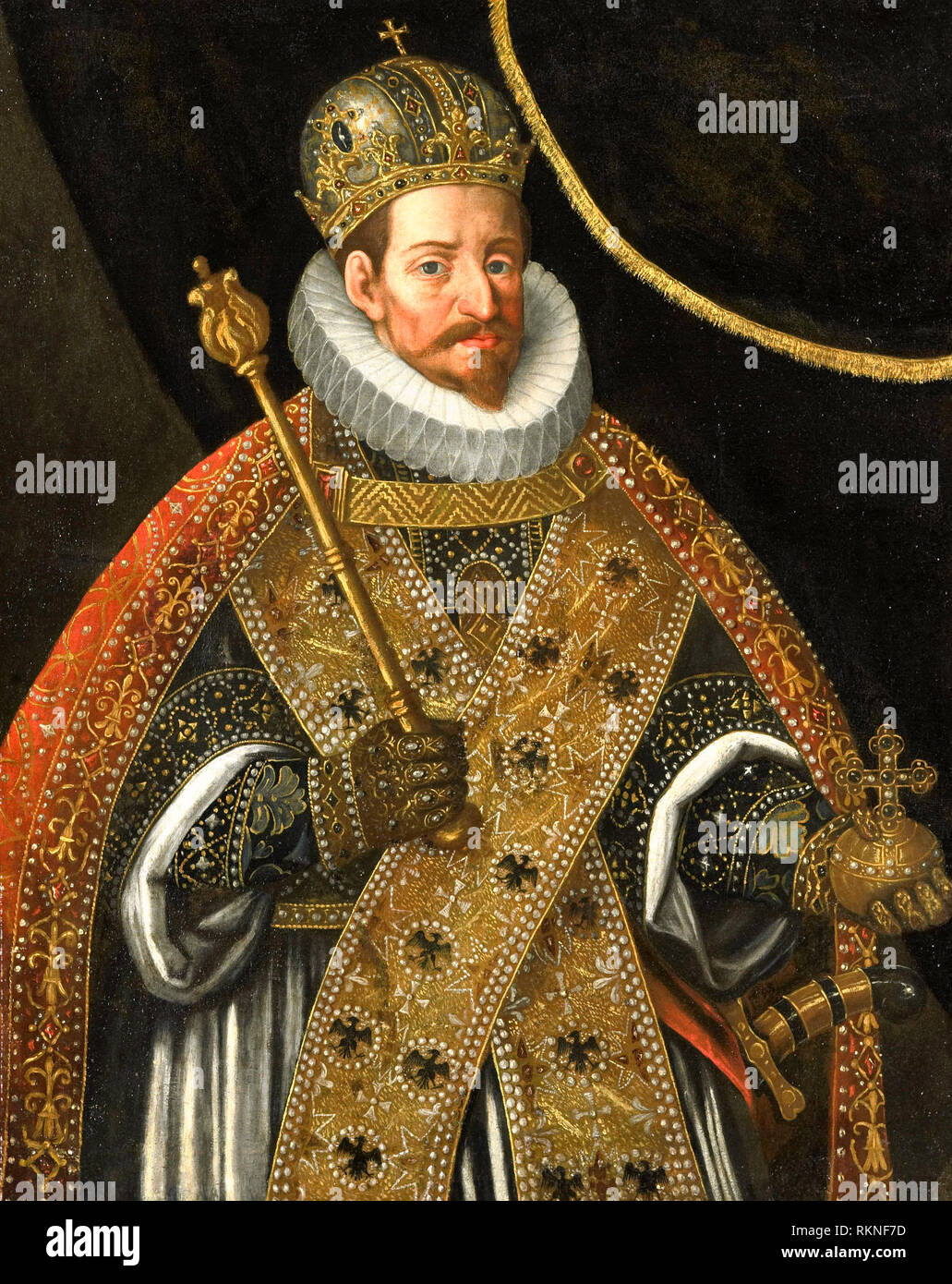 Matthias, Emperor of the Holy Roman Empire (1557-1619) - Hans von Aachen, circa 1610 Stock Photohttps://www.alamy.com/image-license-details/?v=1https://www.alamy.com/matthias-emperor-of-the-holy-roman-empire-1557-1619-hans-von-aachen-circa-1610-image235886209.html
Matthias, Emperor of the Holy Roman Empire (1557-1619) - Hans von Aachen, circa 1610 Stock Photohttps://www.alamy.com/image-license-details/?v=1https://www.alamy.com/matthias-emperor-of-the-holy-roman-empire-1557-1619-hans-von-aachen-circa-1610-image235886209.htmlRMRKNF7D–Matthias, Emperor of the Holy Roman Empire (1557-1619) - Hans von Aachen, circa 1610
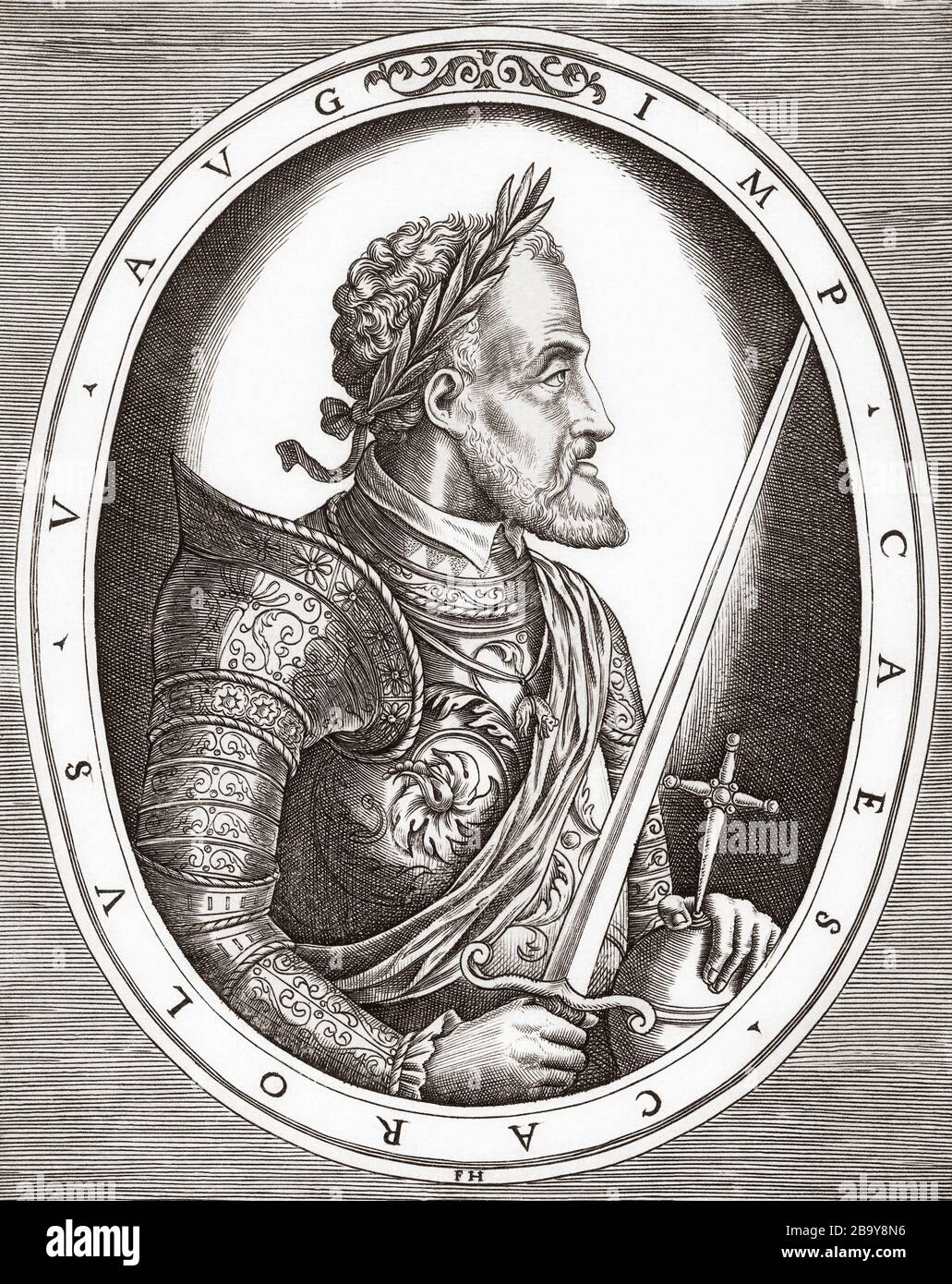 Charles V, 1500-1558. Emperor of the Holy Roman Empire. Carlos V. King of Spain as Charles I. Carlos I. After a 16th century print by Frans Huys. Stock Photohttps://www.alamy.com/image-license-details/?v=1https://www.alamy.com/charles-v-1500-1558-emperor-of-the-holy-roman-empire-carlos-v-king-of-spain-as-charles-i-carlos-i-after-a-16th-century-print-by-frans-huys-image350338834.html
Charles V, 1500-1558. Emperor of the Holy Roman Empire. Carlos V. King of Spain as Charles I. Carlos I. After a 16th century print by Frans Huys. Stock Photohttps://www.alamy.com/image-license-details/?v=1https://www.alamy.com/charles-v-1500-1558-emperor-of-the-holy-roman-empire-carlos-v-king-of-spain-as-charles-i-carlos-i-after-a-16th-century-print-by-frans-huys-image350338834.htmlRM2B9Y8N6–Charles V, 1500-1558. Emperor of the Holy Roman Empire. Carlos V. King of Spain as Charles I. Carlos I. After a 16th century print by Frans Huys.
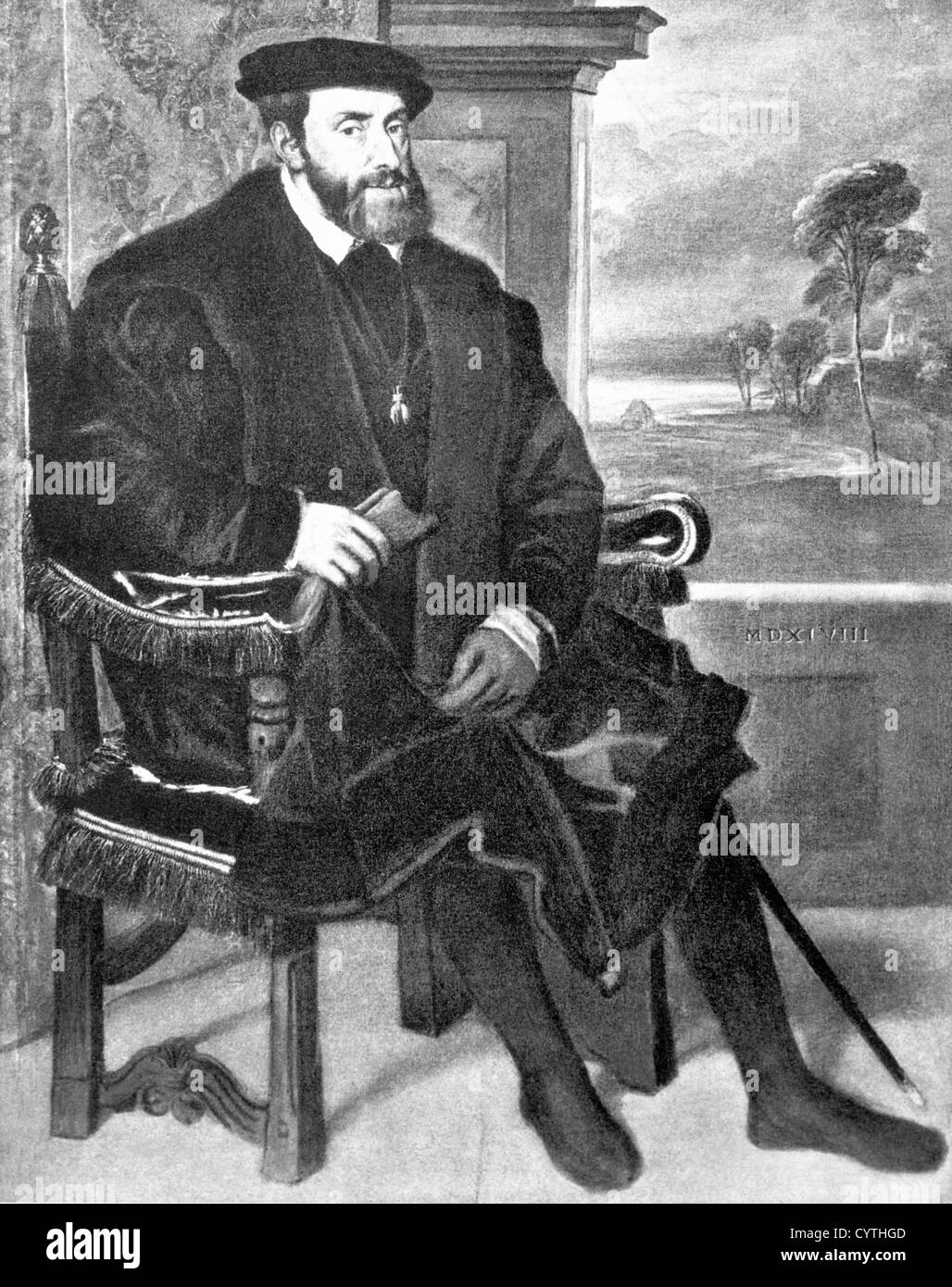 Charles V, Emperor of The Holy Roman Empire Stock Photohttps://www.alamy.com/image-license-details/?v=1https://www.alamy.com/stock-photo-charles-v-emperor-of-the-holy-roman-empire-51557085.html
Charles V, Emperor of The Holy Roman Empire Stock Photohttps://www.alamy.com/image-license-details/?v=1https://www.alamy.com/stock-photo-charles-v-emperor-of-the-holy-roman-empire-51557085.htmlRMCYTHGD–Charles V, Emperor of The Holy Roman Empire
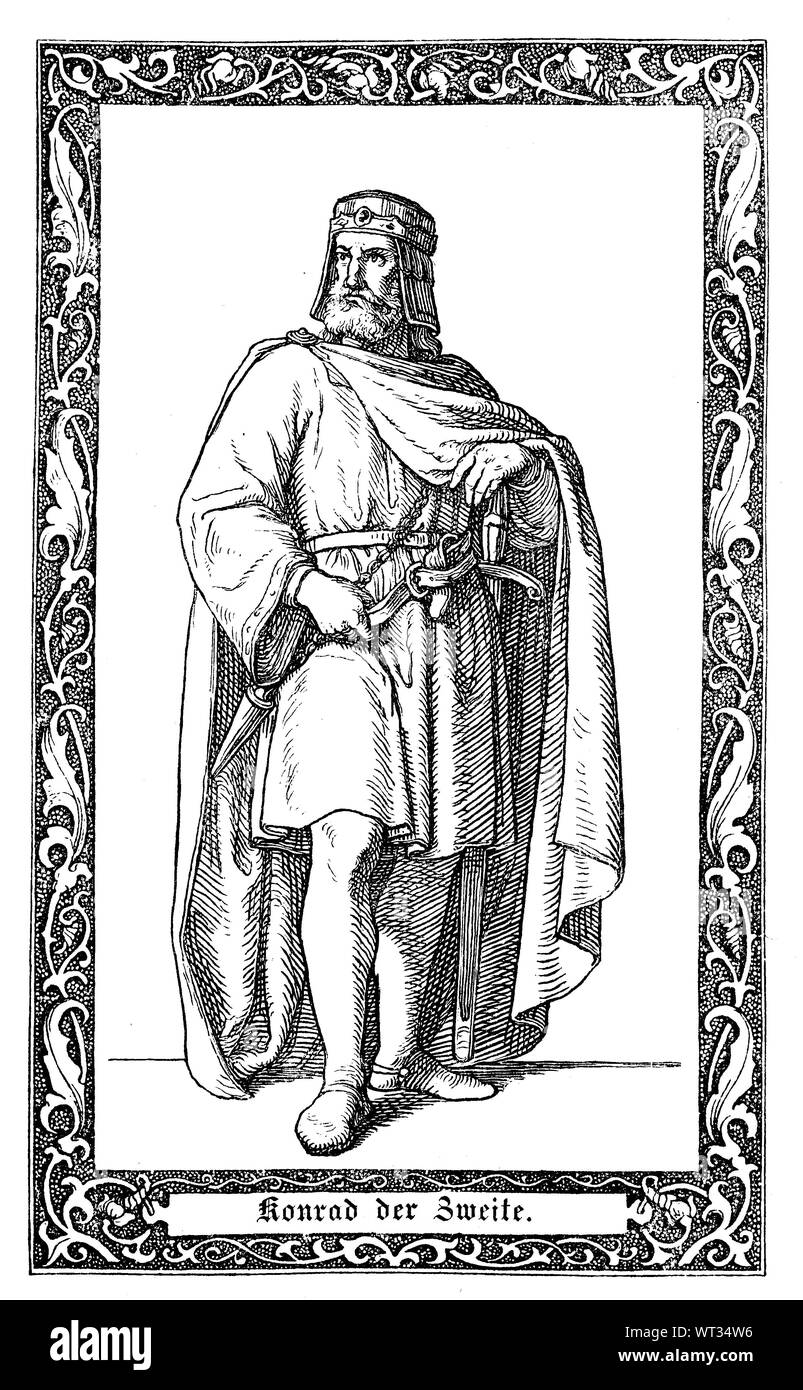 Conrad II., also known as Conrad the Elder and Conrad the Salic, was Emperor of the Holy Roman Empire from 1027 until his death in 1039. Konrad II., Konrad der Ältere, 990-1039, römisch-deutscher Kaiser von 1027 bis 1039, Digital improved reproduction of an illustration from the 19th century Stock Photohttps://www.alamy.com/image-license-details/?v=1https://www.alamy.com/conrad-ii-also-known-as-conrad-the-elder-and-conrad-the-salic-was-emperor-of-the-holy-roman-empire-from-1027-until-his-death-in-1039-konrad-ii-konrad-der-ltere-990-1039-rmisch-deutscher-kaiser-von-1027-bis-1039-digital-improved-reproduction-of-an-illustration-from-the-19th-century-image272976962.html
Conrad II., also known as Conrad the Elder and Conrad the Salic, was Emperor of the Holy Roman Empire from 1027 until his death in 1039. Konrad II., Konrad der Ältere, 990-1039, römisch-deutscher Kaiser von 1027 bis 1039, Digital improved reproduction of an illustration from the 19th century Stock Photohttps://www.alamy.com/image-license-details/?v=1https://www.alamy.com/conrad-ii-also-known-as-conrad-the-elder-and-conrad-the-salic-was-emperor-of-the-holy-roman-empire-from-1027-until-his-death-in-1039-konrad-ii-konrad-der-ltere-990-1039-rmisch-deutscher-kaiser-von-1027-bis-1039-digital-improved-reproduction-of-an-illustration-from-the-19th-century-image272976962.htmlRFWT34W6–Conrad II., also known as Conrad the Elder and Conrad the Salic, was Emperor of the Holy Roman Empire from 1027 until his death in 1039. Konrad II., Konrad der Ältere, 990-1039, römisch-deutscher Kaiser von 1027 bis 1039, Digital improved reproduction of an illustration from the 19th century
 heraldry, symbols, Imperial insignia, emperor of the Holy Roman Empire of the German Empire with coronation regalia, after copper engraving from 1579, wood engraving by Bisson and Cottaro, 19th century, , Stock Photohttps://www.alamy.com/image-license-details/?v=1https://www.alamy.com/stock-photo-heraldry-symbols-imperial-insignia-emperor-of-the-holy-roman-empire-28829846.html
heraldry, symbols, Imperial insignia, emperor of the Holy Roman Empire of the German Empire with coronation regalia, after copper engraving from 1579, wood engraving by Bisson and Cottaro, 19th century, , Stock Photohttps://www.alamy.com/image-license-details/?v=1https://www.alamy.com/stock-photo-heraldry-symbols-imperial-insignia-emperor-of-the-holy-roman-empire-28829846.htmlRMBJW8NA–heraldry, symbols, Imperial insignia, emperor of the Holy Roman Empire of the German Empire with coronation regalia, after copper engraving from 1579, wood engraving by Bisson and Cottaro, 19th century, ,
 Charlemagne (742-814). King of the Franks (768-814), king of the Lombards (774-814), and emperor of the Holy Roman Empire (800-814). Charlemagne holding the globus cruciger in one hand and the sword in the other. Motto shown around the sword: In scelus exurgo, sceleris discrimina purgo. Engraving from a miniature in 'Registres de l'Université de Paris'. 'Moeurs, usages et costumes au moyen-âge et à l'époque de la Renaissance', by Paul Lacroix. Paris, 1878. Stock Photohttps://www.alamy.com/image-license-details/?v=1https://www.alamy.com/charlemagne-742-814-king-of-the-franks-768-814-king-of-the-lombards-774-814-and-emperor-of-the-holy-roman-empire-800-814-charlemagne-holding-the-globus-cruciger-in-one-hand-and-the-sword-in-the-other-motto-shown-around-the-sword-in-scelus-exurgo-sceleris-discrimina-purgo-engraving-from-a-miniature-in-registres-de-luniversit-de-paris-moeurs-usages-et-costumes-au-moyen-ge-et-lpoque-de-la-renaissance-by-paul-lacroix-paris-1878-image593314255.html
Charlemagne (742-814). King of the Franks (768-814), king of the Lombards (774-814), and emperor of the Holy Roman Empire (800-814). Charlemagne holding the globus cruciger in one hand and the sword in the other. Motto shown around the sword: In scelus exurgo, sceleris discrimina purgo. Engraving from a miniature in 'Registres de l'Université de Paris'. 'Moeurs, usages et costumes au moyen-âge et à l'époque de la Renaissance', by Paul Lacroix. Paris, 1878. Stock Photohttps://www.alamy.com/image-license-details/?v=1https://www.alamy.com/charlemagne-742-814-king-of-the-franks-768-814-king-of-the-lombards-774-814-and-emperor-of-the-holy-roman-empire-800-814-charlemagne-holding-the-globus-cruciger-in-one-hand-and-the-sword-in-the-other-motto-shown-around-the-sword-in-scelus-exurgo-sceleris-discrimina-purgo-engraving-from-a-miniature-in-registres-de-luniversit-de-paris-moeurs-usages-et-costumes-au-moyen-ge-et-lpoque-de-la-renaissance-by-paul-lacroix-paris-1878-image593314255.htmlRM2WD7PAR–Charlemagne (742-814). King of the Franks (768-814), king of the Lombards (774-814), and emperor of the Holy Roman Empire (800-814). Charlemagne holding the globus cruciger in one hand and the sword in the other. Motto shown around the sword: In scelus exurgo, sceleris discrimina purgo. Engraving from a miniature in 'Registres de l'Université de Paris'. 'Moeurs, usages et costumes au moyen-âge et à l'époque de la Renaissance', by Paul Lacroix. Paris, 1878.
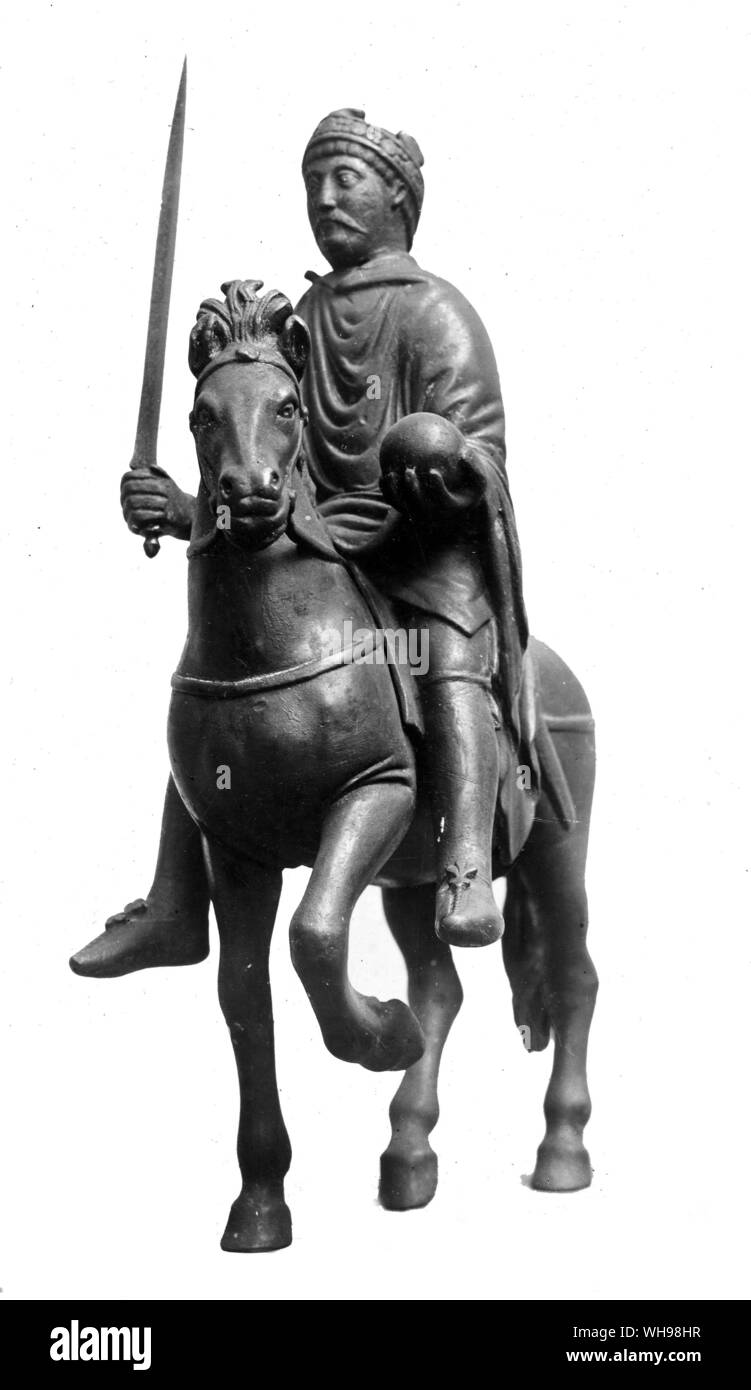 Ancient warfare/ Portrait of Charlemagne, King of the Franks and Emperor of the Holy Roman Empire. 742-814 A.D. Stock Photohttps://www.alamy.com/image-license-details/?v=1https://www.alamy.com/ancient-warfare-portrait-of-charlemagne-king-of-the-franks-and-emperor-of-the-holy-roman-empire-742-814-ad-image268809011.html
Ancient warfare/ Portrait of Charlemagne, King of the Franks and Emperor of the Holy Roman Empire. 742-814 A.D. Stock Photohttps://www.alamy.com/image-license-details/?v=1https://www.alamy.com/ancient-warfare-portrait-of-charlemagne-king-of-the-franks-and-emperor-of-the-holy-roman-empire-742-814-ad-image268809011.htmlRMWH98HR–Ancient warfare/ Portrait of Charlemagne, King of the Franks and Emperor of the Holy Roman Empire. 742-814 A.D.
 Portrait of Joseph II, Emperor of the Holy Roman Empire, ca. 1777 Stock Photohttps://www.alamy.com/image-license-details/?v=1https://www.alamy.com/stock-image-portrait-of-joseph-ii-emperor-of-the-holy-roman-empire-ca-1777-162449161.html
Portrait of Joseph II, Emperor of the Holy Roman Empire, ca. 1777 Stock Photohttps://www.alamy.com/image-license-details/?v=1https://www.alamy.com/stock-image-portrait-of-joseph-ii-emperor-of-the-holy-roman-empire-ca-1777-162449161.htmlRMKC85FN–Portrait of Joseph II, Emperor of the Holy Roman Empire, ca. 1777
 Joos van Cleve Portrait of Maximilian I, Emperor of the Holy Roman Empire Stock Photohttps://www.alamy.com/image-license-details/?v=1https://www.alamy.com/joos-van-cleve-portrait-of-maximilian-i-emperor-of-the-holy-roman-image68880550.html
Joos van Cleve Portrait of Maximilian I, Emperor of the Holy Roman Empire Stock Photohttps://www.alamy.com/image-license-details/?v=1https://www.alamy.com/joos-van-cleve-portrait-of-maximilian-i-emperor-of-the-holy-roman-image68880550.htmlRME01NRJ–Joos van Cleve Portrait of Maximilian I, Emperor of the Holy Roman Empire
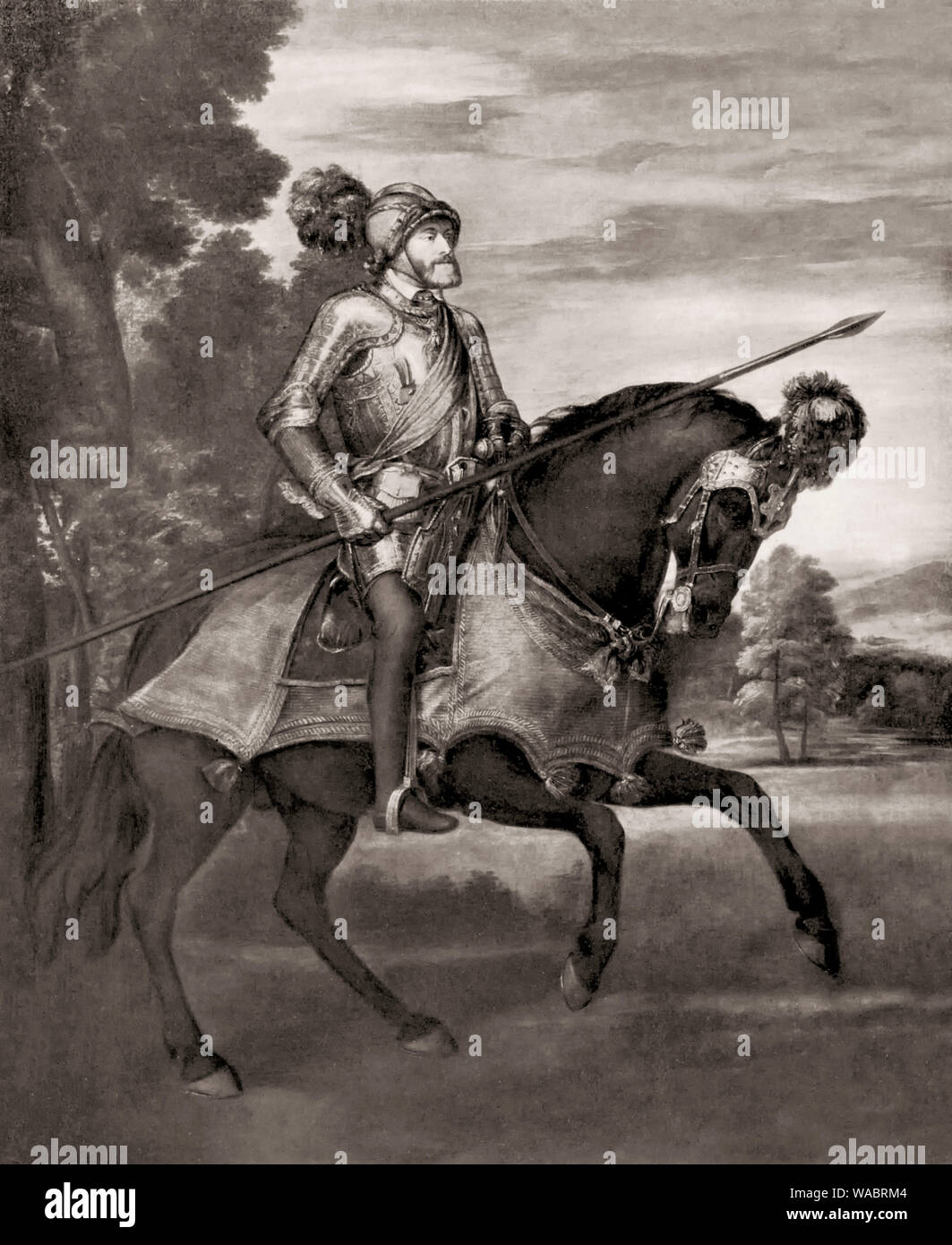 Charles V, 1500 - 1558, Emperor of the Holy Roman Empire, at the Battle of Mühlberg, 1547 Stock Photohttps://www.alamy.com/image-license-details/?v=1https://www.alamy.com/charles-v-1500-1558-emperor-of-the-holy-roman-empire-at-the-battle-of-mhlberg-1547-image264562148.html
Charles V, 1500 - 1558, Emperor of the Holy Roman Empire, at the Battle of Mühlberg, 1547 Stock Photohttps://www.alamy.com/image-license-details/?v=1https://www.alamy.com/charles-v-1500-1558-emperor-of-the-holy-roman-empire-at-the-battle-of-mhlberg-1547-image264562148.htmlRMWABRM4–Charles V, 1500 - 1558, Emperor of the Holy Roman Empire, at the Battle of Mühlberg, 1547
 Bust of Friedrich Barbarossa, Emperor of the Holy Roman Empire of the German Nation Stock Photohttps://www.alamy.com/image-license-details/?v=1https://www.alamy.com/bust-of-friedrich-barbarossa-emperor-of-the-holy-roman-empire-of-the-german-nation-image232622874.html
Bust of Friedrich Barbarossa, Emperor of the Holy Roman Empire of the German Nation Stock Photohttps://www.alamy.com/image-license-details/?v=1https://www.alamy.com/bust-of-friedrich-barbarossa-emperor-of-the-holy-roman-empire-of-the-german-nation-image232622874.htmlRMRECTRP–Bust of Friedrich Barbarossa, Emperor of the Holy Roman Empire of the German Nation
 Austria, Vienna, Kaisergruft, Imperial Burial Vault, resting place of the Hapsburg Royal Family, crypt of Emperor Franz II, last Emperor of the Holy Roman Empire Stock Photohttps://www.alamy.com/image-license-details/?v=1https://www.alamy.com/stock-image-austria-vienna-kaisergruft-imperial-burial-vault-resting-place-of-167086062.html
Austria, Vienna, Kaisergruft, Imperial Burial Vault, resting place of the Hapsburg Royal Family, crypt of Emperor Franz II, last Emperor of the Holy Roman Empire Stock Photohttps://www.alamy.com/image-license-details/?v=1https://www.alamy.com/stock-image-austria-vienna-kaisergruft-imperial-burial-vault-resting-place-of-167086062.htmlRMKKRBYA–Austria, Vienna, Kaisergruft, Imperial Burial Vault, resting place of the Hapsburg Royal Family, crypt of Emperor Franz II, last Emperor of the Holy Roman Empire
 Art inspired by Portrait of Joseph II, Emperor of the Holy Roman Empire, ca. 1777, French, Paris, Wool (154 knots per sq. inch, 25 per sq. cm.), H. 47 x W. 39 inches (119.4 x 99.1 cm), Textiles-Woven, Classic works modernized by Artotop with a splash of modernity. Shapes, color and value, eye-catching visual impact on art. Emotions through freedom of artworks in a contemporary way. A timeless message pursuing a wildly creative new direction. Artists turning to the digital medium and creating the Artotop NFT Stock Photohttps://www.alamy.com/image-license-details/?v=1https://www.alamy.com/art-inspired-by-portrait-of-joseph-ii-emperor-of-the-holy-roman-empire-ca-1777-french-paris-wool-154-knots-per-sq-inch-25-per-sq-cm-h-47-x-w-39-inches-1194-x-991-cm-textiles-woven-classic-works-modernized-by-artotop-with-a-splash-of-modernity-shapes-color-and-value-eye-catching-visual-impact-on-art-emotions-through-freedom-of-artworks-in-a-contemporary-way-a-timeless-message-pursuing-a-wildly-creative-new-direction-artists-turning-to-the-digital-medium-and-creating-the-artotop-nft-image462923096.html
Art inspired by Portrait of Joseph II, Emperor of the Holy Roman Empire, ca. 1777, French, Paris, Wool (154 knots per sq. inch, 25 per sq. cm.), H. 47 x W. 39 inches (119.4 x 99.1 cm), Textiles-Woven, Classic works modernized by Artotop with a splash of modernity. Shapes, color and value, eye-catching visual impact on art. Emotions through freedom of artworks in a contemporary way. A timeless message pursuing a wildly creative new direction. Artists turning to the digital medium and creating the Artotop NFT Stock Photohttps://www.alamy.com/image-license-details/?v=1https://www.alamy.com/art-inspired-by-portrait-of-joseph-ii-emperor-of-the-holy-roman-empire-ca-1777-french-paris-wool-154-knots-per-sq-inch-25-per-sq-cm-h-47-x-w-39-inches-1194-x-991-cm-textiles-woven-classic-works-modernized-by-artotop-with-a-splash-of-modernity-shapes-color-and-value-eye-catching-visual-impact-on-art-emotions-through-freedom-of-artworks-in-a-contemporary-way-a-timeless-message-pursuing-a-wildly-creative-new-direction-artists-turning-to-the-digital-medium-and-creating-the-artotop-nft-image462923096.htmlRF2HW3Y3M–Art inspired by Portrait of Joseph II, Emperor of the Holy Roman Empire, ca. 1777, French, Paris, Wool (154 knots per sq. inch, 25 per sq. cm.), H. 47 x W. 39 inches (119.4 x 99.1 cm), Textiles-Woven, Classic works modernized by Artotop with a splash of modernity. Shapes, color and value, eye-catching visual impact on art. Emotions through freedom of artworks in a contemporary way. A timeless message pursuing a wildly creative new direction. Artists turning to the digital medium and creating the Artotop NFT
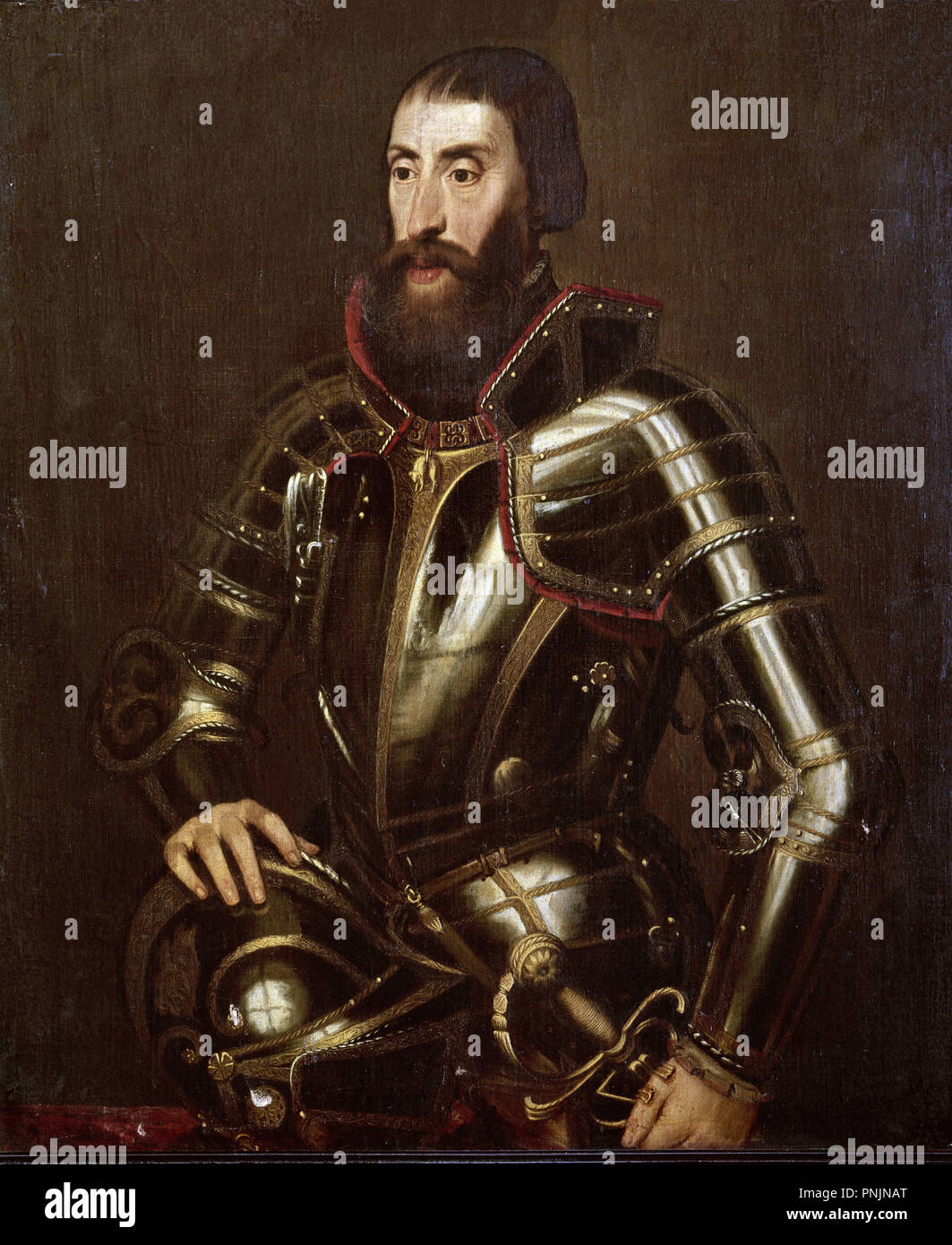 Ferdinand I of Austria (1503-1564). Emperor of the Holy Roman Empire. Hasburg dynasty. Madrid, convent of the Royal Barefoot Nuns (Convento de las Descalzas Reales). Author: MOR, ANTONIS. Location: DESCALZAS REALES-COLECCION. MADRID. SPAIN. Stock Photohttps://www.alamy.com/image-license-details/?v=1https://www.alamy.com/ferdinand-i-of-austria-1503-1564-emperor-of-the-holy-roman-empire-hasburg-dynasty-madrid-convent-of-the-royal-barefoot-nuns-convento-de-las-descalzas-reales-author-mor-antonis-location-descalzas-reales-coleccion-madrid-spain-image219844096.html
Ferdinand I of Austria (1503-1564). Emperor of the Holy Roman Empire. Hasburg dynasty. Madrid, convent of the Royal Barefoot Nuns (Convento de las Descalzas Reales). Author: MOR, ANTONIS. Location: DESCALZAS REALES-COLECCION. MADRID. SPAIN. Stock Photohttps://www.alamy.com/image-license-details/?v=1https://www.alamy.com/ferdinand-i-of-austria-1503-1564-emperor-of-the-holy-roman-empire-hasburg-dynasty-madrid-convent-of-the-royal-barefoot-nuns-convento-de-las-descalzas-reales-author-mor-antonis-location-descalzas-reales-coleccion-madrid-spain-image219844096.htmlRMPNJNAT–Ferdinand I of Austria (1503-1564). Emperor of the Holy Roman Empire. Hasburg dynasty. Madrid, convent of the Royal Barefoot Nuns (Convento de las Descalzas Reales). Author: MOR, ANTONIS. Location: DESCALZAS REALES-COLECCION. MADRID. SPAIN.
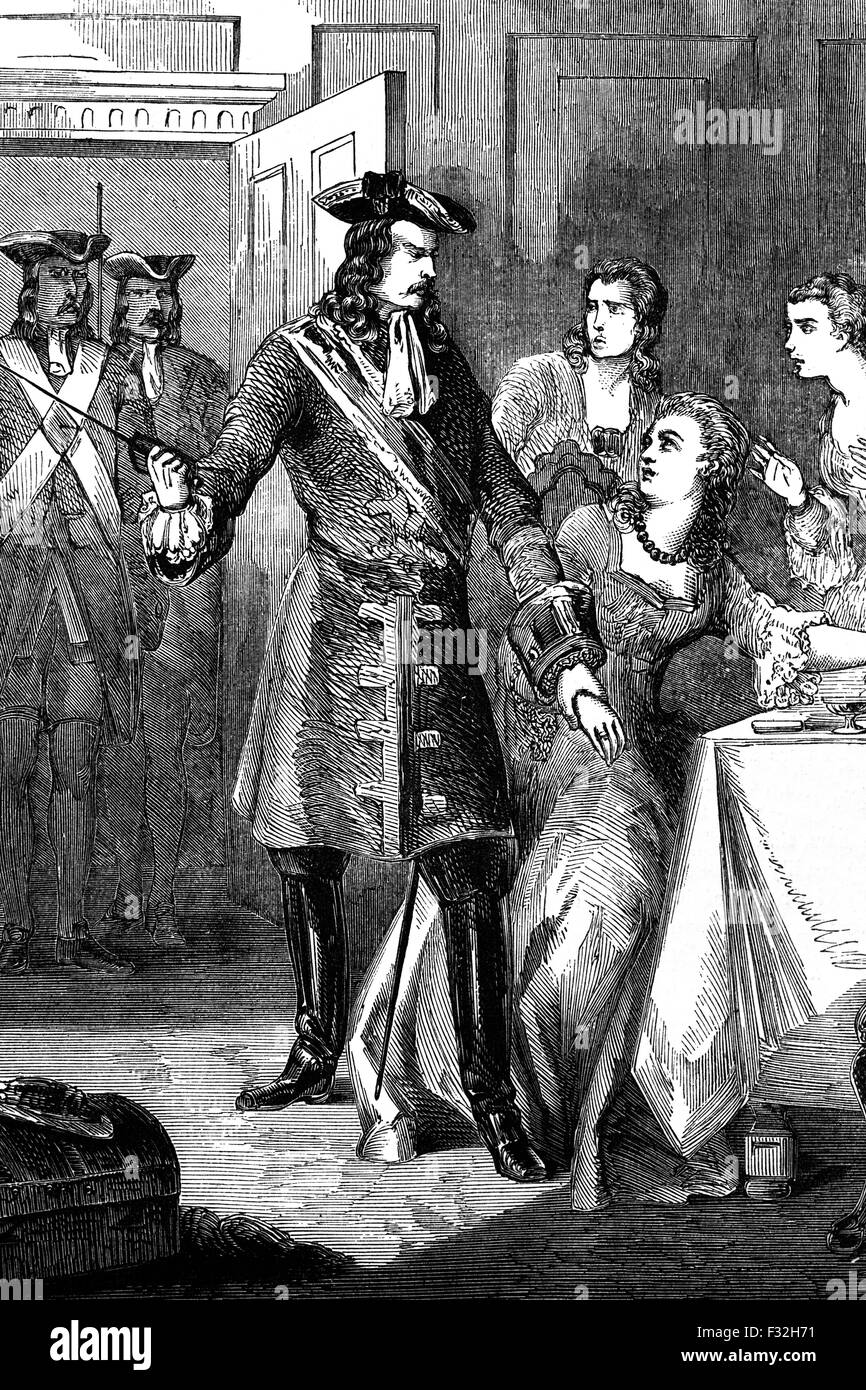 Princess Maria Clementina, who was betrothed to James Francis Edward Stuart. She was arrested and imprisoned in Austria whilst en route for her wedding in Italy on instructions from the Holy Roman Emperor Charles VI to placate King George I of Great Britain who was opposed to the marriage. because he feared that their heirs would lay claim to his throne. Stock Photohttps://www.alamy.com/image-license-details/?v=1https://www.alamy.com/stock-photo-princess-maria-clementina-who-was-betrothed-to-james-francis-edward-87953237.html
Princess Maria Clementina, who was betrothed to James Francis Edward Stuart. She was arrested and imprisoned in Austria whilst en route for her wedding in Italy on instructions from the Holy Roman Emperor Charles VI to placate King George I of Great Britain who was opposed to the marriage. because he feared that their heirs would lay claim to his throne. Stock Photohttps://www.alamy.com/image-license-details/?v=1https://www.alamy.com/stock-photo-princess-maria-clementina-who-was-betrothed-to-james-francis-edward-87953237.htmlRMF32H71–Princess Maria Clementina, who was betrothed to James Francis Edward Stuart. She was arrested and imprisoned in Austria whilst en route for her wedding in Italy on instructions from the Holy Roman Emperor Charles VI to placate King George I of Great Britain who was opposed to the marriage. because he feared that their heirs would lay claim to his throne.
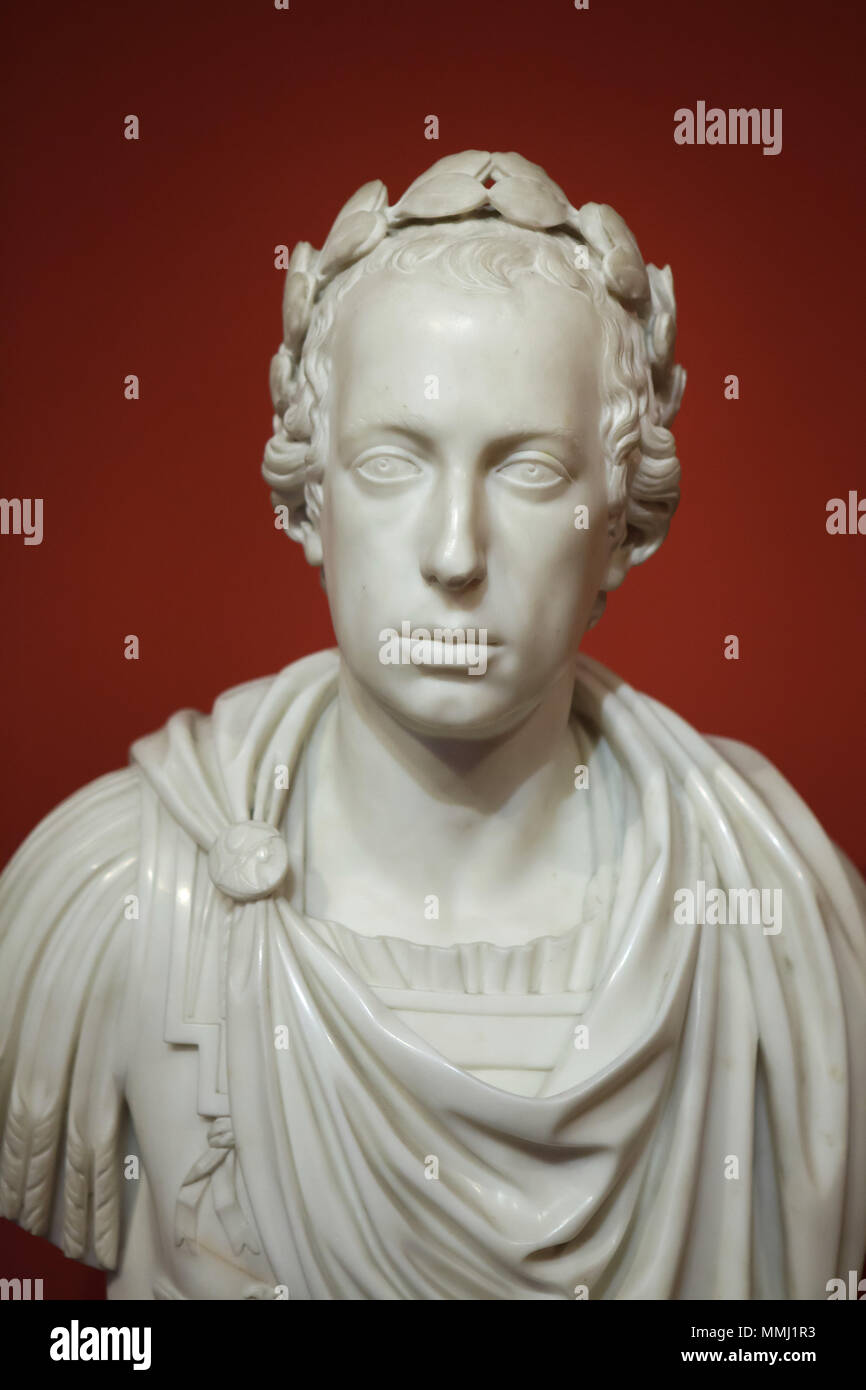 Holy Roman Emperor Francis II (1768 - 1835). Carrara marble bust (1796) by Austrian sculptor Franz Anton von Zauner on display in the Belvedere Museum in Vienna, Austria. Stock Photohttps://www.alamy.com/image-license-details/?v=1https://www.alamy.com/holy-roman-emperor-francis-ii-1768-1835-carrara-marble-bust-1796-by-austrian-sculptor-franz-anton-von-zauner-on-display-in-the-belvedere-museum-in-vienna-austria-image184793367.html
Holy Roman Emperor Francis II (1768 - 1835). Carrara marble bust (1796) by Austrian sculptor Franz Anton von Zauner on display in the Belvedere Museum in Vienna, Austria. Stock Photohttps://www.alamy.com/image-license-details/?v=1https://www.alamy.com/holy-roman-emperor-francis-ii-1768-1835-carrara-marble-bust-1796-by-austrian-sculptor-franz-anton-von-zauner-on-display-in-the-belvedere-museum-in-vienna-austria-image184793367.htmlRMMMJ1R3–Holy Roman Emperor Francis II (1768 - 1835). Carrara marble bust (1796) by Austrian sculptor Franz Anton von Zauner on display in the Belvedere Museum in Vienna, Austria.
 Matthias, Emperor of the Holy Roman Empire, Hans von Aachen (by circle of), 1600-25, German painting, oil on canvas. Matthias was King of Hungary, Croatia, and Bohemia. He was the Governor-General of the Northern Provinces from 1578 until 1581, when they (BSLOC 2016 6 267) Stock Photohttps://www.alamy.com/image-license-details/?v=1https://www.alamy.com/stock-photo-matthias-emperor-of-the-holy-roman-empire-hans-von-aachen-by-circle-115918266.html
Matthias, Emperor of the Holy Roman Empire, Hans von Aachen (by circle of), 1600-25, German painting, oil on canvas. Matthias was King of Hungary, Croatia, and Bohemia. He was the Governor-General of the Northern Provinces from 1578 until 1581, when they (BSLOC 2016 6 267) Stock Photohttps://www.alamy.com/image-license-details/?v=1https://www.alamy.com/stock-photo-matthias-emperor-of-the-holy-roman-empire-hans-von-aachen-by-circle-115918266.htmlRMGMGEX2–Matthias, Emperor of the Holy Roman Empire, Hans von Aachen (by circle of), 1600-25, German painting, oil on canvas. Matthias was King of Hungary, Croatia, and Bohemia. He was the Governor-General of the Northern Provinces from 1578 until 1581, when they (BSLOC 2016 6 267)
 Heraldic Arms, Westminster Abbey, London - North Aisle, I - Emperor of the Holy Roman Empire, Frederick II. Stock Photohttps://www.alamy.com/image-license-details/?v=1https://www.alamy.com/heraldic-arms-westminster-abbey-london-north-aisle-i-emperor-of-the-holy-roman-empire-frederick-ii-image504821914.html
Heraldic Arms, Westminster Abbey, London - North Aisle, I - Emperor of the Holy Roman Empire, Frederick II. Stock Photohttps://www.alamy.com/image-license-details/?v=1https://www.alamy.com/heraldic-arms-westminster-abbey-london-north-aisle-i-emperor-of-the-holy-roman-empire-frederick-ii-image504821914.htmlRM2M98HE2–Heraldic Arms, Westminster Abbey, London - North Aisle, I - Emperor of the Holy Roman Empire, Frederick II.
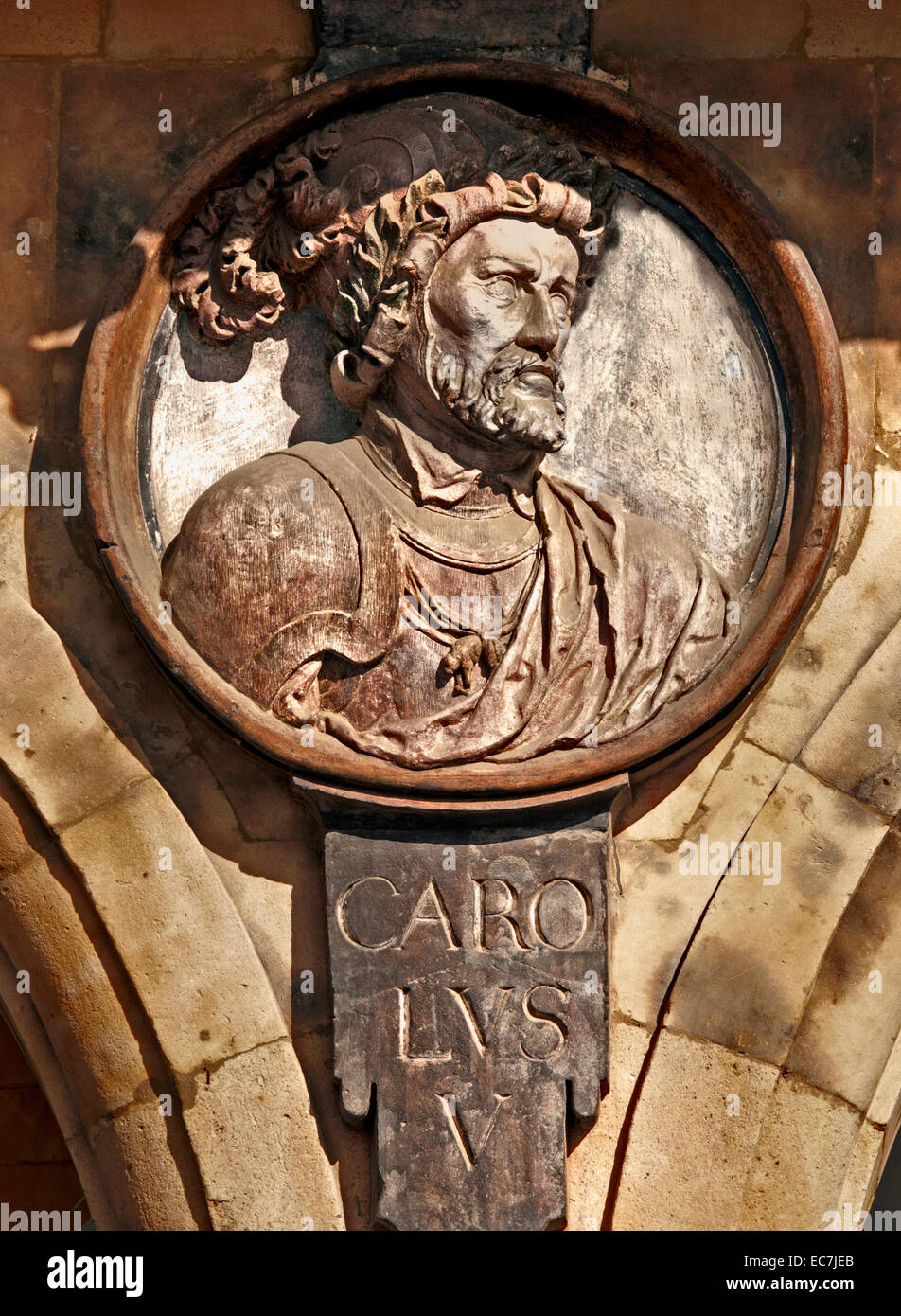 Carolus V - Charles V 1500 – 1558 Emperor of the Holy Roman Empire from 1519 and King of the Spanish realms 1516 until his abdication in 1556. Spain ( Plaza Mayor Square Salamanca ) Stock Photohttps://www.alamy.com/image-license-details/?v=1https://www.alamy.com/stock-photo-carolus-v-charles-v-1500-1558-emperor-of-the-holy-roman-empire-from-76385523.html
Carolus V - Charles V 1500 – 1558 Emperor of the Holy Roman Empire from 1519 and King of the Spanish realms 1516 until his abdication in 1556. Spain ( Plaza Mayor Square Salamanca ) Stock Photohttps://www.alamy.com/image-license-details/?v=1https://www.alamy.com/stock-photo-carolus-v-charles-v-1500-1558-emperor-of-the-holy-roman-empire-from-76385523.htmlRMEC7JEB–Carolus V - Charles V 1500 – 1558 Emperor of the Holy Roman Empire from 1519 and King of the Spanish realms 1516 until his abdication in 1556. Spain ( Plaza Mayor Square Salamanca )
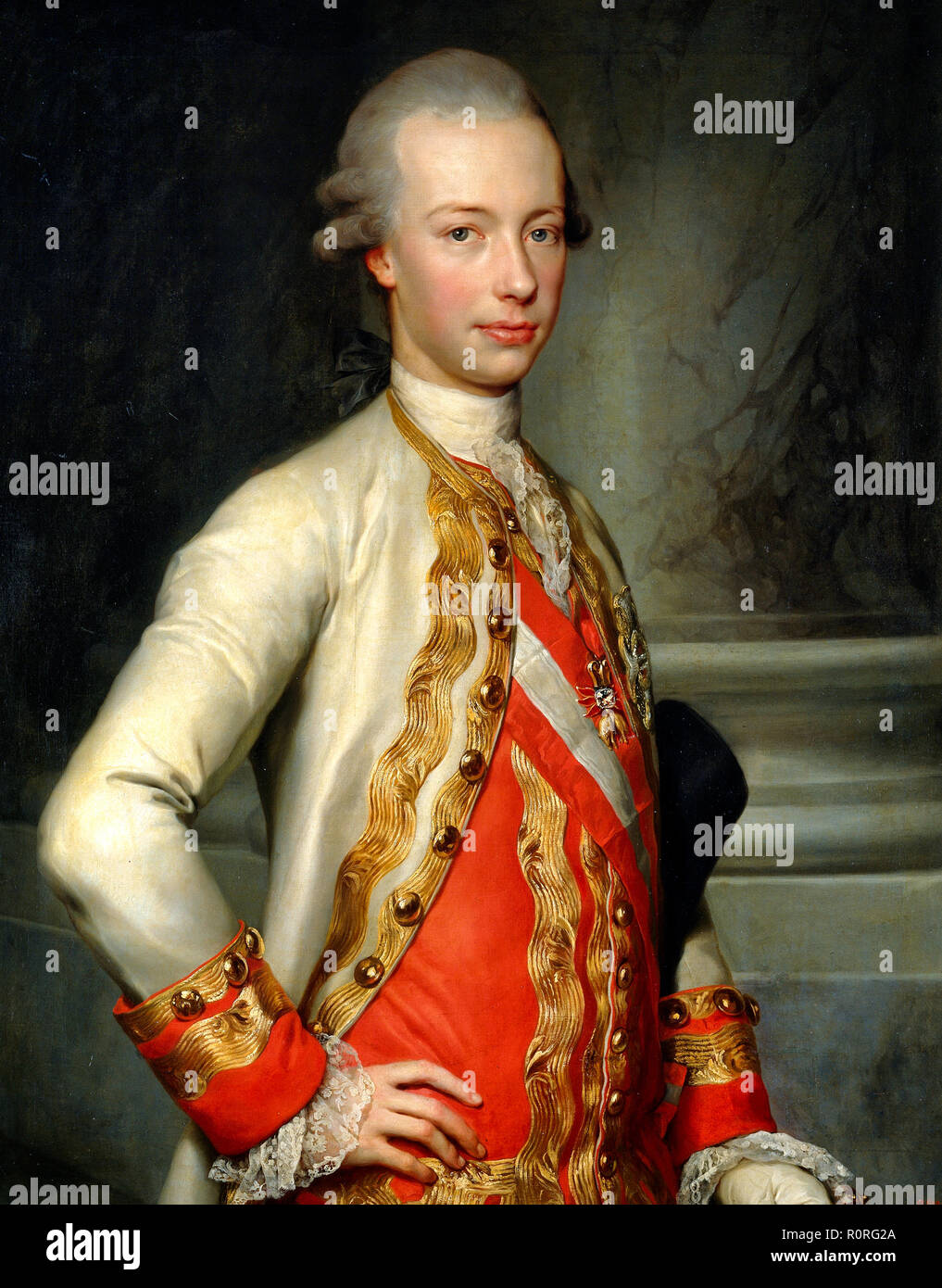 Portrait of Archduke Leopold of Lorraine (1747-1792), who became Grand Duke of Tuscany and later Emperor of the Holy Roman Empire. Pompeo Batoni, circa 1769 Stock Photohttps://www.alamy.com/image-license-details/?v=1https://www.alamy.com/portrait-of-archduke-leopold-of-lorraine-1747-1792-who-became-grand-duke-of-tuscany-and-later-emperor-of-the-holy-roman-empire-pompeo-batoni-circa-1769-image224252290.html
Portrait of Archduke Leopold of Lorraine (1747-1792), who became Grand Duke of Tuscany and later Emperor of the Holy Roman Empire. Pompeo Batoni, circa 1769 Stock Photohttps://www.alamy.com/image-license-details/?v=1https://www.alamy.com/portrait-of-archduke-leopold-of-lorraine-1747-1792-who-became-grand-duke-of-tuscany-and-later-emperor-of-the-holy-roman-empire-pompeo-batoni-circa-1769-image224252290.htmlRMR0RG2A–Portrait of Archduke Leopold of Lorraine (1747-1792), who became Grand Duke of Tuscany and later Emperor of the Holy Roman Empire. Pompeo Batoni, circa 1769
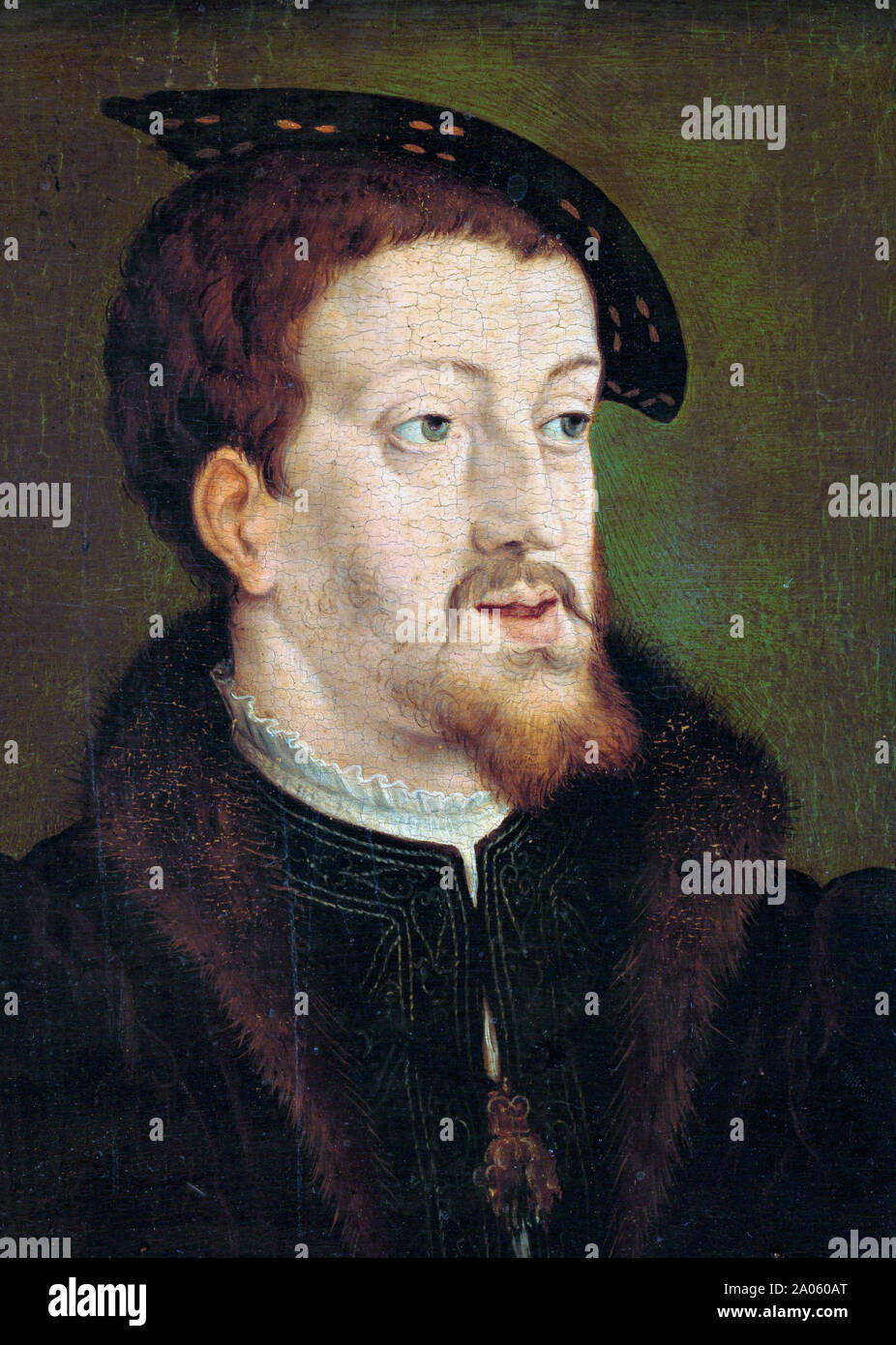 Charles V, 1500-1558. Emperor of the Holy Roman Empire. Carlos V. King of Spain as Charles I. Carlos I. After a painting in the Rijksmuseum, Amsterdam, Netherlands in the manner of Jan Cornelisz Vermeyen. Stock Photohttps://www.alamy.com/image-license-details/?v=1https://www.alamy.com/charles-v-1500-1558-emperor-of-the-holy-roman-empire-carlos-v-king-of-spain-as-charles-i-carlos-i-after-a-painting-in-the-rijksmuseum-amsterdam-netherlands-in-the-manner-of-jan-cornelisz-vermeyen-image327129008.html
Charles V, 1500-1558. Emperor of the Holy Roman Empire. Carlos V. King of Spain as Charles I. Carlos I. After a painting in the Rijksmuseum, Amsterdam, Netherlands in the manner of Jan Cornelisz Vermeyen. Stock Photohttps://www.alamy.com/image-license-details/?v=1https://www.alamy.com/charles-v-1500-1558-emperor-of-the-holy-roman-empire-carlos-v-king-of-spain-as-charles-i-carlos-i-after-a-painting-in-the-rijksmuseum-amsterdam-netherlands-in-the-manner-of-jan-cornelisz-vermeyen-image327129008.htmlRM2A060AT–Charles V, 1500-1558. Emperor of the Holy Roman Empire. Carlos V. King of Spain as Charles I. Carlos I. After a painting in the Rijksmuseum, Amsterdam, Netherlands in the manner of Jan Cornelisz Vermeyen.
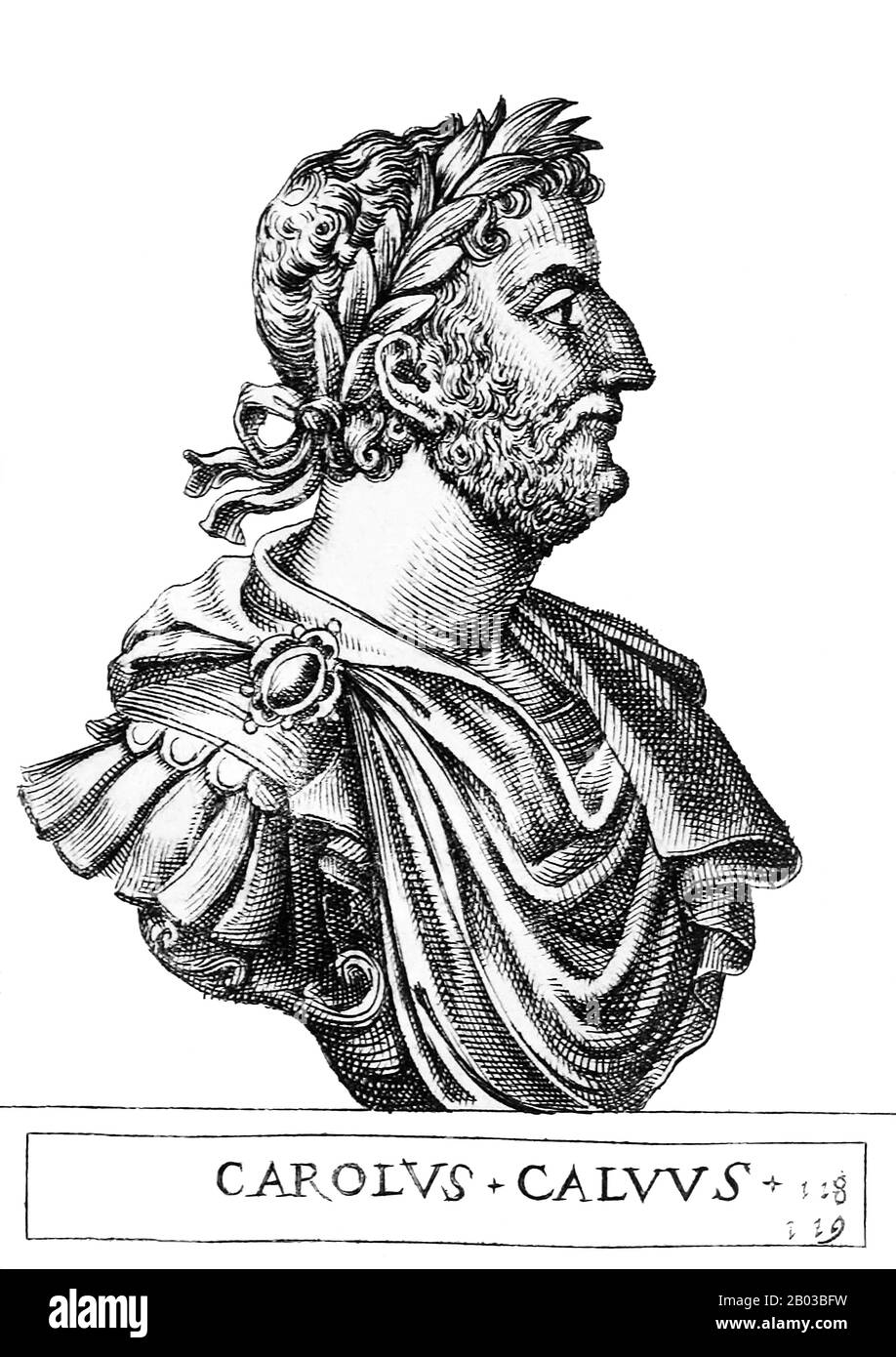 Charles II (823-877), more commonly nicknamed Charles the Bald, was the son of Emperor Louis the Pious from his second wife. When Emperor Louis II died in 875, Charles became emperor of the Holy Roman Empire. Stock Photohttps://www.alamy.com/image-license-details/?v=1https://www.alamy.com/charles-ii-823-877-more-commonly-nicknamed-charles-the-bald-was-the-son-of-emperor-louis-the-pious-from-his-second-wife-when-emperor-louis-ii-died-in-875-charles-became-emperor-of-the-holy-roman-empire-image344282285.html
Charles II (823-877), more commonly nicknamed Charles the Bald, was the son of Emperor Louis the Pious from his second wife. When Emperor Louis II died in 875, Charles became emperor of the Holy Roman Empire. Stock Photohttps://www.alamy.com/image-license-details/?v=1https://www.alamy.com/charles-ii-823-877-more-commonly-nicknamed-charles-the-bald-was-the-son-of-emperor-louis-the-pious-from-his-second-wife-when-emperor-louis-ii-died-in-875-charles-became-emperor-of-the-holy-roman-empire-image344282285.htmlRM2B03BFW–Charles II (823-877), more commonly nicknamed Charles the Bald, was the son of Emperor Louis the Pious from his second wife. When Emperor Louis II died in 875, Charles became emperor of the Holy Roman Empire.
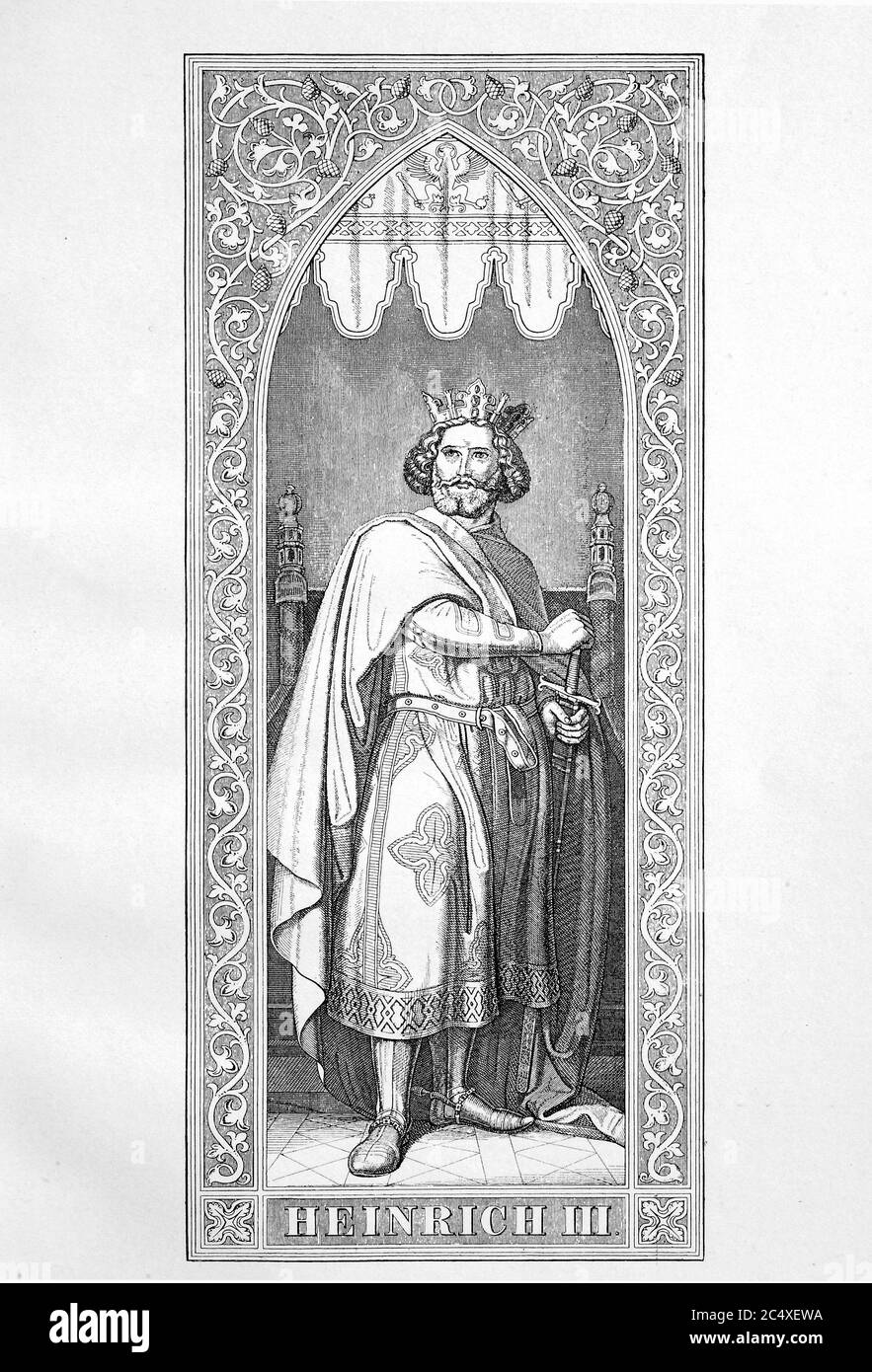 Henry III. (* October 28, 1016; † October 5, 1056) was from the family of Salian of 1039 until his death in 1056 King and since 1046 emperor in the Holy Roman Empire / Heinrich III. (* 28. Oktober 1016; † 5. Oktober 1056) aus der Familie der Salier war von 1039 bis zu seinem Tod 1056 Koenig und seit 1046 Kaiser im roemisch-deutschen Reich, historical, digital improved reproduction of an original from the 19th century / digitale Reproduktion einer Originalvorlage aus dem 19. Jahrhundert Stock Photohttps://www.alamy.com/image-license-details/?v=1https://www.alamy.com/henry-iii-october-28-1016-october-5-1056-was-from-the-family-of-salian-of-1039-until-his-death-in-1056-king-and-since-1046-emperor-in-the-holy-roman-empire-heinrich-iii-28-oktober-1016-5-oktober-1056-aus-der-familie-der-salier-war-von-1039-bis-zu-seinem-tod-1056-koenig-und-seit-1046-kaiser-im-roemisch-deutschen-reich-historical-digital-improved-reproduction-of-an-original-from-the-19th-century-digitale-reproduktion-einer-originalvorlage-aus-dem-19-jahrhundert-image364458790.html
Henry III. (* October 28, 1016; † October 5, 1056) was from the family of Salian of 1039 until his death in 1056 King and since 1046 emperor in the Holy Roman Empire / Heinrich III. (* 28. Oktober 1016; † 5. Oktober 1056) aus der Familie der Salier war von 1039 bis zu seinem Tod 1056 Koenig und seit 1046 Kaiser im roemisch-deutschen Reich, historical, digital improved reproduction of an original from the 19th century / digitale Reproduktion einer Originalvorlage aus dem 19. Jahrhundert Stock Photohttps://www.alamy.com/image-license-details/?v=1https://www.alamy.com/henry-iii-october-28-1016-october-5-1056-was-from-the-family-of-salian-of-1039-until-his-death-in-1056-king-and-since-1046-emperor-in-the-holy-roman-empire-heinrich-iii-28-oktober-1016-5-oktober-1056-aus-der-familie-der-salier-war-von-1039-bis-zu-seinem-tod-1056-koenig-und-seit-1046-kaiser-im-roemisch-deutschen-reich-historical-digital-improved-reproduction-of-an-original-from-the-19th-century-digitale-reproduktion-einer-originalvorlage-aus-dem-19-jahrhundert-image364458790.htmlRF2C4XEWA–Henry III. (* October 28, 1016; † October 5, 1056) was from the family of Salian of 1039 until his death in 1056 King and since 1046 emperor in the Holy Roman Empire / Heinrich III. (* 28. Oktober 1016; † 5. Oktober 1056) aus der Familie der Salier war von 1039 bis zu seinem Tod 1056 Koenig und seit 1046 Kaiser im roemisch-deutschen Reich, historical, digital improved reproduction of an original from the 19th century / digitale Reproduktion einer Originalvorlage aus dem 19. Jahrhundert
 mining, silver, legend of the discovery of silver on the Rammelsberg mountain near Goslar, wood engraving, after drawing by Friedrich Hottenroth, 19th century, Middle Ages, discovery, chance, coincidence, vein of silver, horse, horses, followers, emperor Otto I, Holy Roman Empire, 10th century, lance, lances, spear, spears, metal, metals, historic, historical, find, medieval, people, Additional-Rights-Clearences-Not Available Stock Photohttps://www.alamy.com/image-license-details/?v=1https://www.alamy.com/stock-photo-mining-silver-legend-of-the-discovery-of-silver-on-the-rammelsberg-96388860.html
mining, silver, legend of the discovery of silver on the Rammelsberg mountain near Goslar, wood engraving, after drawing by Friedrich Hottenroth, 19th century, Middle Ages, discovery, chance, coincidence, vein of silver, horse, horses, followers, emperor Otto I, Holy Roman Empire, 10th century, lance, lances, spear, spears, metal, metals, historic, historical, find, medieval, people, Additional-Rights-Clearences-Not Available Stock Photohttps://www.alamy.com/image-license-details/?v=1https://www.alamy.com/stock-photo-mining-silver-legend-of-the-discovery-of-silver-on-the-rammelsberg-96388860.htmlRMFGPTY8–mining, silver, legend of the discovery of silver on the Rammelsberg mountain near Goslar, wood engraving, after drawing by Friedrich Hottenroth, 19th century, Middle Ages, discovery, chance, coincidence, vein of silver, horse, horses, followers, emperor Otto I, Holy Roman Empire, 10th century, lance, lances, spear, spears, metal, metals, historic, historical, find, medieval, people, Additional-Rights-Clearences-Not Available
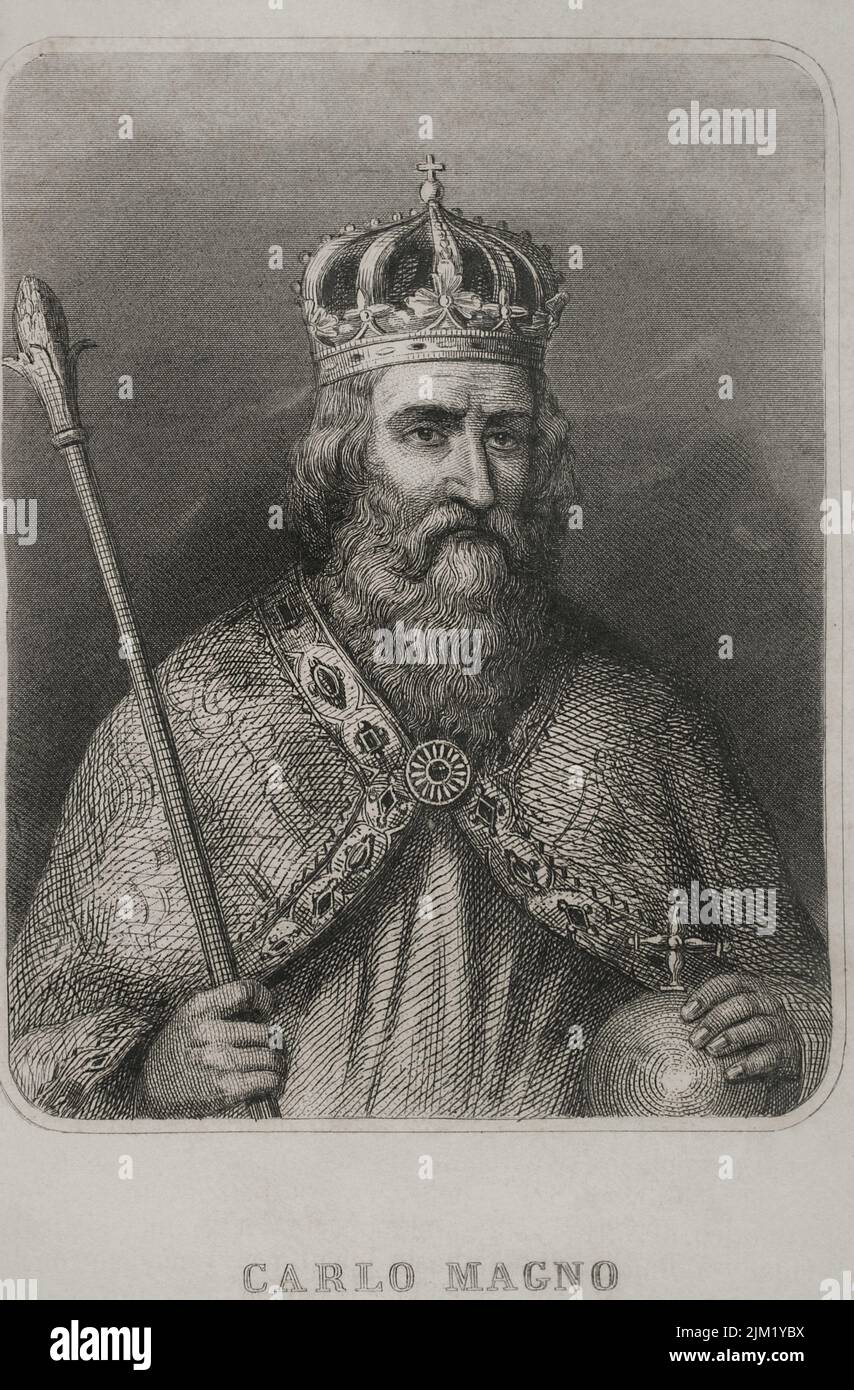 Charlemagne (742-814). King of the Franks (768-814), king of the Lombards (774-814), and emperor of the Holy Roman Empire (800-814). Portrait. Engraving. 'Historia Universal', by César Cantú. Volume III, 1855. Stock Photohttps://www.alamy.com/image-license-details/?v=1https://www.alamy.com/charlemagne-742-814-king-of-the-franks-768-814-king-of-the-lombards-774-814-and-emperor-of-the-holy-roman-empire-800-814-portrait-engraving-historia-universal-by-csar-cant-volume-iii-1855-image477016510.html
Charlemagne (742-814). King of the Franks (768-814), king of the Lombards (774-814), and emperor of the Holy Roman Empire (800-814). Portrait. Engraving. 'Historia Universal', by César Cantú. Volume III, 1855. Stock Photohttps://www.alamy.com/image-license-details/?v=1https://www.alamy.com/charlemagne-742-814-king-of-the-franks-768-814-king-of-the-lombards-774-814-and-emperor-of-the-holy-roman-empire-800-814-portrait-engraving-historia-universal-by-csar-cant-volume-iii-1855-image477016510.htmlRM2JM1YBX–Charlemagne (742-814). King of the Franks (768-814), king of the Lombards (774-814), and emperor of the Holy Roman Empire (800-814). Portrait. Engraving. 'Historia Universal', by César Cantú. Volume III, 1855.
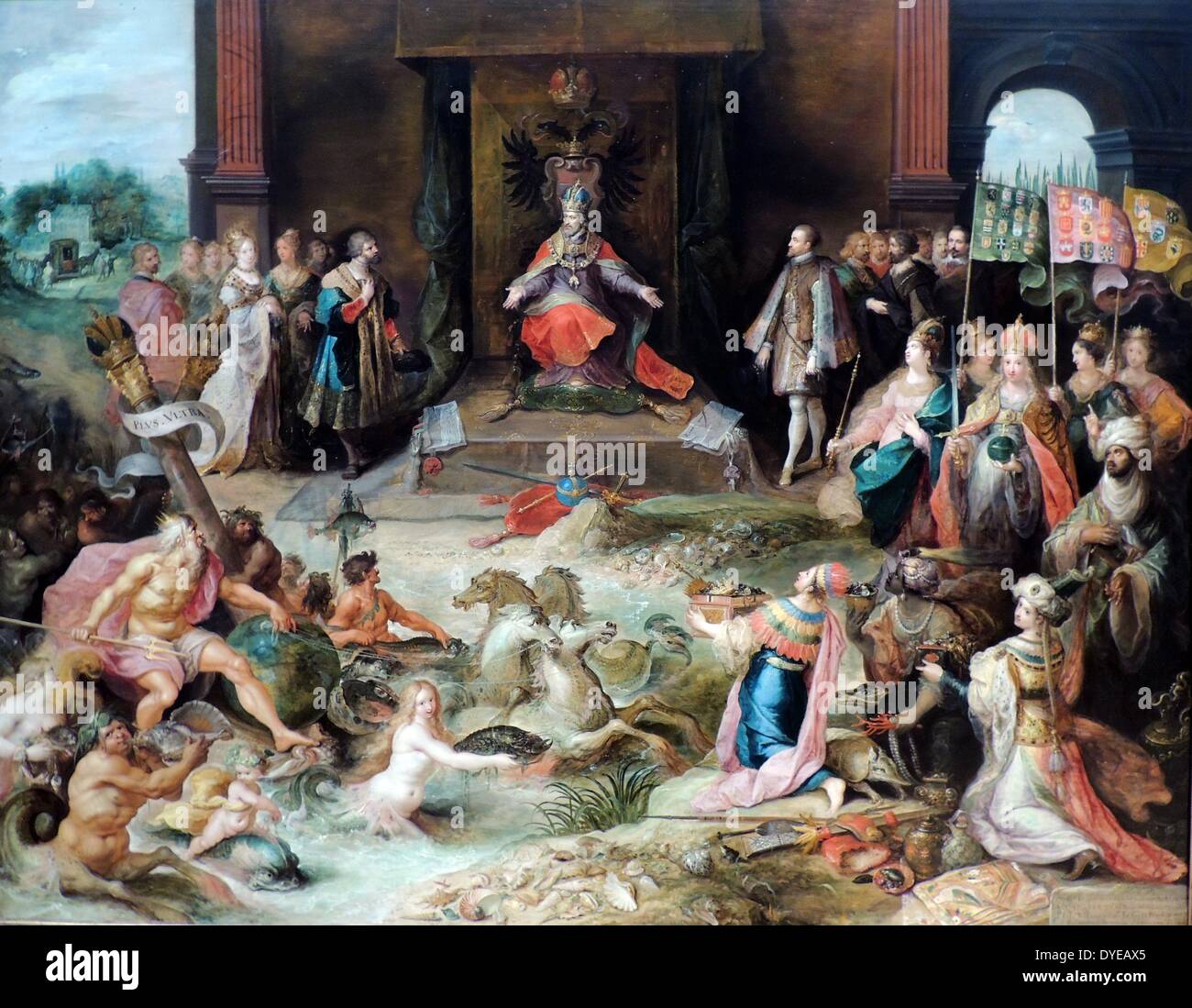 Allegory on the Abdication of Emperor Charles V in Brussels. Frans Francken II (1581-1642) oil on panel, (c 1630-1640) Charles V is enthroned at centre. Battle weary and wracked by illness, in 1555 he divided up his empire. He gave his brother Ferdinand (left of the throne) the Holy Roman Empire, while his son Phillip (at the right) became King of Spain and Lord of the Netherlands. The four figures in the right foreground personify the continents over which Charles's vast empire stretched. Neptune (left) symbolized his power at sea. Stock Photohttps://www.alamy.com/image-license-details/?v=1https://www.alamy.com/allegory-on-the-abdication-of-emperor-charles-v-in-brussels-frans-image68542717.html
Allegory on the Abdication of Emperor Charles V in Brussels. Frans Francken II (1581-1642) oil on panel, (c 1630-1640) Charles V is enthroned at centre. Battle weary and wracked by illness, in 1555 he divided up his empire. He gave his brother Ferdinand (left of the throne) the Holy Roman Empire, while his son Phillip (at the right) became King of Spain and Lord of the Netherlands. The four figures in the right foreground personify the continents over which Charles's vast empire stretched. Neptune (left) symbolized his power at sea. Stock Photohttps://www.alamy.com/image-license-details/?v=1https://www.alamy.com/allegory-on-the-abdication-of-emperor-charles-v-in-brussels-frans-image68542717.htmlRMDYEAX5–Allegory on the Abdication of Emperor Charles V in Brussels. Frans Francken II (1581-1642) oil on panel, (c 1630-1640) Charles V is enthroned at centre. Battle weary and wracked by illness, in 1555 he divided up his empire. He gave his brother Ferdinand (left of the throne) the Holy Roman Empire, while his son Phillip (at the right) became King of Spain and Lord of the Netherlands. The four figures in the right foreground personify the continents over which Charles's vast empire stretched. Neptune (left) symbolized his power at sea.
 Rudolph II (1552–1612), Emperor of the Holy Roman Empire, German, Tyrol, 1604, German, Tyrol, Silver, Diameter: 1 13/16 in. (46 mm.), Coins Stock Photohttps://www.alamy.com/image-license-details/?v=1https://www.alamy.com/rudolph-ii-15521612-emperor-of-the-holy-roman-empire-german-tyrol-1604-german-tyrol-silver-diameter-1-1316-in-46-mm-coins-image344672746.html
Rudolph II (1552–1612), Emperor of the Holy Roman Empire, German, Tyrol, 1604, German, Tyrol, Silver, Diameter: 1 13/16 in. (46 mm.), Coins Stock Photohttps://www.alamy.com/image-license-details/?v=1https://www.alamy.com/rudolph-ii-15521612-emperor-of-the-holy-roman-empire-german-tyrol-1604-german-tyrol-silver-diameter-1-1316-in-46-mm-coins-image344672746.htmlRM2B0N5GX–Rudolph II (1552–1612), Emperor of the Holy Roman Empire, German, Tyrol, 1604, German, Tyrol, Silver, Diameter: 1 13/16 in. (46 mm.), Coins
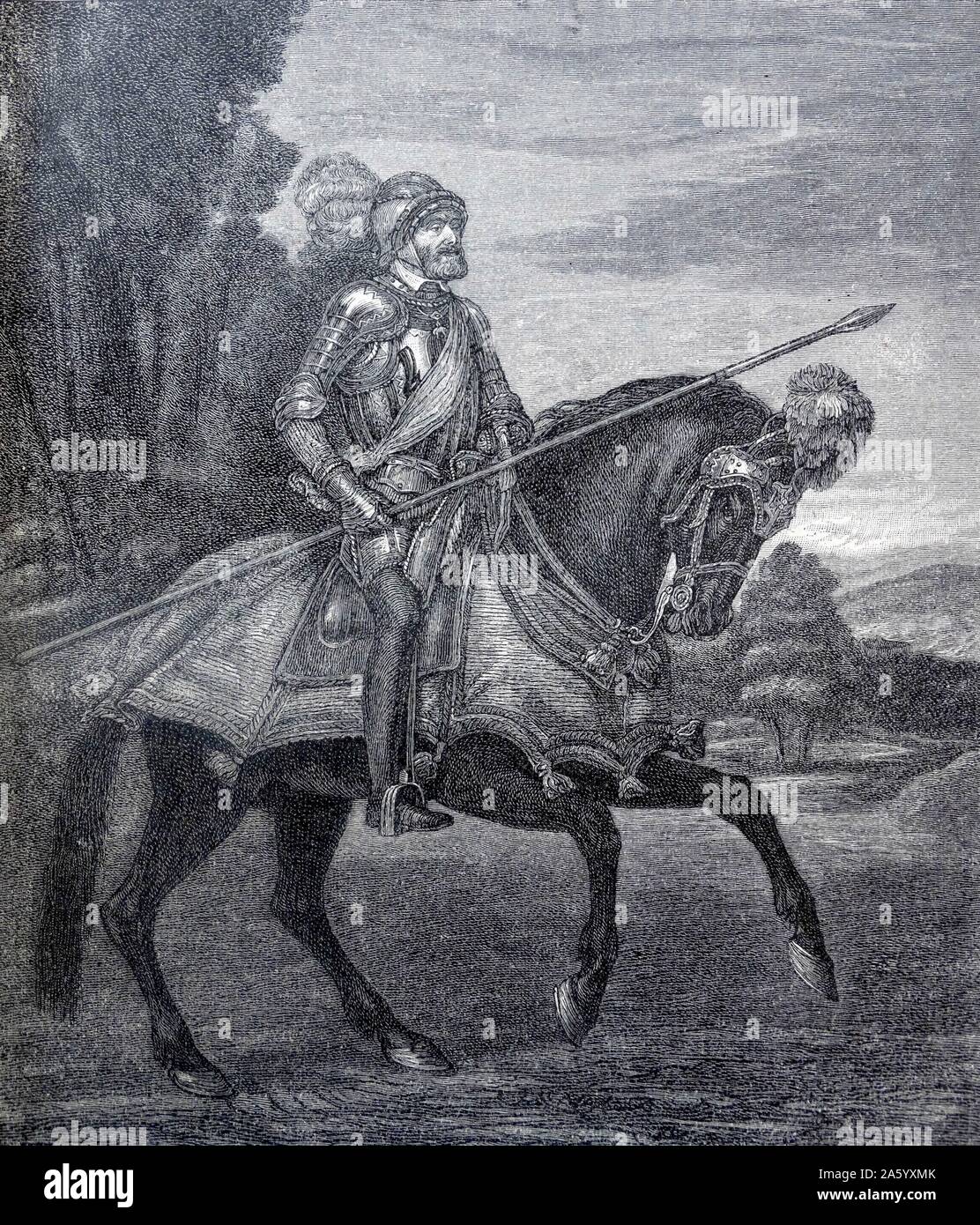 Charles V also known as Charles I (Carlos I) (1500 – 1558), King of Spain and Emperor of the Spanish Empire from 1516. later, as Charles V he was ruler of the Holy Roman Empire from 1519 until 1556.Charles V on Horseback in Mühlberg by Titian. 1548 Stock Photohttps://www.alamy.com/image-license-details/?v=1https://www.alamy.com/charles-v-also-known-as-charles-i-carlos-i-1500-1558-king-of-spain-and-emperor-of-the-spanish-empire-from-1516-later-as-charles-v-he-was-ruler-of-the-holy-roman-empire-from-1519-until-1556charles-v-on-horseback-in-mhlberg-by-titian-1548-image330683939.html
Charles V also known as Charles I (Carlos I) (1500 – 1558), King of Spain and Emperor of the Spanish Empire from 1516. later, as Charles V he was ruler of the Holy Roman Empire from 1519 until 1556.Charles V on Horseback in Mühlberg by Titian. 1548 Stock Photohttps://www.alamy.com/image-license-details/?v=1https://www.alamy.com/charles-v-also-known-as-charles-i-carlos-i-1500-1558-king-of-spain-and-emperor-of-the-spanish-empire-from-1516-later-as-charles-v-he-was-ruler-of-the-holy-roman-empire-from-1519-until-1556charles-v-on-horseback-in-mhlberg-by-titian-1548-image330683939.htmlRM2A5YXMK–Charles V also known as Charles I (Carlos I) (1500 – 1558), King of Spain and Emperor of the Spanish Empire from 1516. later, as Charles V he was ruler of the Holy Roman Empire from 1519 until 1556.Charles V on Horseback in Mühlberg by Titian. 1548
 Historical drawing of the 19 th century, Matthias, 1557-1617, Emperor of the Holy Roman Empire Stock Photohttps://www.alamy.com/image-license-details/?v=1https://www.alamy.com/stock-photo-historical-drawing-of-the-19-th-century-matthias-1557-1617-emperor-43134909.html
Historical drawing of the 19 th century, Matthias, 1557-1617, Emperor of the Holy Roman Empire Stock Photohttps://www.alamy.com/image-license-details/?v=1https://www.alamy.com/stock-photo-historical-drawing-of-the-19-th-century-matthias-1557-1617-emperor-43134909.htmlRMCE4Y0D–Historical drawing of the 19 th century, Matthias, 1557-1617, Emperor of the Holy Roman Empire
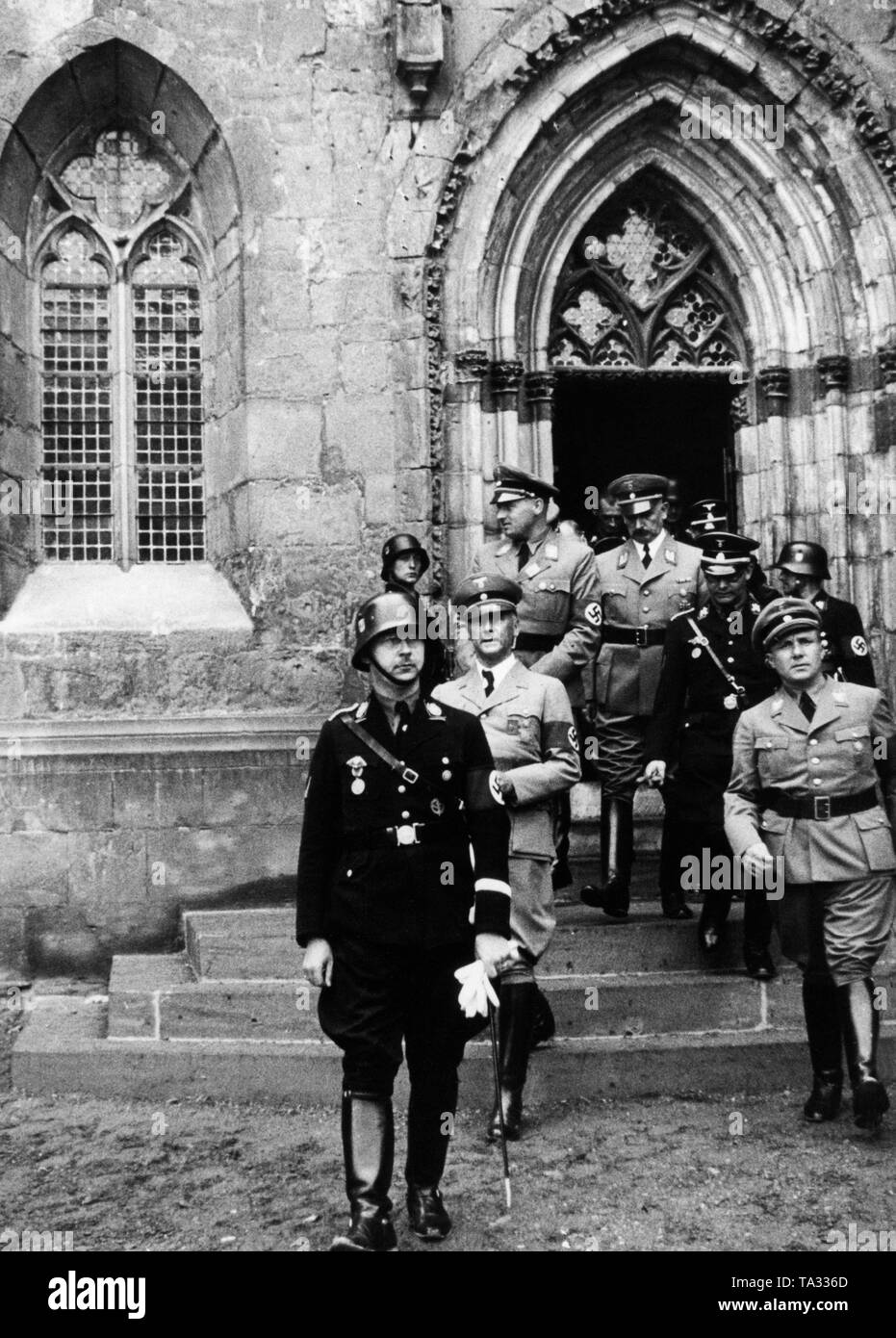 Reichsfuehrer-SS Heinrich Himmler, behind him Wilhelm Frick and Reichsleiter Martin Bormann (right) in front of the entrance of the Quedlinburger Dom (Stiftskirche St. Servatius), in which is located the grave of the German king and emperor of the Holy Roman Empire, Henry I (919-936 ) from the Liudolfinger (Ottonen) family. Henry I was venerated by Himmler especially as a founder of the empire and defender of Slavs. Himmler considered himself a reincarnation of the king and was personally present at the annual celebrations on July 2nd Stock Photohttps://www.alamy.com/image-license-details/?v=1https://www.alamy.com/reichsfuehrer-ss-heinrich-himmler-behind-him-wilhelm-frick-and-reichsleiter-martin-bormann-right-in-front-of-the-entrance-of-the-quedlinburger-dom-stiftskirche-st-servatius-in-which-is-located-the-grave-of-the-german-king-and-emperor-of-the-holy-roman-empire-henry-i-919-936-from-the-liudolfinger-ottonen-family-henry-i-was-venerated-by-himmler-especially-as-a-founder-of-the-empire-and-defender-of-slavs-himmler-considered-himself-a-reincarnation-of-the-king-and-was-personally-present-at-the-annual-celebrations-on-july-2nd-image247160101.html
Reichsfuehrer-SS Heinrich Himmler, behind him Wilhelm Frick and Reichsleiter Martin Bormann (right) in front of the entrance of the Quedlinburger Dom (Stiftskirche St. Servatius), in which is located the grave of the German king and emperor of the Holy Roman Empire, Henry I (919-936 ) from the Liudolfinger (Ottonen) family. Henry I was venerated by Himmler especially as a founder of the empire and defender of Slavs. Himmler considered himself a reincarnation of the king and was personally present at the annual celebrations on July 2nd Stock Photohttps://www.alamy.com/image-license-details/?v=1https://www.alamy.com/reichsfuehrer-ss-heinrich-himmler-behind-him-wilhelm-frick-and-reichsleiter-martin-bormann-right-in-front-of-the-entrance-of-the-quedlinburger-dom-stiftskirche-st-servatius-in-which-is-located-the-grave-of-the-german-king-and-emperor-of-the-holy-roman-empire-henry-i-919-936-from-the-liudolfinger-ottonen-family-henry-i-was-venerated-by-himmler-especially-as-a-founder-of-the-empire-and-defender-of-slavs-himmler-considered-himself-a-reincarnation-of-the-king-and-was-personally-present-at-the-annual-celebrations-on-july-2nd-image247160101.htmlRMTA336D–Reichsfuehrer-SS Heinrich Himmler, behind him Wilhelm Frick and Reichsleiter Martin Bormann (right) in front of the entrance of the Quedlinburger Dom (Stiftskirche St. Servatius), in which is located the grave of the German king and emperor of the Holy Roman Empire, Henry I (919-936 ) from the Liudolfinger (Ottonen) family. Henry I was venerated by Himmler especially as a founder of the empire and defender of Slavs. Himmler considered himself a reincarnation of the king and was personally present at the annual celebrations on July 2nd
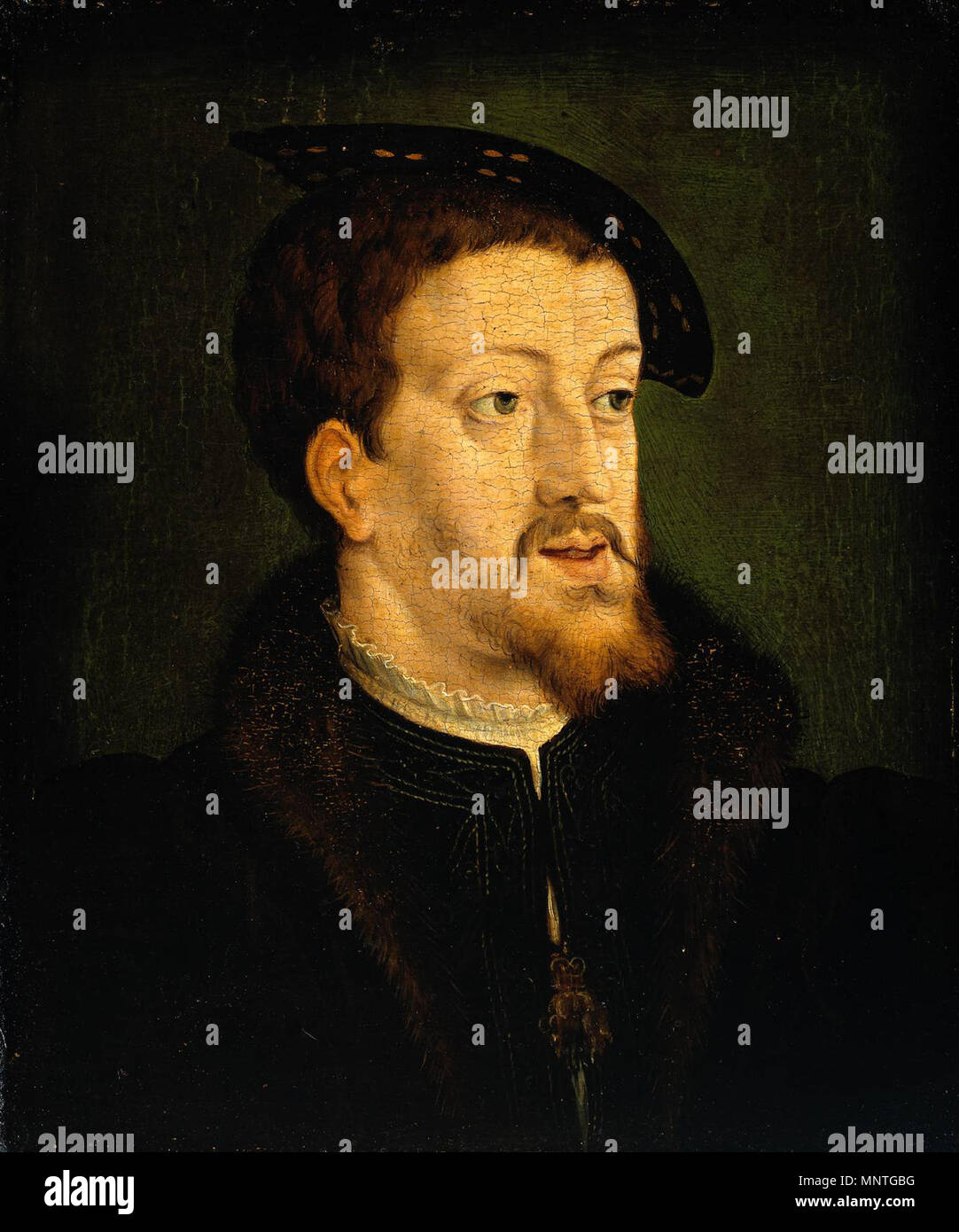 Portrait of Charles V (1500-58), emperor of the Holy Roman Empire circa 1530. 1018 Portrait of Charles V (Vermeyen) Stock Photohttps://www.alamy.com/image-license-details/?v=1https://www.alamy.com/portrait-of-charles-v-1500-58-emperor-of-the-holy-roman-empire-circa-1530-1018-portrait-of-charles-v-vermeyen-image185551172.html
Portrait of Charles V (1500-58), emperor of the Holy Roman Empire circa 1530. 1018 Portrait of Charles V (Vermeyen) Stock Photohttps://www.alamy.com/image-license-details/?v=1https://www.alamy.com/portrait-of-charles-v-1500-58-emperor-of-the-holy-roman-empire-circa-1530-1018-portrait-of-charles-v-vermeyen-image185551172.htmlRMMNTGBG–Portrait of Charles V (1500-58), emperor of the Holy Roman Empire circa 1530. 1018 Portrait of Charles V (Vermeyen)
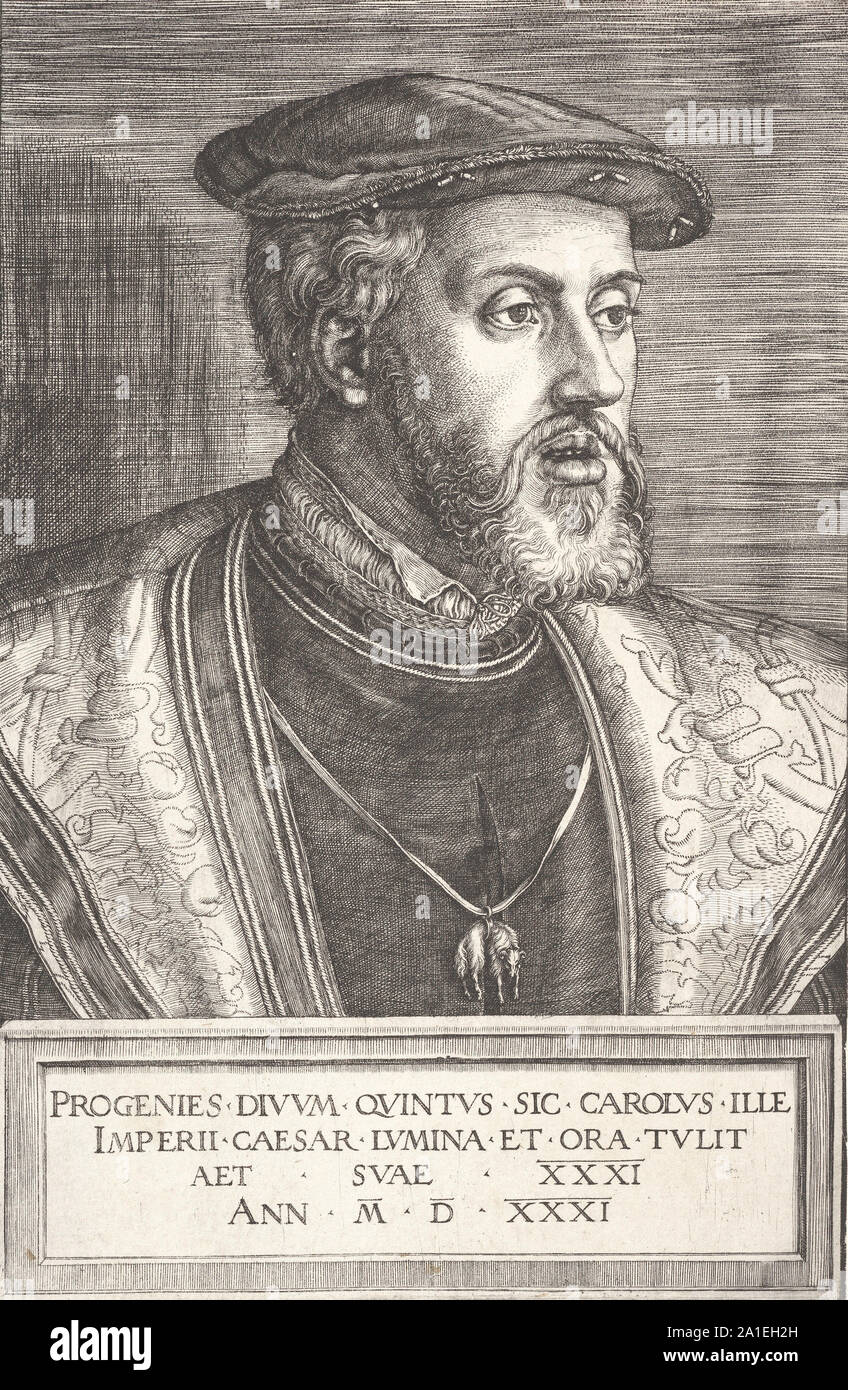 Emperor Charles V. Medieval engraving. Charles V was Holy Roman Emperor from 1519, King of Spain (Castile and Aragon, as Charles I) from 1516, and ruling prince of the Habsburg Netherlands from 1506. Stock Photohttps://www.alamy.com/image-license-details/?v=1https://www.alamy.com/emperor-charles-v-medieval-engraving-charles-v-was-holy-roman-emperor-from-1519-king-of-spain-castile-and-aragon-as-charles-i-from-1516-and-ruling-prince-of-the-habsburg-netherlands-from-1506-image327932377.html
Emperor Charles V. Medieval engraving. Charles V was Holy Roman Emperor from 1519, King of Spain (Castile and Aragon, as Charles I) from 1516, and ruling prince of the Habsburg Netherlands from 1506. Stock Photohttps://www.alamy.com/image-license-details/?v=1https://www.alamy.com/emperor-charles-v-medieval-engraving-charles-v-was-holy-roman-emperor-from-1519-king-of-spain-castile-and-aragon-as-charles-i-from-1516-and-ruling-prince-of-the-habsburg-netherlands-from-1506-image327932377.htmlRM2A1EH2H–Emperor Charles V. Medieval engraving. Charles V was Holy Roman Emperor from 1519, King of Spain (Castile and Aragon, as Charles I) from 1516, and ruling prince of the Habsburg Netherlands from 1506.
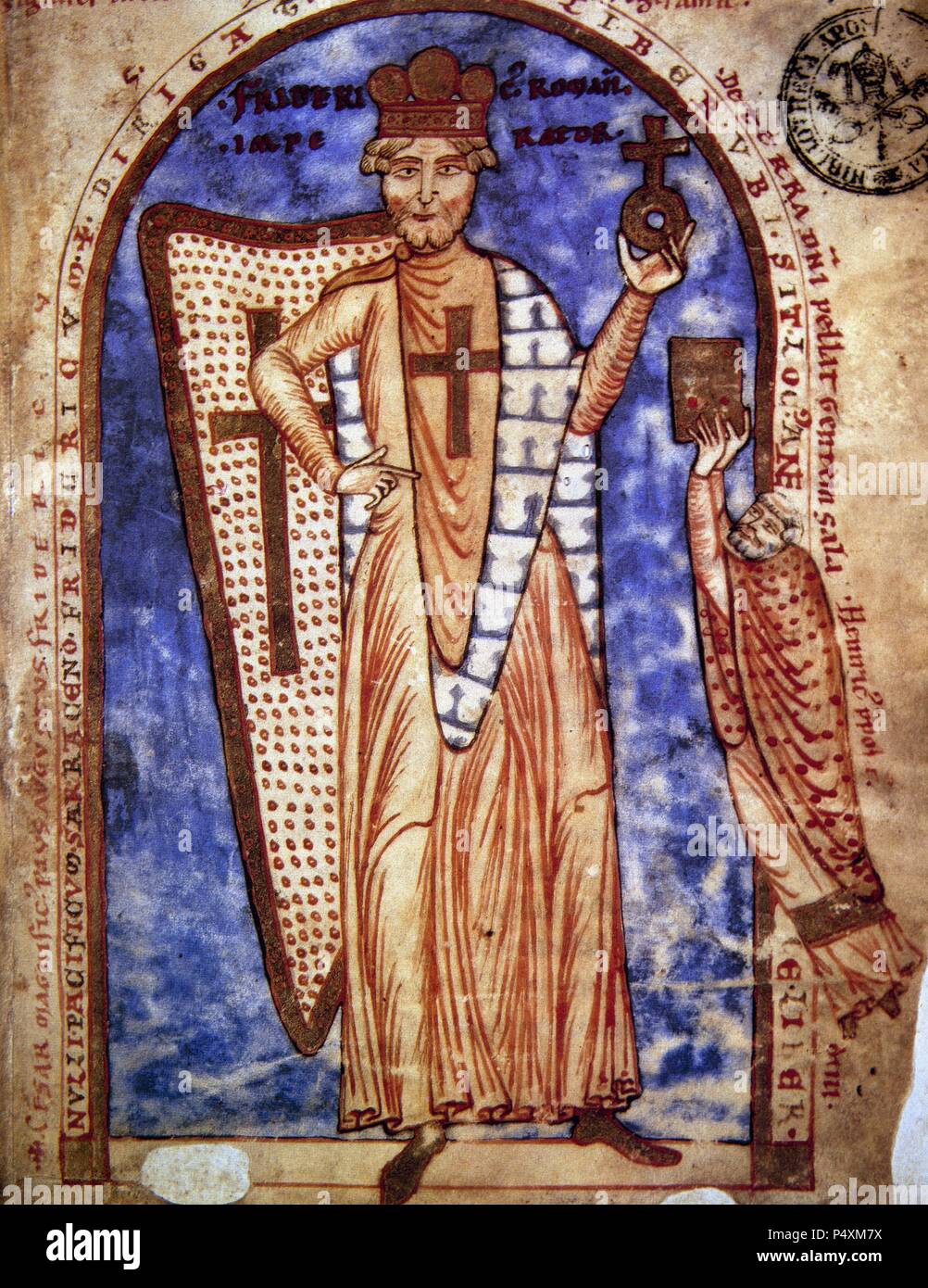 Frederick I Barbarossa (1122-1190). Emperor of the Holy Roman Empire (1152-1190). A scribe gives a codex to the emperor. Miniature. 12th century. By Robert, a monk of Reims. History of Jerusalem. Fol. 1. Vatican Apostolic Library. Italy. Stock Photohttps://www.alamy.com/image-license-details/?v=1https://www.alamy.com/frederick-i-barbarossa-1122-1190-emperor-of-the-holy-roman-empire-1152-1190-a-scribe-gives-a-codex-to-the-emperor-miniature-12th-century-by-robert-a-monk-of-reims-history-of-jerusalem-fol-1-vatican-apostolic-library-italy-image209569694.html
Frederick I Barbarossa (1122-1190). Emperor of the Holy Roman Empire (1152-1190). A scribe gives a codex to the emperor. Miniature. 12th century. By Robert, a monk of Reims. History of Jerusalem. Fol. 1. Vatican Apostolic Library. Italy. Stock Photohttps://www.alamy.com/image-license-details/?v=1https://www.alamy.com/frederick-i-barbarossa-1122-1190-emperor-of-the-holy-roman-empire-1152-1190-a-scribe-gives-a-codex-to-the-emperor-miniature-12th-century-by-robert-a-monk-of-reims-history-of-jerusalem-fol-1-vatican-apostolic-library-italy-image209569694.htmlRMP4XM7X–Frederick I Barbarossa (1122-1190). Emperor of the Holy Roman Empire (1152-1190). A scribe gives a codex to the emperor. Miniature. 12th century. By Robert, a monk of Reims. History of Jerusalem. Fol. 1. Vatican Apostolic Library. Italy.
 Franz Stephan of Lorraine <1708-1765> Maria Theresa's husband, Emperor of the Holy Roman Empire, 1899 Stock Photohttps://www.alamy.com/image-license-details/?v=1https://www.alamy.com/franz-stephan-of-lorraine-1708-1765-maria-theresas-husband-emperor-of-the-holy-roman-empire-1899-image225033045.html
Franz Stephan of Lorraine <1708-1765> Maria Theresa's husband, Emperor of the Holy Roman Empire, 1899 Stock Photohttps://www.alamy.com/image-license-details/?v=1https://www.alamy.com/franz-stephan-of-lorraine-1708-1765-maria-theresas-husband-emperor-of-the-holy-roman-empire-1899-image225033045.htmlRMR233XD–Franz Stephan of Lorraine <1708-1765> Maria Theresa's husband, Emperor of the Holy Roman Empire, 1899
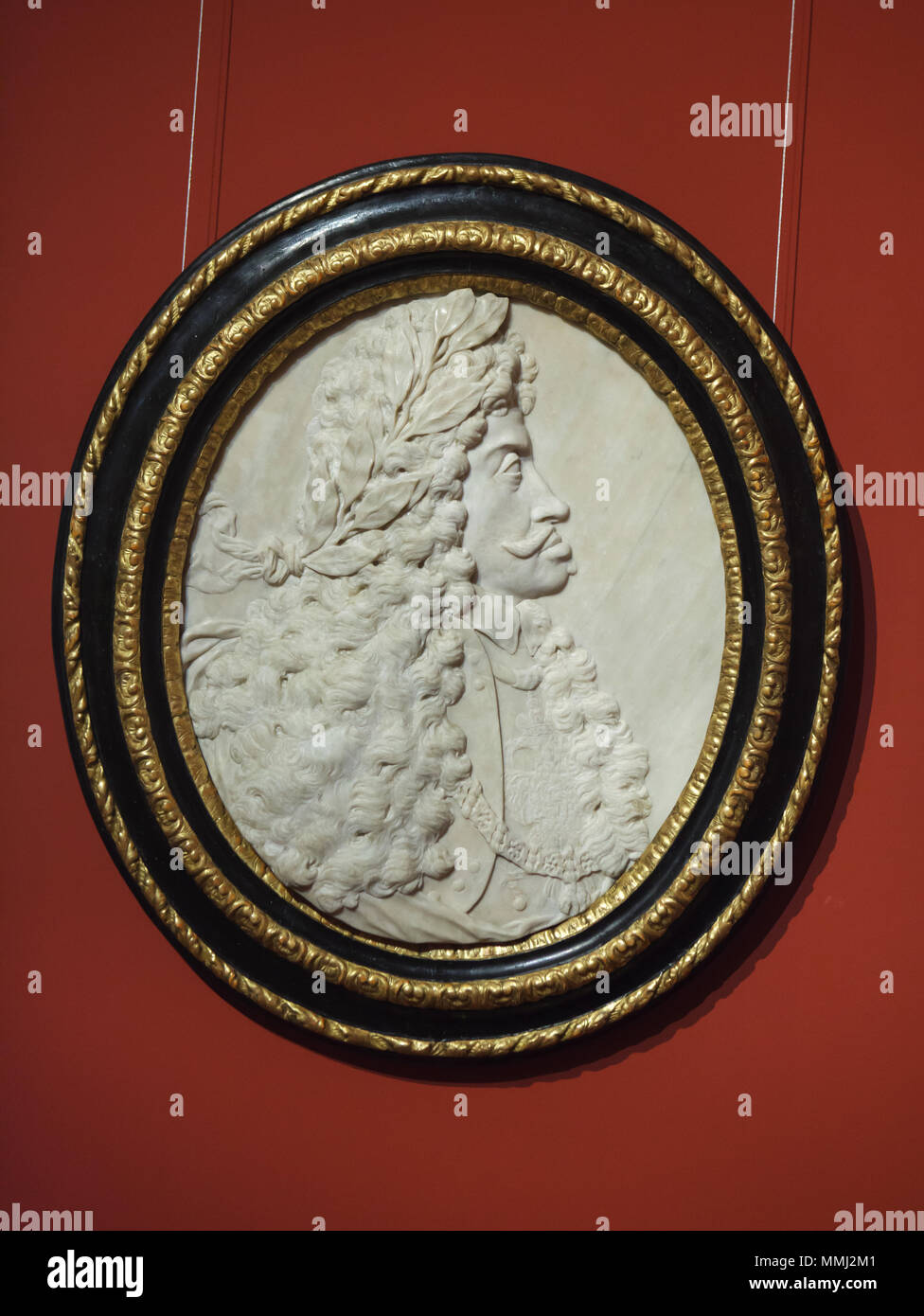 Holy Roman Emperor Leopold I (1640 - 1705) depicted in the marble relief by Austrian Baroque sculptor Paul Strudel dated from before 1705 on display in the Belvedere Museum in Vienna, Austria. Stock Photohttps://www.alamy.com/image-license-details/?v=1https://www.alamy.com/holy-roman-emperor-leopold-i-1640-1705-depicted-in-the-marble-relief-by-austrian-baroque-sculptor-paul-strudel-dated-from-before-1705-on-display-in-the-belvedere-museum-in-vienna-austria-image184794065.html
Holy Roman Emperor Leopold I (1640 - 1705) depicted in the marble relief by Austrian Baroque sculptor Paul Strudel dated from before 1705 on display in the Belvedere Museum in Vienna, Austria. Stock Photohttps://www.alamy.com/image-license-details/?v=1https://www.alamy.com/holy-roman-emperor-leopold-i-1640-1705-depicted-in-the-marble-relief-by-austrian-baroque-sculptor-paul-strudel-dated-from-before-1705-on-display-in-the-belvedere-museum-in-vienna-austria-image184794065.htmlRMMMJ2M1–Holy Roman Emperor Leopold I (1640 - 1705) depicted in the marble relief by Austrian Baroque sculptor Paul Strudel dated from before 1705 on display in the Belvedere Museum in Vienna, Austria.
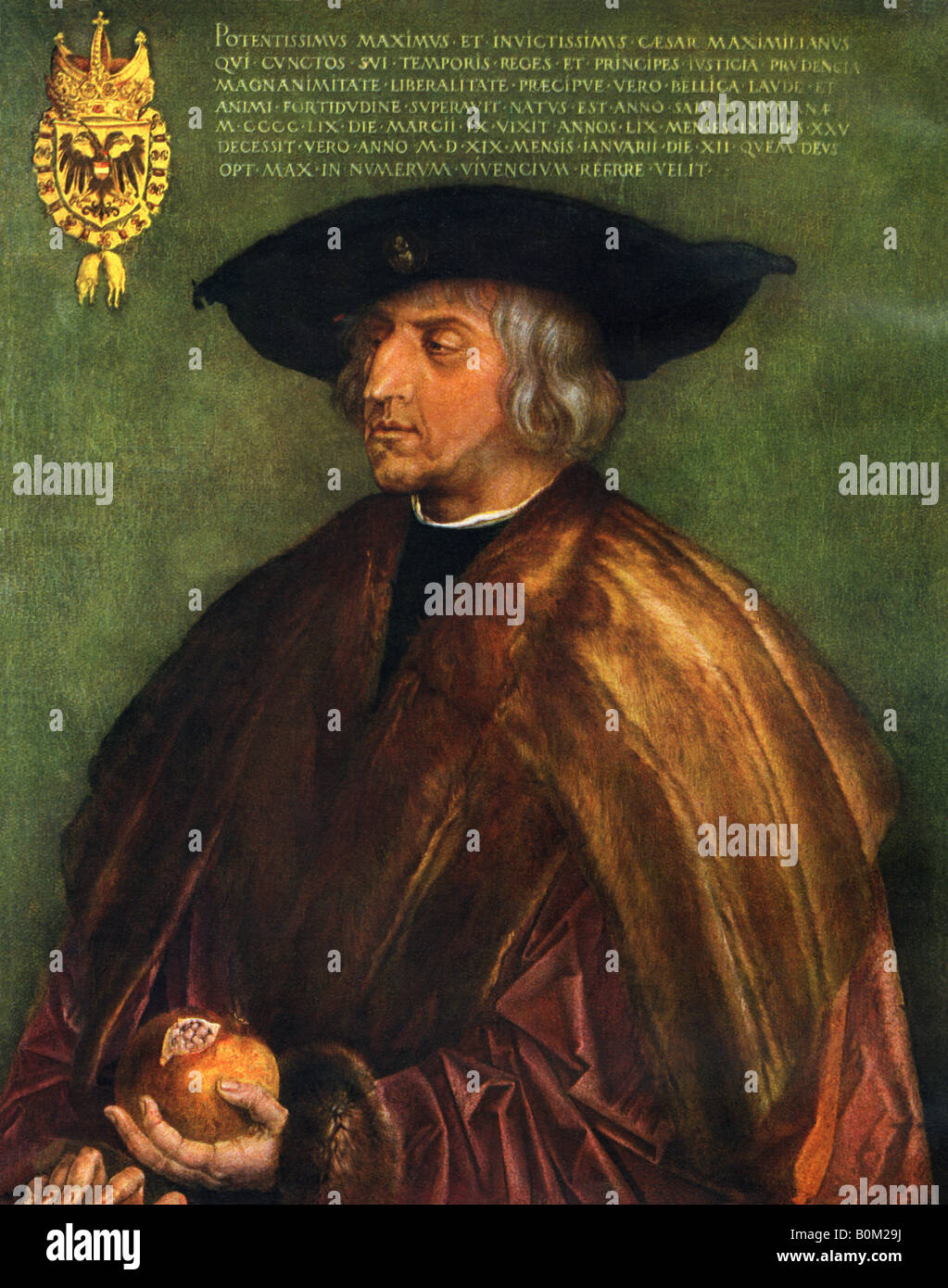 German Maximilian I Stock Photohttps://www.alamy.com/image-license-details/?v=1https://www.alamy.com/stock-photo-german-maximilian-i-17651246.html
German Maximilian I Stock Photohttps://www.alamy.com/image-license-details/?v=1https://www.alamy.com/stock-photo-german-maximilian-i-17651246.htmlRFB0M29J–German Maximilian I
 Rome, Italy - Oct 03, 2018: sculpture of Charlemagne or Charles the Great, emperor of the holy roman empire on the facade San Luigi dei Francesi Stock Photohttps://www.alamy.com/image-license-details/?v=1https://www.alamy.com/rome-italy-oct-03-2018-sculpture-of-charlemagne-or-charles-the-great-emperor-of-the-holy-roman-empire-on-the-facade-san-luigi-dei-francesi-image408420084.html
Rome, Italy - Oct 03, 2018: sculpture of Charlemagne or Charles the Great, emperor of the holy roman empire on the facade San Luigi dei Francesi Stock Photohttps://www.alamy.com/image-license-details/?v=1https://www.alamy.com/rome-italy-oct-03-2018-sculpture-of-charlemagne-or-charles-the-great-emperor-of-the-holy-roman-empire-on-the-facade-san-luigi-dei-francesi-image408420084.htmlRF2EMD3YG–Rome, Italy - Oct 03, 2018: sculpture of Charlemagne or Charles the Great, emperor of the holy roman empire on the facade San Luigi dei Francesi
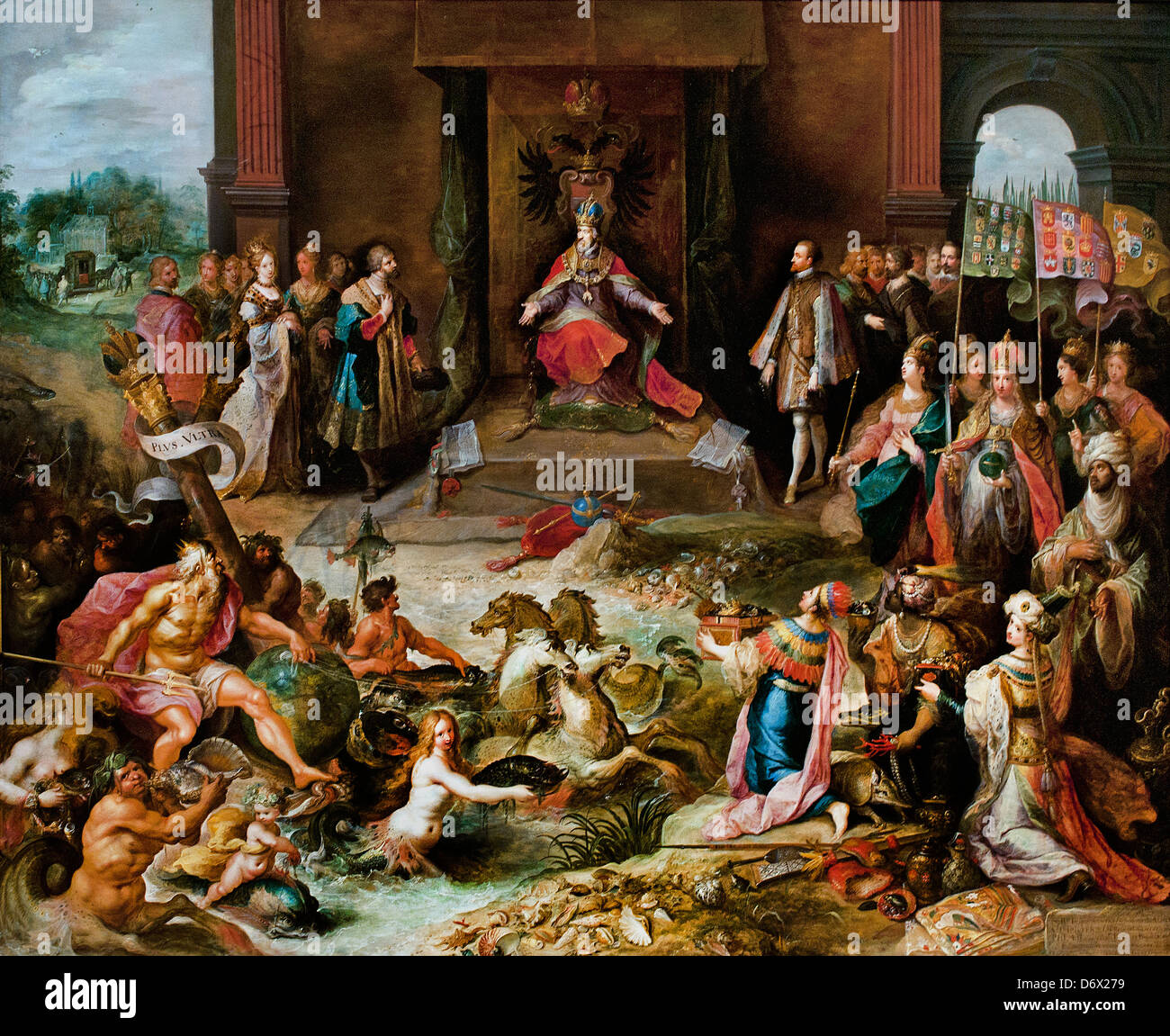 Allegory of the Abdication of Emperor Charles V Holy Roman Empire 1630 Frans Franken Belgian Belgium Stock Photohttps://www.alamy.com/image-license-details/?v=1https://www.alamy.com/stock-photo-allegory-of-the-abdication-of-emperor-charles-v-holy-roman-empire-55891565.html
Allegory of the Abdication of Emperor Charles V Holy Roman Empire 1630 Frans Franken Belgian Belgium Stock Photohttps://www.alamy.com/image-license-details/?v=1https://www.alamy.com/stock-photo-allegory-of-the-abdication-of-emperor-charles-v-holy-roman-empire-55891565.htmlRMD6X279–Allegory of the Abdication of Emperor Charles V Holy Roman Empire 1630 Frans Franken Belgian Belgium
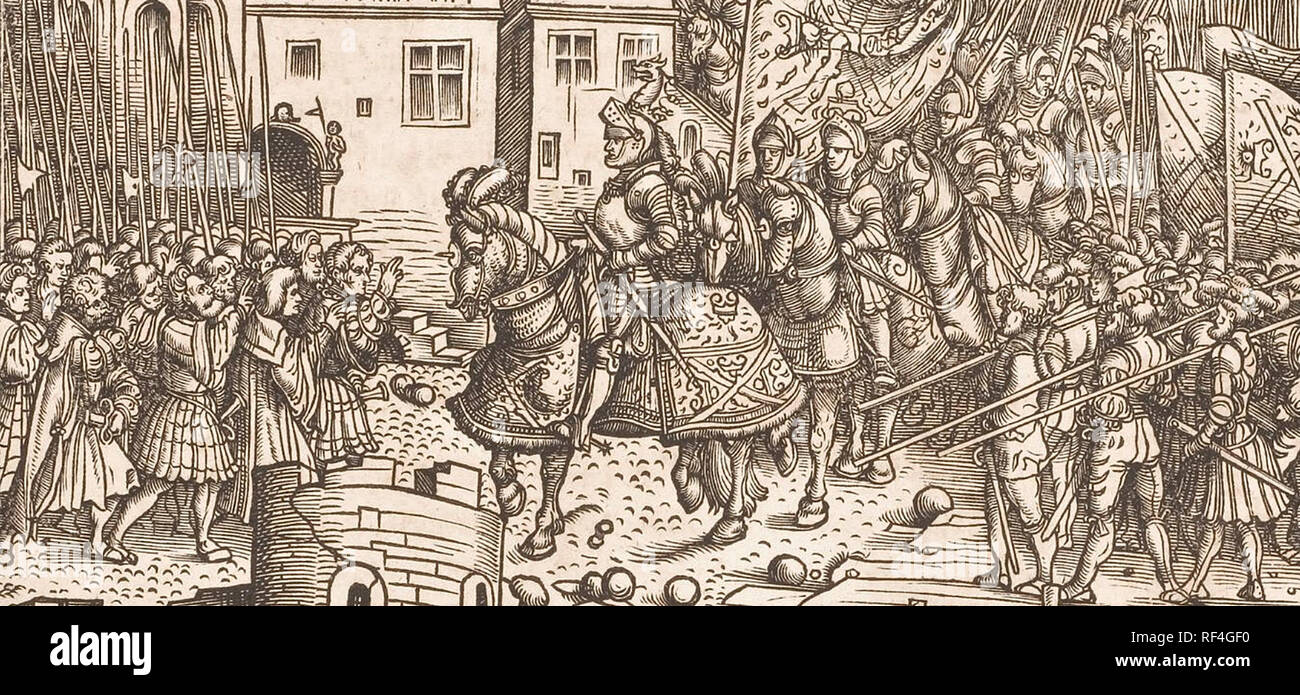 Maximilian on horseback in besieged town Stock Photohttps://www.alamy.com/image-license-details/?v=1https://www.alamy.com/maximilian-on-horseback-in-besieged-town-image233055396.html
Maximilian on horseback in besieged town Stock Photohttps://www.alamy.com/image-license-details/?v=1https://www.alamy.com/maximilian-on-horseback-in-besieged-town-image233055396.htmlRMRF4GF0–Maximilian on horseback in besieged town
 Charlemagne, aka Charles the Great, or Charles I, 742 - 814. King of the Franks and Emperor of the Holy Roman Empire. Stock Photohttps://www.alamy.com/image-license-details/?v=1https://www.alamy.com/charlemagne-aka-charles-the-great-or-charles-i-742-814-king-of-the-image6094098.html
Charlemagne, aka Charles the Great, or Charles I, 742 - 814. King of the Franks and Emperor of the Holy Roman Empire. Stock Photohttps://www.alamy.com/image-license-details/?v=1https://www.alamy.com/charlemagne-aka-charles-the-great-or-charles-i-742-814-king-of-the-image6094098.htmlRMA346W3–Charlemagne, aka Charles the Great, or Charles I, 742 - 814. King of the Franks and Emperor of the Holy Roman Empire.
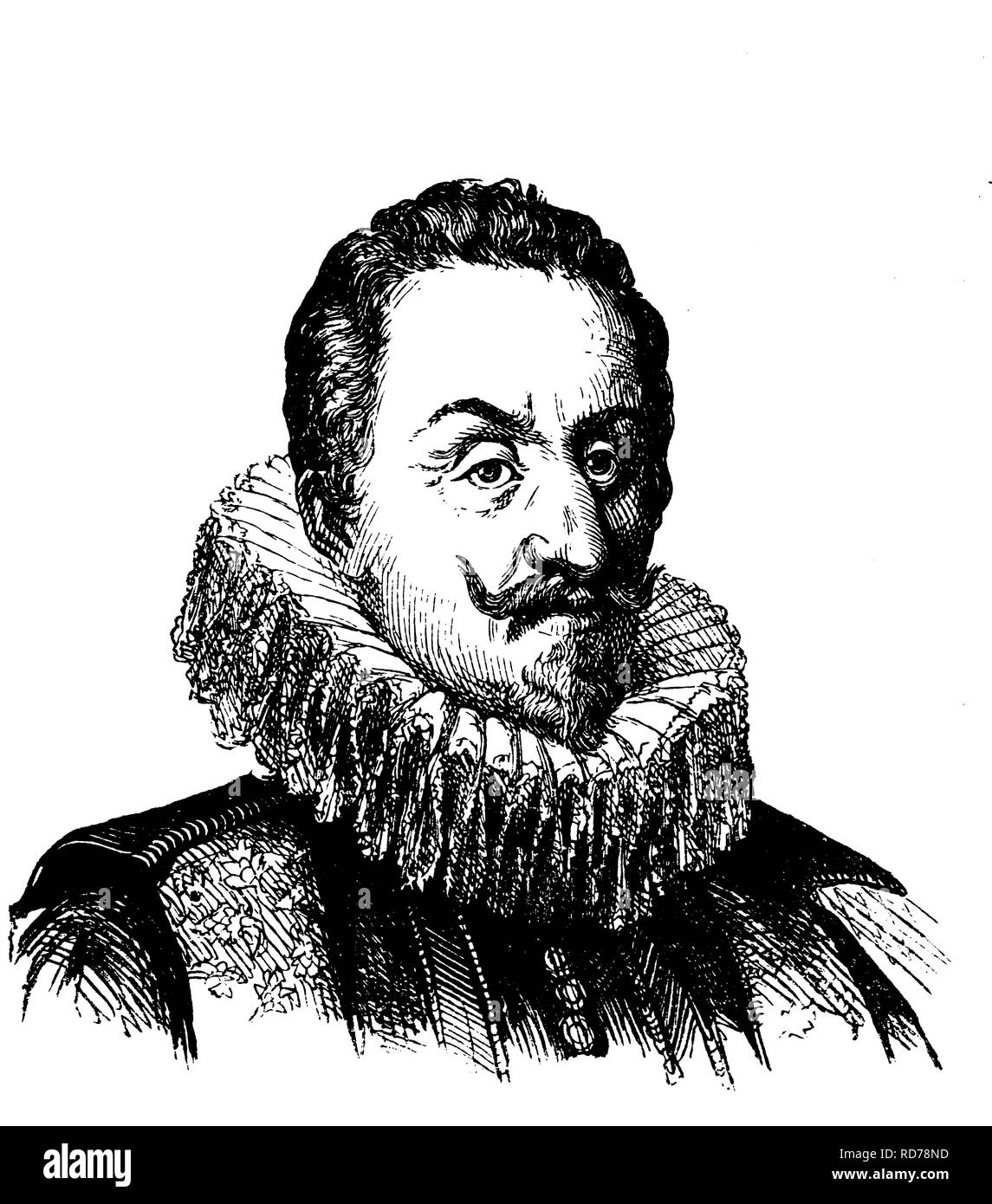 Ferdinand II, 1578 - 1637, King of Bohemia, Hungary, Croatia, Emperor of the Holy Roman Empire, historical woodcut, circa 1880 Stock Photohttps://www.alamy.com/image-license-details/?v=1https://www.alamy.com/ferdinand-ii-1578-1637-king-of-bohemia-hungary-croatia-emperor-of-the-holy-roman-empire-historical-woodcut-circa-1880-image231885849.html
Ferdinand II, 1578 - 1637, King of Bohemia, Hungary, Croatia, Emperor of the Holy Roman Empire, historical woodcut, circa 1880 Stock Photohttps://www.alamy.com/image-license-details/?v=1https://www.alamy.com/ferdinand-ii-1578-1637-king-of-bohemia-hungary-croatia-emperor-of-the-holy-roman-empire-historical-woodcut-circa-1880-image231885849.htmlRMRD78ND–Ferdinand II, 1578 - 1637, King of Bohemia, Hungary, Croatia, Emperor of the Holy Roman Empire, historical woodcut, circa 1880
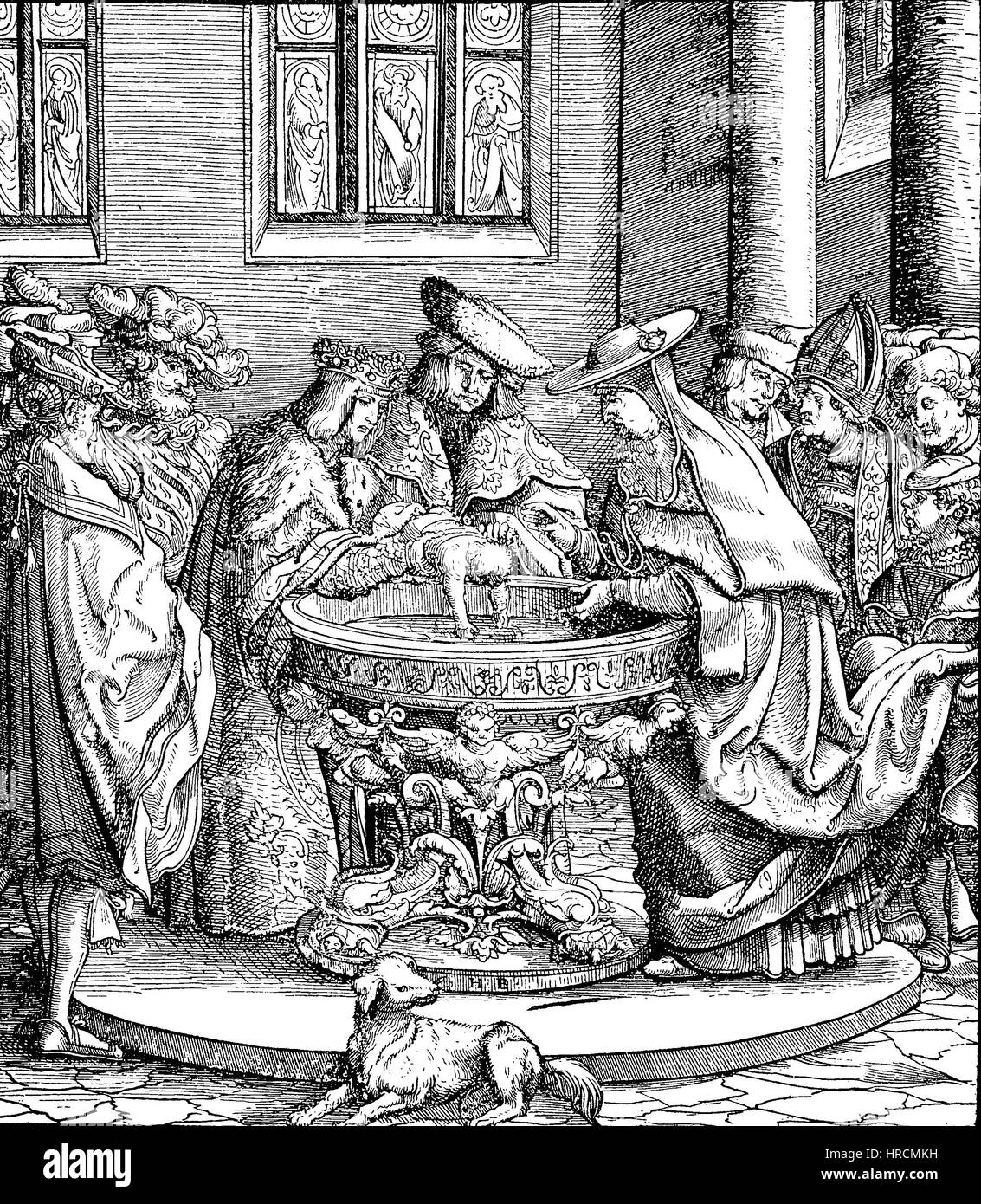 Baptism of Maximilian I. 1459, from 1486 Roman-German king, from 1493 master of the Austrian hereditary lands and from 1508 emperor of the Holy Roman Empire. Facsimile of woodcut by Hans Burgkmair, reproduction of an woodcut from the 19th century, 1885 Stock Photohttps://www.alamy.com/image-license-details/?v=1https://www.alamy.com/stock-photo-baptism-of-maximilian-i-1459-from-1486-roman-german-king-from-1493-134889317.html
Baptism of Maximilian I. 1459, from 1486 Roman-German king, from 1493 master of the Austrian hereditary lands and from 1508 emperor of the Holy Roman Empire. Facsimile of woodcut by Hans Burgkmair, reproduction of an woodcut from the 19th century, 1885 Stock Photohttps://www.alamy.com/image-license-details/?v=1https://www.alamy.com/stock-photo-baptism-of-maximilian-i-1459-from-1486-roman-german-king-from-1493-134889317.htmlRFHRCMKH–Baptism of Maximilian I. 1459, from 1486 Roman-German king, from 1493 master of the Austrian hereditary lands and from 1508 emperor of the Holy Roman Empire. Facsimile of woodcut by Hans Burgkmair, reproduction of an woodcut from the 19th century, 1885
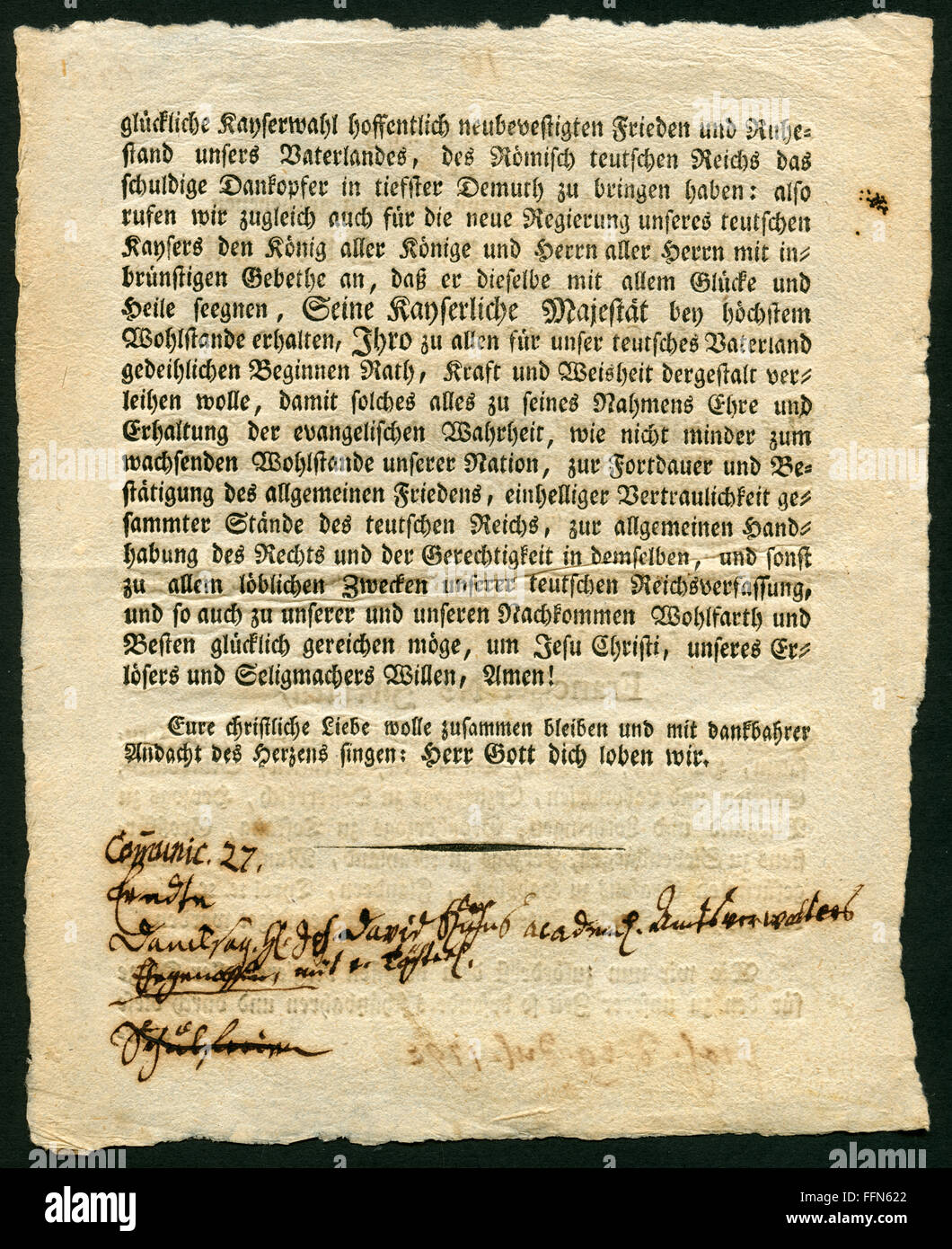 Germany, principality of Weimar, announcment the election of the emperor of the Holy Roman Empire of the German ntion Franz II. at the 14th July of 1792, to read in all churches of the principality, reverse side., Stock Photohttps://www.alamy.com/image-license-details/?v=1https://www.alamy.com/stock-photo-germany-principality-of-weimar-announcment-the-election-of-the-emperor-95737434.html
Germany, principality of Weimar, announcment the election of the emperor of the Holy Roman Empire of the German ntion Franz II. at the 14th July of 1792, to read in all churches of the principality, reverse side., Stock Photohttps://www.alamy.com/image-license-details/?v=1https://www.alamy.com/stock-photo-germany-principality-of-weimar-announcment-the-election-of-the-emperor-95737434.htmlRMFFN622–Germany, principality of Weimar, announcment the election of the emperor of the Holy Roman Empire of the German ntion Franz II. at the 14th July of 1792, to read in all churches of the principality, reverse side.,
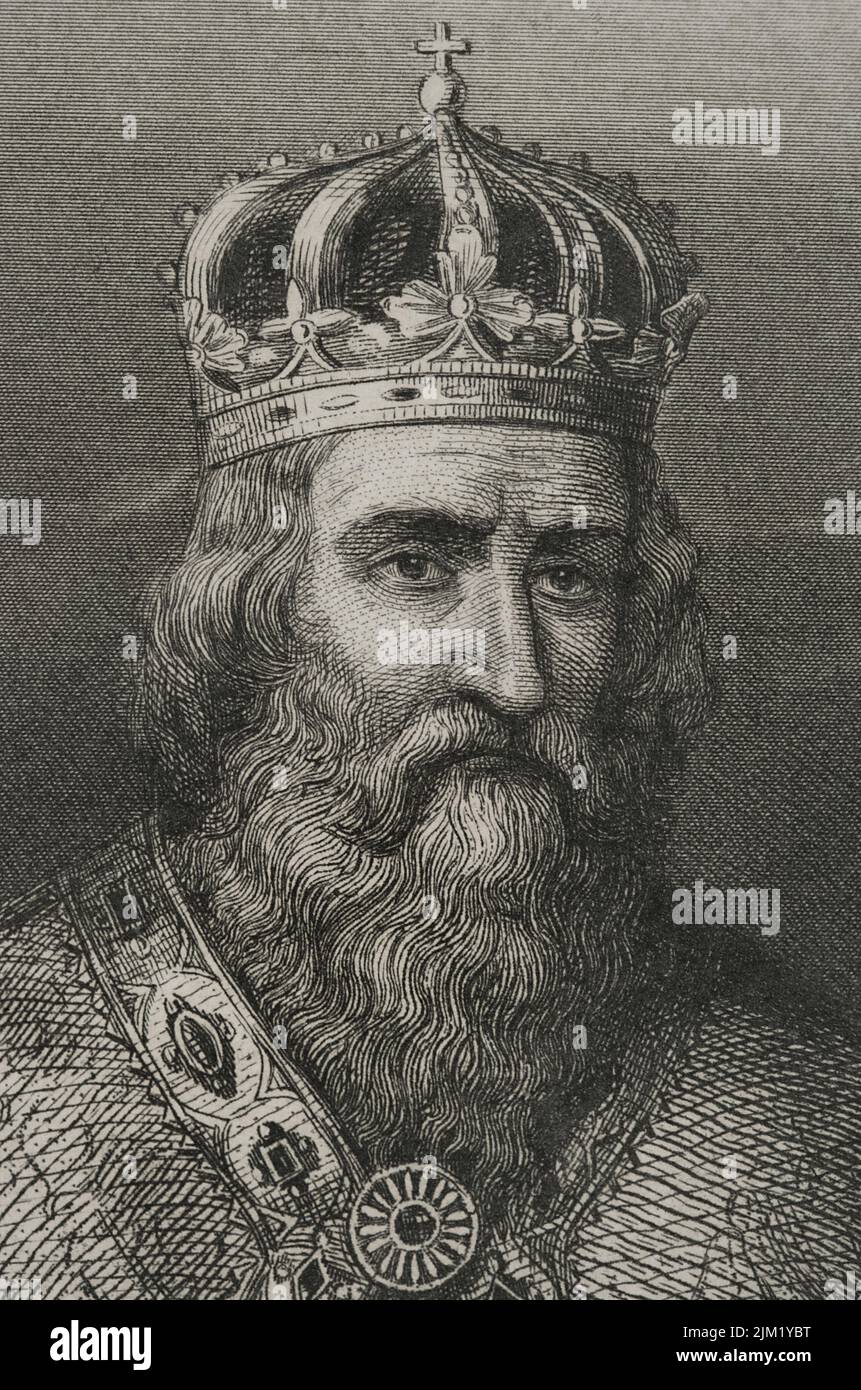 Charlemagne (742-814). King of the Franks (768-814), king of the Lombards (774-814), and emperor of the Holy Roman Empire (800-814). Portrait. Engraving. Detail. 'Historia Universal', by César Cantú. Volume III, 1855. Stock Photohttps://www.alamy.com/image-license-details/?v=1https://www.alamy.com/charlemagne-742-814-king-of-the-franks-768-814-king-of-the-lombards-774-814-and-emperor-of-the-holy-roman-empire-800-814-portrait-engraving-detail-historia-universal-by-csar-cant-volume-iii-1855-image477016508.html
Charlemagne (742-814). King of the Franks (768-814), king of the Lombards (774-814), and emperor of the Holy Roman Empire (800-814). Portrait. Engraving. Detail. 'Historia Universal', by César Cantú. Volume III, 1855. Stock Photohttps://www.alamy.com/image-license-details/?v=1https://www.alamy.com/charlemagne-742-814-king-of-the-franks-768-814-king-of-the-lombards-774-814-and-emperor-of-the-holy-roman-empire-800-814-portrait-engraving-detail-historia-universal-by-csar-cant-volume-iii-1855-image477016508.htmlRM2JM1YBT–Charlemagne (742-814). King of the Franks (768-814), king of the Lombards (774-814), and emperor of the Holy Roman Empire (800-814). Portrait. Engraving. Detail. 'Historia Universal', by César Cantú. Volume III, 1855.
 Maximilian I (1459-1519). Holy Roman Emperor. Engraving by Durer. The betrothal of Maximilian I with Mary of Burgundy. Detail. Stock Photohttps://www.alamy.com/image-license-details/?v=1https://www.alamy.com/maximilian-i-1459-1519-holy-roman-emperor-engraving-by-durer-the-betrothal-of-maximilian-i-with-mary-of-burgundy-detail-image230864683.html
Maximilian I (1459-1519). Holy Roman Emperor. Engraving by Durer. The betrothal of Maximilian I with Mary of Burgundy. Detail. Stock Photohttps://www.alamy.com/image-license-details/?v=1https://www.alamy.com/maximilian-i-1459-1519-holy-roman-emperor-engraving-by-durer-the-betrothal-of-maximilian-i-with-mary-of-burgundy-detail-image230864683.htmlRMRBGP77–Maximilian I (1459-1519). Holy Roman Emperor. Engraving by Durer. The betrothal of Maximilian I with Mary of Burgundy. Detail.
 Charles V (1500–1558), Emperor of the Holy Roman Empire (1519–56), Italian, 16th century, Italian, Gilt bronze, Diameter: 3 7/8 in. (98 mm), Medals and Plaquettes Stock Photohttps://www.alamy.com/image-license-details/?v=1https://www.alamy.com/charles-v-15001558-emperor-of-the-holy-roman-empire-151956-italian-16th-century-italian-gilt-bronze-diameter-3-78-in-98-mm-medals-and-plaquettes-image344588053.html
Charles V (1500–1558), Emperor of the Holy Roman Empire (1519–56), Italian, 16th century, Italian, Gilt bronze, Diameter: 3 7/8 in. (98 mm), Medals and Plaquettes Stock Photohttps://www.alamy.com/image-license-details/?v=1https://www.alamy.com/charles-v-15001558-emperor-of-the-holy-roman-empire-151956-italian-16th-century-italian-gilt-bronze-diameter-3-78-in-98-mm-medals-and-plaquettes-image344588053.htmlRM2B0H9G5–Charles V (1500–1558), Emperor of the Holy Roman Empire (1519–56), Italian, 16th century, Italian, Gilt bronze, Diameter: 3 7/8 in. (98 mm), Medals and Plaquettes
 Portrait of Maximilian II (Vienna, July 31, 1527 - Regensburg, October 12, 1576), elected emperor of the Holy Roman Empire, King of Hungary between 1564 and 1576, King of Bohemia between 1564 and 1576. History of Philip II of Spain. Old engraving published in Historia de Felipe II by H. Forneron, in 1884 Stock Photohttps://www.alamy.com/image-license-details/?v=1https://www.alamy.com/portrait-of-maximilian-ii-vienna-july-31-1527-regensburg-october-12-1576-elected-emperor-of-the-holy-roman-empire-king-of-hungary-between-1564-and-1576-king-of-bohemia-between-1564-and-1576-history-of-philip-ii-of-spain-old-engraving-published-in-historia-de-felipe-ii-by-h-forneron-in-1884-image397204814.html
Portrait of Maximilian II (Vienna, July 31, 1527 - Regensburg, October 12, 1576), elected emperor of the Holy Roman Empire, King of Hungary between 1564 and 1576, King of Bohemia between 1564 and 1576. History of Philip II of Spain. Old engraving published in Historia de Felipe II by H. Forneron, in 1884 Stock Photohttps://www.alamy.com/image-license-details/?v=1https://www.alamy.com/portrait-of-maximilian-ii-vienna-july-31-1527-regensburg-october-12-1576-elected-emperor-of-the-holy-roman-empire-king-of-hungary-between-1564-and-1576-king-of-bohemia-between-1564-and-1576-history-of-philip-ii-of-spain-old-engraving-published-in-historia-de-felipe-ii-by-h-forneron-in-1884-image397204814.htmlRM2E266P6–Portrait of Maximilian II (Vienna, July 31, 1527 - Regensburg, October 12, 1576), elected emperor of the Holy Roman Empire, King of Hungary between 1564 and 1576, King of Bohemia between 1564 and 1576. History of Philip II of Spain. Old engraving published in Historia de Felipe II by H. Forneron, in 1884
 portrait of Maximilian I of Habsburg, 1459-1519, German king and emperor of the Holy Roman Empire Stock Photohttps://www.alamy.com/image-license-details/?v=1https://www.alamy.com/stock-photo-portrait-of-maximilian-i-of-habsburg-1459-1519-german-king-and-emperor-59068008.html
portrait of Maximilian I of Habsburg, 1459-1519, German king and emperor of the Holy Roman Empire Stock Photohttps://www.alamy.com/image-license-details/?v=1https://www.alamy.com/stock-photo-portrait-of-maximilian-i-of-habsburg-1459-1519-german-king-and-emperor-59068008.htmlRMDC2NRM–portrait of Maximilian I of Habsburg, 1459-1519, German king and emperor of the Holy Roman Empire
 Adolf Hilter (front) and Reichsfuehrer SS Heinrich Himmler congratulate young officers of the SS in the crypt with the grave of Henry I, Emperor of the Holy Roman Empire, in the Quedlinburger Dom (Stiftskirche St. Servatius). Behind from left, Julius Schaub and Karl Wolff. Undated recording. Stock Photohttps://www.alamy.com/image-license-details/?v=1https://www.alamy.com/adolf-hilter-front-and-reichsfuehrer-ss-heinrich-himmler-congratulate-young-officers-of-the-ss-in-the-crypt-with-the-grave-of-henry-i-emperor-of-the-holy-roman-empire-in-the-quedlinburger-dom-stiftskirche-st-servatius-behind-from-left-julius-schaub-and-karl-wolff-undated-recording-image247166703.html
Adolf Hilter (front) and Reichsfuehrer SS Heinrich Himmler congratulate young officers of the SS in the crypt with the grave of Henry I, Emperor of the Holy Roman Empire, in the Quedlinburger Dom (Stiftskirche St. Servatius). Behind from left, Julius Schaub and Karl Wolff. Undated recording. Stock Photohttps://www.alamy.com/image-license-details/?v=1https://www.alamy.com/adolf-hilter-front-and-reichsfuehrer-ss-heinrich-himmler-congratulate-young-officers-of-the-ss-in-the-crypt-with-the-grave-of-henry-i-emperor-of-the-holy-roman-empire-in-the-quedlinburger-dom-stiftskirche-st-servatius-behind-from-left-julius-schaub-and-karl-wolff-undated-recording-image247166703.htmlRMTA3BJ7–Adolf Hilter (front) and Reichsfuehrer SS Heinrich Himmler congratulate young officers of the SS in the crypt with the grave of Henry I, Emperor of the Holy Roman Empire, in the Quedlinburger Dom (Stiftskirche St. Servatius). Behind from left, Julius Schaub and Karl Wolff. Undated recording.
 Portrait of Maximilian I (1459-1519), emperor of the Holy Roman Empire. circa 1530. Workshop of Joos van Cleve 001 Stock Photohttps://www.alamy.com/image-license-details/?v=1https://www.alamy.com/portrait-of-maximilian-i-1459-1519-emperor-of-the-holy-roman-empire-circa-1530-workshop-of-joos-van-cleve-001-image184866986.html
Portrait of Maximilian I (1459-1519), emperor of the Holy Roman Empire. circa 1530. Workshop of Joos van Cleve 001 Stock Photohttps://www.alamy.com/image-license-details/?v=1https://www.alamy.com/portrait-of-maximilian-i-1459-1519-emperor-of-the-holy-roman-empire-circa-1530-workshop-of-joos-van-cleve-001-image184866986.htmlRMMMNBMA–Portrait of Maximilian I (1459-1519), emperor of the Holy Roman Empire. circa 1530. Workshop of Joos van Cleve 001
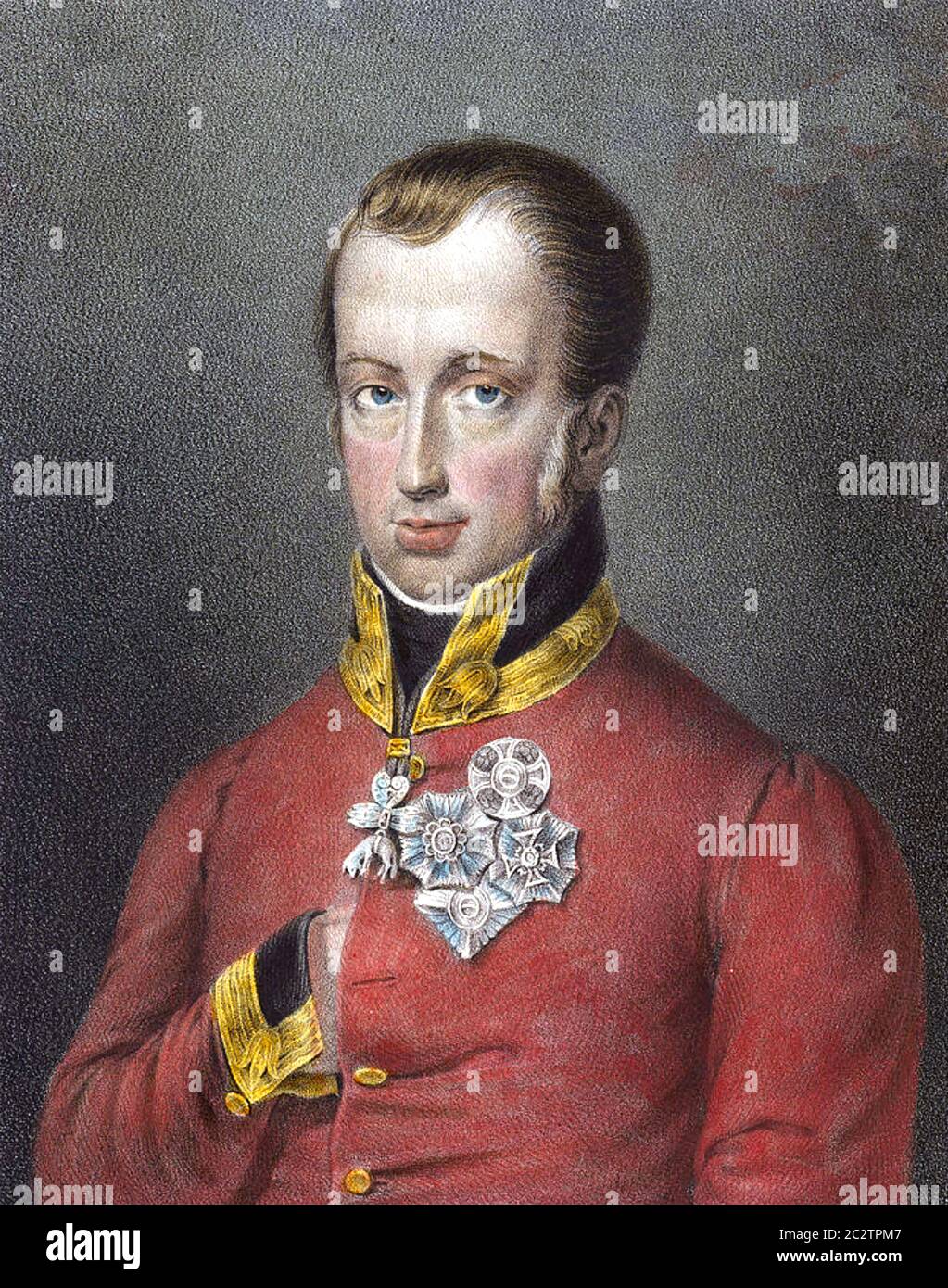 FRANCIS II, HOLY ROMAN EMPEROR (1768-1835) last of the Holy Roman Emperors Stock Photohttps://www.alamy.com/image-license-details/?v=1https://www.alamy.com/francis-ii-holy-roman-emperor-1768-1835-last-of-the-holy-roman-emperors-image363191703.html
FRANCIS II, HOLY ROMAN EMPEROR (1768-1835) last of the Holy Roman Emperors Stock Photohttps://www.alamy.com/image-license-details/?v=1https://www.alamy.com/francis-ii-holy-roman-emperor-1768-1835-last-of-the-holy-roman-emperors-image363191703.htmlRM2C2TPM7–FRANCIS II, HOLY ROMAN EMPEROR (1768-1835) last of the Holy Roman Emperors
 Charlemagne (742-814). King of the Franks (768-814), king of the Lombards (774-814), and emperor of the Holy Roman Empire (800-814). Portrait. Engraving. 'Historia Universal', by César Cantú. Volume III, 1855. Stock Photohttps://www.alamy.com/image-license-details/?v=1https://www.alamy.com/charlemagne-742-814-king-of-the-franks-768-814-king-of-the-lombards-774-814-and-emperor-of-the-holy-roman-empire-800-814-portrait-engraving-historia-universal-by-csar-cant-volume-iii-1855-image477441829.html
Charlemagne (742-814). King of the Franks (768-814), king of the Lombards (774-814), and emperor of the Holy Roman Empire (800-814). Portrait. Engraving. 'Historia Universal', by César Cantú. Volume III, 1855. Stock Photohttps://www.alamy.com/image-license-details/?v=1https://www.alamy.com/charlemagne-742-814-king-of-the-franks-768-814-king-of-the-lombards-774-814-and-emperor-of-the-holy-roman-empire-800-814-portrait-engraving-historia-universal-by-csar-cant-volume-iii-1855-image477441829.htmlRM2JMN9WW–Charlemagne (742-814). King of the Franks (768-814), king of the Lombards (774-814), and emperor of the Holy Roman Empire (800-814). Portrait. Engraving. 'Historia Universal', by César Cantú. Volume III, 1855.
 Charles V (1500-1558), Emperor of the Holy Roman Empire, in 1521, after a woodcut by Albrecht Dürer. From a pamphlet Ulrich von Huttens, Albrecht Dürer 1899 Stock Photohttps://www.alamy.com/image-license-details/?v=1https://www.alamy.com/charles-v-1500-1558-emperor-of-the-holy-roman-empire-in-1521-after-a-woodcut-by-albrecht-drer-from-a-pamphlet-ulrich-von-huttens-albrecht-drer-1899-image210708591.html
Charles V (1500-1558), Emperor of the Holy Roman Empire, in 1521, after a woodcut by Albrecht Dürer. From a pamphlet Ulrich von Huttens, Albrecht Dürer 1899 Stock Photohttps://www.alamy.com/image-license-details/?v=1https://www.alamy.com/charles-v-1500-1558-emperor-of-the-holy-roman-empire-in-1521-after-a-woodcut-by-albrecht-drer-from-a-pamphlet-ulrich-von-huttens-albrecht-drer-1899-image210708591.htmlRMP6PGXR–Charles V (1500-1558), Emperor of the Holy Roman Empire, in 1521, after a woodcut by Albrecht Dürer. From a pamphlet Ulrich von Huttens, Albrecht Dürer 1899
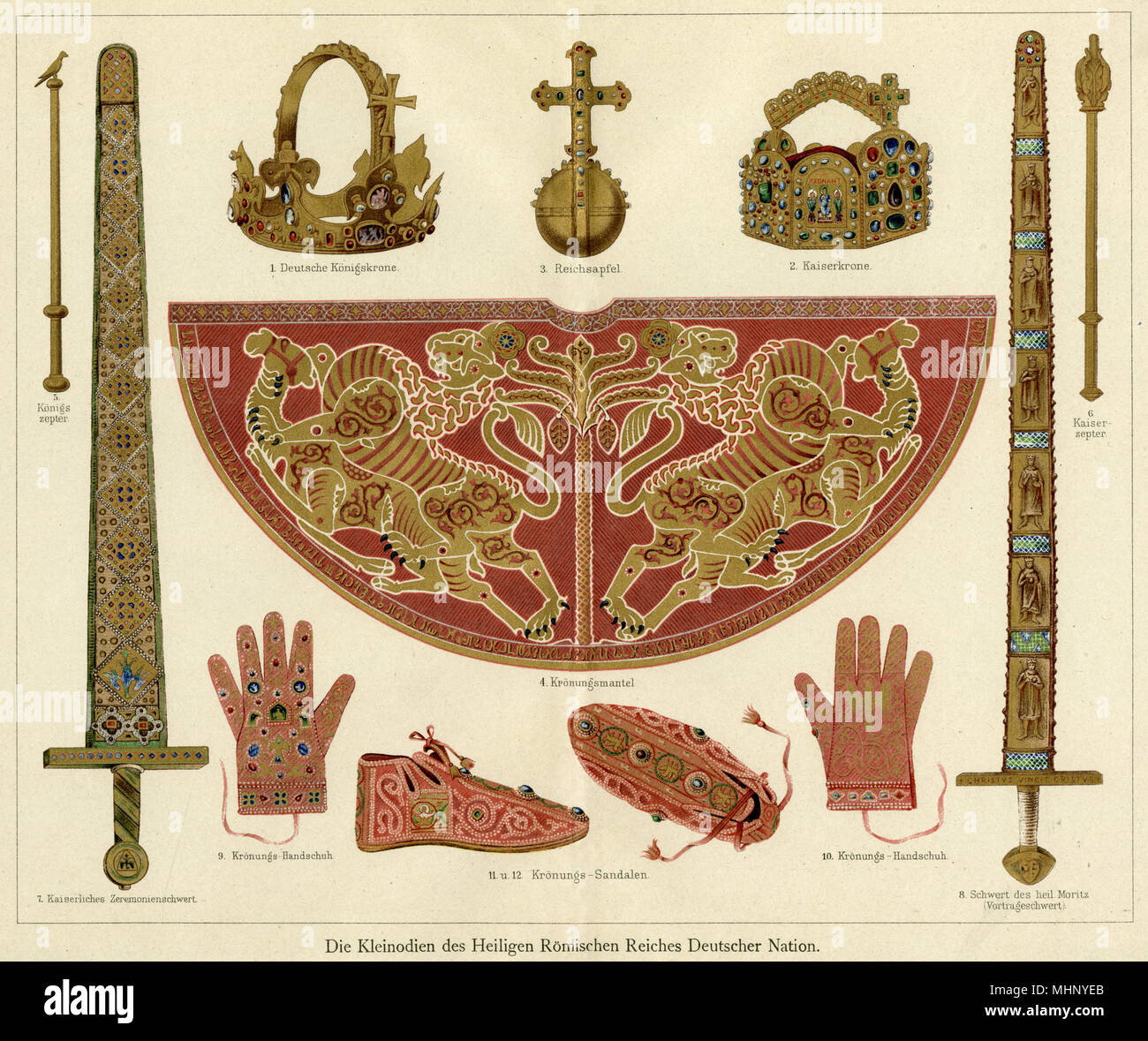 Some of the coronation regalia of the Holy Roman Empire of the German Nation: 1. German Royal Crown; 2. Imperial Crown; 3. Orb; 4. Coronation Robe; 5. King's Sceptre; 6. Imperial Sceptre; 7. Imperial Ceremonial Sword; 8. Sword of Saint Moritz; 9/10. Coronation Gloves; 11/12. Coronation Sandals. Date: medieval Stock Photohttps://www.alamy.com/image-license-details/?v=1https://www.alamy.com/some-of-the-coronation-regalia-of-the-holy-roman-empire-of-the-german-nation-1-german-royal-crown-2-imperial-crown-3-orb-4-coronation-robe-5-kings-sceptre-6-imperial-sceptre-7-imperial-ceremonial-sword-8-sword-of-saint-moritz-910-coronation-gloves-1112-coronation-sandals-date-medieval-image183035395.html
Some of the coronation regalia of the Holy Roman Empire of the German Nation: 1. German Royal Crown; 2. Imperial Crown; 3. Orb; 4. Coronation Robe; 5. King's Sceptre; 6. Imperial Sceptre; 7. Imperial Ceremonial Sword; 8. Sword of Saint Moritz; 9/10. Coronation Gloves; 11/12. Coronation Sandals. Date: medieval Stock Photohttps://www.alamy.com/image-license-details/?v=1https://www.alamy.com/some-of-the-coronation-regalia-of-the-holy-roman-empire-of-the-german-nation-1-german-royal-crown-2-imperial-crown-3-orb-4-coronation-robe-5-kings-sceptre-6-imperial-sceptre-7-imperial-ceremonial-sword-8-sword-of-saint-moritz-910-coronation-gloves-1112-coronation-sandals-date-medieval-image183035395.htmlRMMHNYEB–Some of the coronation regalia of the Holy Roman Empire of the German Nation: 1. German Royal Crown; 2. Imperial Crown; 3. Orb; 4. Coronation Robe; 5. King's Sceptre; 6. Imperial Sceptre; 7. Imperial Ceremonial Sword; 8. Sword of Saint Moritz; 9/10. Coronation Gloves; 11/12. Coronation Sandals. Date: medieval
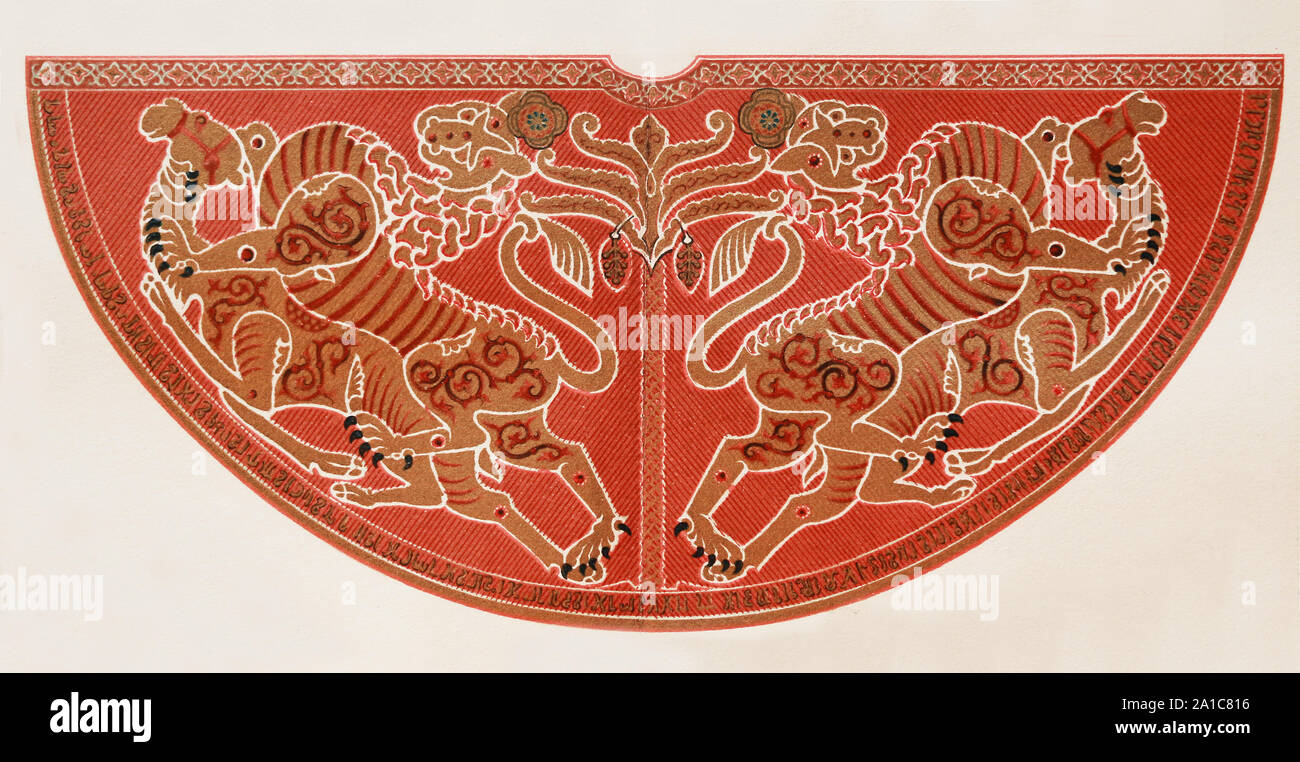 Coronation Mantle of the Holy Roman Empire. Stock Photohttps://www.alamy.com/image-license-details/?v=1https://www.alamy.com/coronation-mantle-of-the-holy-roman-empire-image327881378.html
Coronation Mantle of the Holy Roman Empire. Stock Photohttps://www.alamy.com/image-license-details/?v=1https://www.alamy.com/coronation-mantle-of-the-holy-roman-empire-image327881378.htmlRM2A1C816–Coronation Mantle of the Holy Roman Empire.
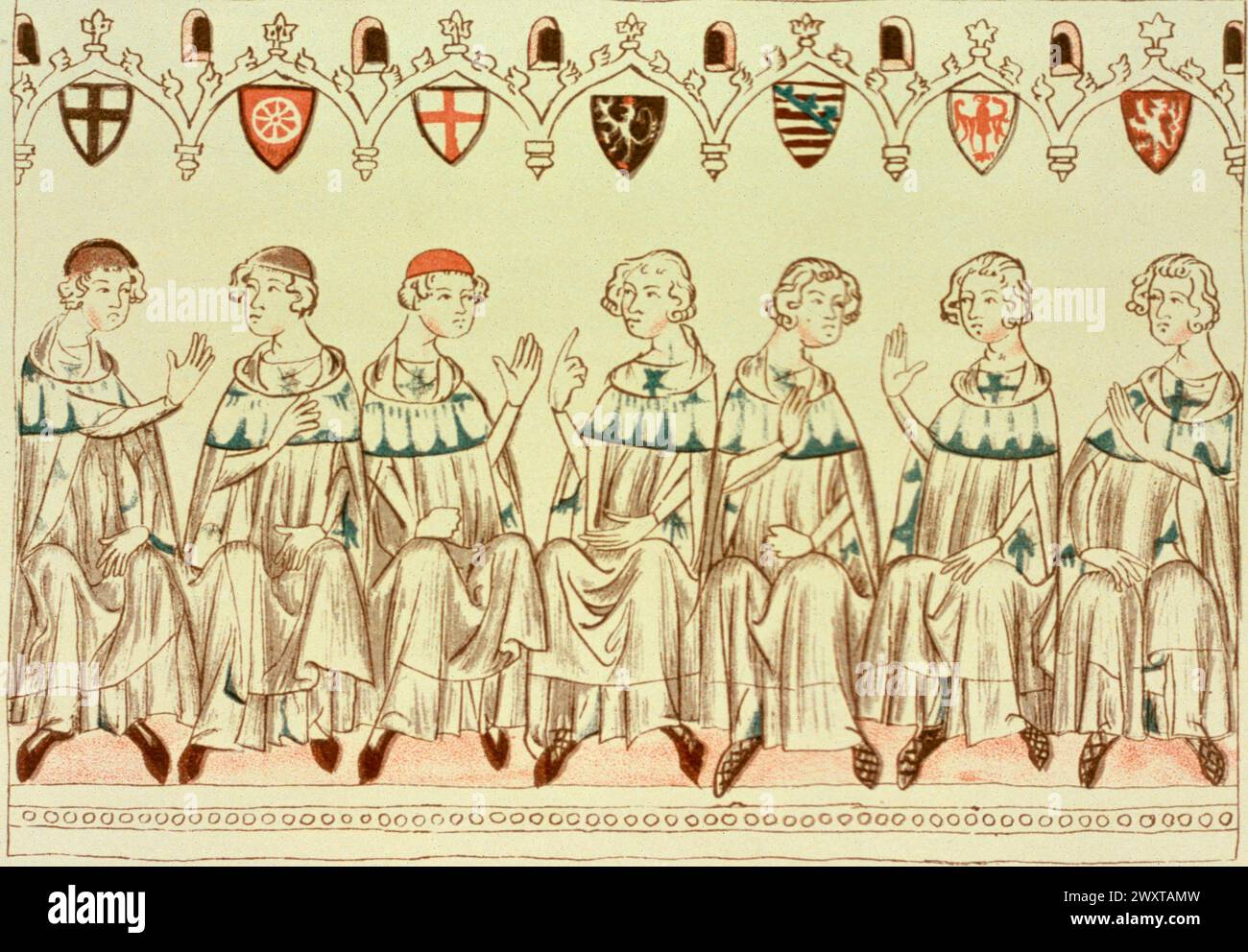 Electors of the Holy Roman Empire in council during the election of Henry VII, illustration from a manuscript, 1300s Stock Photohttps://www.alamy.com/image-license-details/?v=1https://www.alamy.com/electors-of-the-holy-roman-empire-in-council-during-the-election-of-henry-vii-illustration-from-a-manuscript-1300s-image601668841.html
Electors of the Holy Roman Empire in council during the election of Henry VII, illustration from a manuscript, 1300s Stock Photohttps://www.alamy.com/image-license-details/?v=1https://www.alamy.com/electors-of-the-holy-roman-empire-in-council-during-the-election-of-henry-vii-illustration-from-a-manuscript-1300s-image601668841.htmlRF2WXTAMW–Electors of the Holy Roman Empire in council during the election of Henry VII, illustration from a manuscript, 1300s
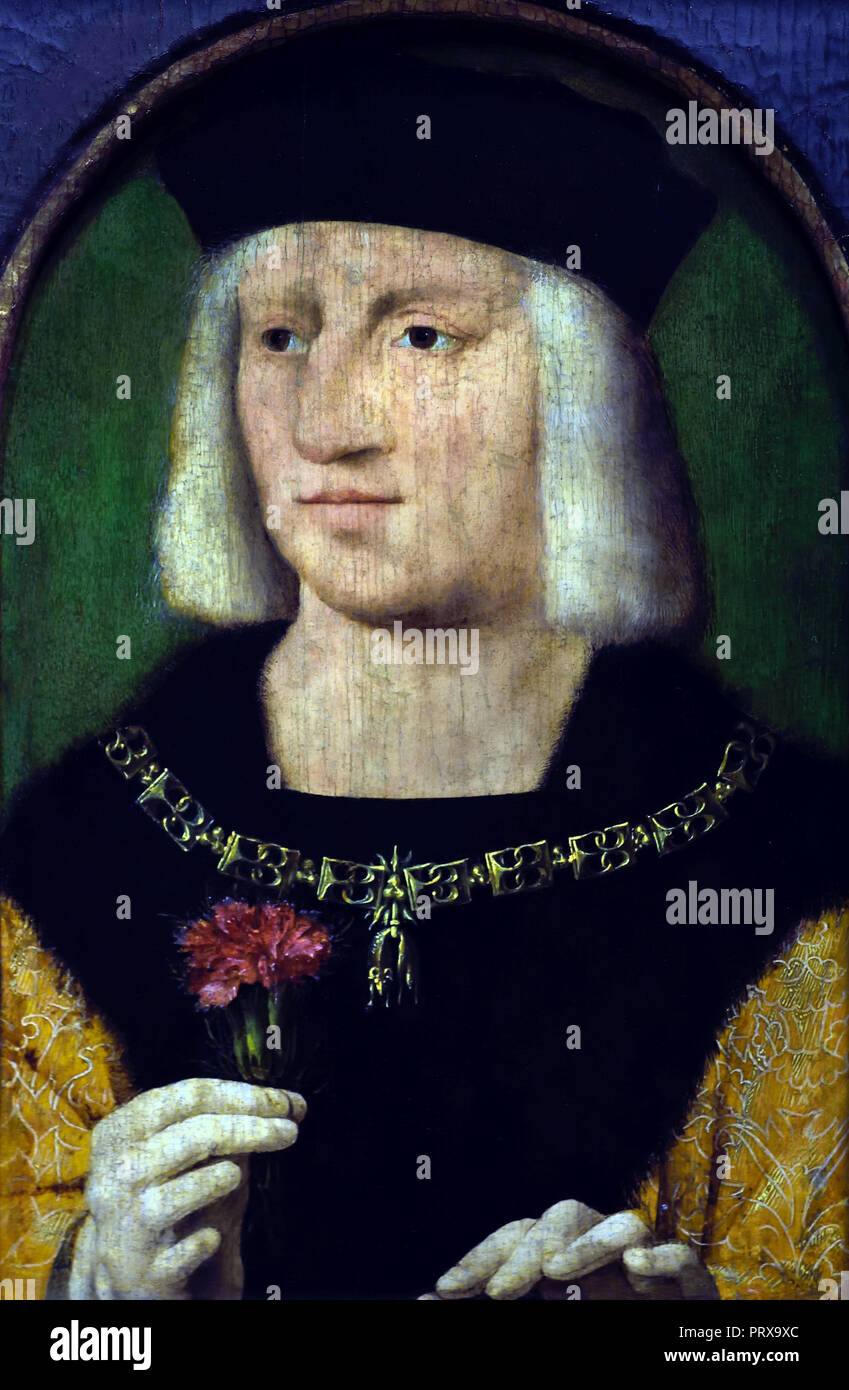 Portrait of the Holy Roman Emperor Maximilian I 1459-1519 Germany ( Roman-German King, and from 1508 emperor of the Holy Roman Empire). painter Joos van Cleve 1487-1541 Dutch the Netherlands Stock Photohttps://www.alamy.com/image-license-details/?v=1https://www.alamy.com/portrait-of-the-holy-roman-emperor-maximilian-i-1459-1519-germany-roman-german-king-and-from-1508-emperor-of-the-holy-roman-empire-painter-joos-van-cleve-1487-1541-dutch-the-netherlands-image221240052.html
Portrait of the Holy Roman Emperor Maximilian I 1459-1519 Germany ( Roman-German King, and from 1508 emperor of the Holy Roman Empire). painter Joos van Cleve 1487-1541 Dutch the Netherlands Stock Photohttps://www.alamy.com/image-license-details/?v=1https://www.alamy.com/portrait-of-the-holy-roman-emperor-maximilian-i-1459-1519-germany-roman-german-king-and-from-1508-emperor-of-the-holy-roman-empire-painter-joos-van-cleve-1487-1541-dutch-the-netherlands-image221240052.htmlRMPRX9XC–Portrait of the Holy Roman Emperor Maximilian I 1459-1519 Germany ( Roman-German King, and from 1508 emperor of the Holy Roman Empire). painter Joos van Cleve 1487-1541 Dutch the Netherlands
 HOLY ROMAN EMPIRE 1519: Europe upon Accession of Emperor Charles V, 1902 map Stock Photohttps://www.alamy.com/image-license-details/?v=1https://www.alamy.com/stock-photo-holy-roman-empire-1519-europe-upon-accession-of-emperor-charles-v-94077080.html
HOLY ROMAN EMPIRE 1519: Europe upon Accession of Emperor Charles V, 1902 map Stock Photohttps://www.alamy.com/image-license-details/?v=1https://www.alamy.com/stock-photo-holy-roman-empire-1519-europe-upon-accession-of-emperor-charles-v-94077080.htmlRFFD1G7M–HOLY ROMAN EMPIRE 1519: Europe upon Accession of Emperor Charles V, 1902 map
 The coronation of Charlemagne as Emperor of the Holy Roman Empire by Pope Leo III in 800. Charlemagne, aka Charles the Great, 747 - 814. Member of the Carolingian dynasty,King of the Franks from 768, King of the Lombards from 774, and the first Holy Roman Emperor from 800. From Histoire de France, published 1855. Stock Photohttps://www.alamy.com/image-license-details/?v=1https://www.alamy.com/the-coronation-of-charlemagne-as-emperor-of-the-holy-roman-empire-by-pope-leo-iii-in-800-charlemagne-aka-charles-the-great-747-814-member-of-the-carolingian-dynastyking-of-the-franks-from-768-king-of-the-lombards-from-774-and-the-first-holy-roman-emperor-from-800-from-histoire-de-france-published-1855-image474411496.html
The coronation of Charlemagne as Emperor of the Holy Roman Empire by Pope Leo III in 800. Charlemagne, aka Charles the Great, 747 - 814. Member of the Carolingian dynasty,King of the Franks from 768, King of the Lombards from 774, and the first Holy Roman Emperor from 800. From Histoire de France, published 1855. Stock Photohttps://www.alamy.com/image-license-details/?v=1https://www.alamy.com/the-coronation-of-charlemagne-as-emperor-of-the-holy-roman-empire-by-pope-leo-iii-in-800-charlemagne-aka-charles-the-great-747-814-member-of-the-carolingian-dynastyking-of-the-franks-from-768-king-of-the-lombards-from-774-and-the-first-holy-roman-emperor-from-800-from-histoire-de-france-published-1855-image474411496.htmlRM2JFR8KM–The coronation of Charlemagne as Emperor of the Holy Roman Empire by Pope Leo III in 800. Charlemagne, aka Charles the Great, 747 - 814. Member of the Carolingian dynasty,King of the Franks from 768, King of the Lombards from 774, and the first Holy Roman Emperor from 800. From Histoire de France, published 1855.
 Charles V, Holy Roman Emperor (1500-1558) on engraving from 1859. Emperor of the Holy Roman Empire. Engraved by C.Muller and published in Meyers Konve Stock Photohttps://www.alamy.com/image-license-details/?v=1https://www.alamy.com/charles-v-holy-roman-emperor-1500-1558-on-engraving-from-1859-emperor-of-the-holy-roman-empire-engraved-by-cmuller-and-published-in-meyers-konve-image622849663.html
Charles V, Holy Roman Emperor (1500-1558) on engraving from 1859. Emperor of the Holy Roman Empire. Engraved by C.Muller and published in Meyers Konve Stock Photohttps://www.alamy.com/image-license-details/?v=1https://www.alamy.com/charles-v-holy-roman-emperor-1500-1558-on-engraving-from-1859-emperor-of-the-holy-roman-empire-engraved-by-cmuller-and-published-in-meyers-konve-image622849663.htmlRF2Y5972R–Charles V, Holy Roman Emperor (1500-1558) on engraving from 1859. Emperor of the Holy Roman Empire. Engraved by C.Muller and published in Meyers Konve
 Matthias, 1557-1617, Emperor of the Holy Roman Empire, Historische Zeichnung aus dem 19. Jahrhundert, Portrait von Matthias, 155 Stock Photohttps://www.alamy.com/image-license-details/?v=1https://www.alamy.com/stock-photo-matthias-1557-1617-emperor-of-the-holy-roman-empire-historische-zeichnung-48134125.html
Matthias, 1557-1617, Emperor of the Holy Roman Empire, Historische Zeichnung aus dem 19. Jahrhundert, Portrait von Matthias, 155 Stock Photohttps://www.alamy.com/image-license-details/?v=1https://www.alamy.com/stock-photo-matthias-1557-1617-emperor-of-the-holy-roman-empire-historische-zeichnung-48134125.htmlRMCP8KFW–Matthias, 1557-1617, Emperor of the Holy Roman Empire, Historische Zeichnung aus dem 19. Jahrhundert, Portrait von Matthias, 155
 Germany, principality of Weimar, announcement the election of the emperor of the Holy Roman Empire of the German nation Franz II. at the 14th July of 1792, to read in all churches of the principality. Front side of the dukument., Stock Photohttps://www.alamy.com/image-license-details/?v=1https://www.alamy.com/stock-photo-germany-principality-of-weimar-announcement-the-election-of-the-emperor-95737431.html
Germany, principality of Weimar, announcement the election of the emperor of the Holy Roman Empire of the German nation Franz II. at the 14th July of 1792, to read in all churches of the principality. Front side of the dukument., Stock Photohttps://www.alamy.com/image-license-details/?v=1https://www.alamy.com/stock-photo-germany-principality-of-weimar-announcement-the-election-of-the-emperor-95737431.htmlRMFFN61Y–Germany, principality of Weimar, announcement the election of the emperor of the Holy Roman Empire of the German nation Franz II. at the 14th July of 1792, to read in all churches of the principality. Front side of the dukument.,
 Charlemagne (742-814). King of the Franks (768-814), king of the Lombards (774-814), and emperor of the Holy Roman Empire (800-814). Portrait. Facsimile of a late 16th century engraving. 'Moeurs, usages et costumes au moyen-âge et à l'époque de la Renaissance', by Paul Lacroix. Paris, 1878. Stock Photohttps://www.alamy.com/image-license-details/?v=1https://www.alamy.com/charlemagne-742-814-king-of-the-franks-768-814-king-of-the-lombards-774-814-and-emperor-of-the-holy-roman-empire-800-814-portrait-facsimile-of-a-late-16th-century-engraving-moeurs-usages-et-costumes-au-moyen-ge-et-lpoque-de-la-renaissance-by-paul-lacroix-paris-1878-image601785438.html
Charlemagne (742-814). King of the Franks (768-814), king of the Lombards (774-814), and emperor of the Holy Roman Empire (800-814). Portrait. Facsimile of a late 16th century engraving. 'Moeurs, usages et costumes au moyen-âge et à l'époque de la Renaissance', by Paul Lacroix. Paris, 1878. Stock Photohttps://www.alamy.com/image-license-details/?v=1https://www.alamy.com/charlemagne-742-814-king-of-the-franks-768-814-king-of-the-lombards-774-814-and-emperor-of-the-holy-roman-empire-800-814-portrait-facsimile-of-a-late-16th-century-engraving-moeurs-usages-et-costumes-au-moyen-ge-et-lpoque-de-la-renaissance-by-paul-lacroix-paris-1878-image601785438.htmlRM2WY1KD2–Charlemagne (742-814). King of the Franks (768-814), king of the Lombards (774-814), and emperor of the Holy Roman Empire (800-814). Portrait. Facsimile of a late 16th century engraving. 'Moeurs, usages et costumes au moyen-âge et à l'époque de la Renaissance', by Paul Lacroix. Paris, 1878.
 Maximilian I (1459-1519). Holy Roman Emperor. Engraving by Durer. The betrothal of Maximilian I with Mary of Burgundy. Detail. Stock Photohttps://www.alamy.com/image-license-details/?v=1https://www.alamy.com/maximilian-i-1459-1519-holy-roman-emperor-engraving-by-durer-the-betrothal-of-maximilian-i-with-mary-of-burgundy-detail-image230890344.html
Maximilian I (1459-1519). Holy Roman Emperor. Engraving by Durer. The betrothal of Maximilian I with Mary of Burgundy. Detail. Stock Photohttps://www.alamy.com/image-license-details/?v=1https://www.alamy.com/maximilian-i-1459-1519-holy-roman-emperor-engraving-by-durer-the-betrothal-of-maximilian-i-with-mary-of-burgundy-detail-image230890344.htmlRMRBHXYM–Maximilian I (1459-1519). Holy Roman Emperor. Engraving by Durer. The betrothal of Maximilian I with Mary of Burgundy. Detail.
 Matthias, Emperor of the Holy Roman Empire (1557-1619), Portrait of Matthias, German Emperor. Standing half-way, with scepter, imperial crown, and orb., Hans von Aachen (circle of), 1600 - 1625, canvas, oil paint (paint), h 104 cm × w 80 cm d 9.3 cm Stock Photohttps://www.alamy.com/image-license-details/?v=1https://www.alamy.com/matthias-emperor-of-the-holy-roman-empire-1557-1619-portrait-of-matthias-german-emperor-standing-half-way-with-scepter-imperial-crown-and-orb-hans-von-aachen-circle-of-1600-1625-canvas-oil-paint-paint-h-104-cm-w-80-cm-d-93-cm-image261408174.html
Matthias, Emperor of the Holy Roman Empire (1557-1619), Portrait of Matthias, German Emperor. Standing half-way, with scepter, imperial crown, and orb., Hans von Aachen (circle of), 1600 - 1625, canvas, oil paint (paint), h 104 cm × w 80 cm d 9.3 cm Stock Photohttps://www.alamy.com/image-license-details/?v=1https://www.alamy.com/matthias-emperor-of-the-holy-roman-empire-1557-1619-portrait-of-matthias-german-emperor-standing-half-way-with-scepter-imperial-crown-and-orb-hans-von-aachen-circle-of-1600-1625-canvas-oil-paint-paint-h-104-cm-w-80-cm-d-93-cm-image261408174.htmlRMW584P6–Matthias, Emperor of the Holy Roman Empire (1557-1619), Portrait of Matthias, German Emperor. Standing half-way, with scepter, imperial crown, and orb., Hans von Aachen (circle of), 1600 - 1625, canvas, oil paint (paint), h 104 cm × w 80 cm d 9.3 cm
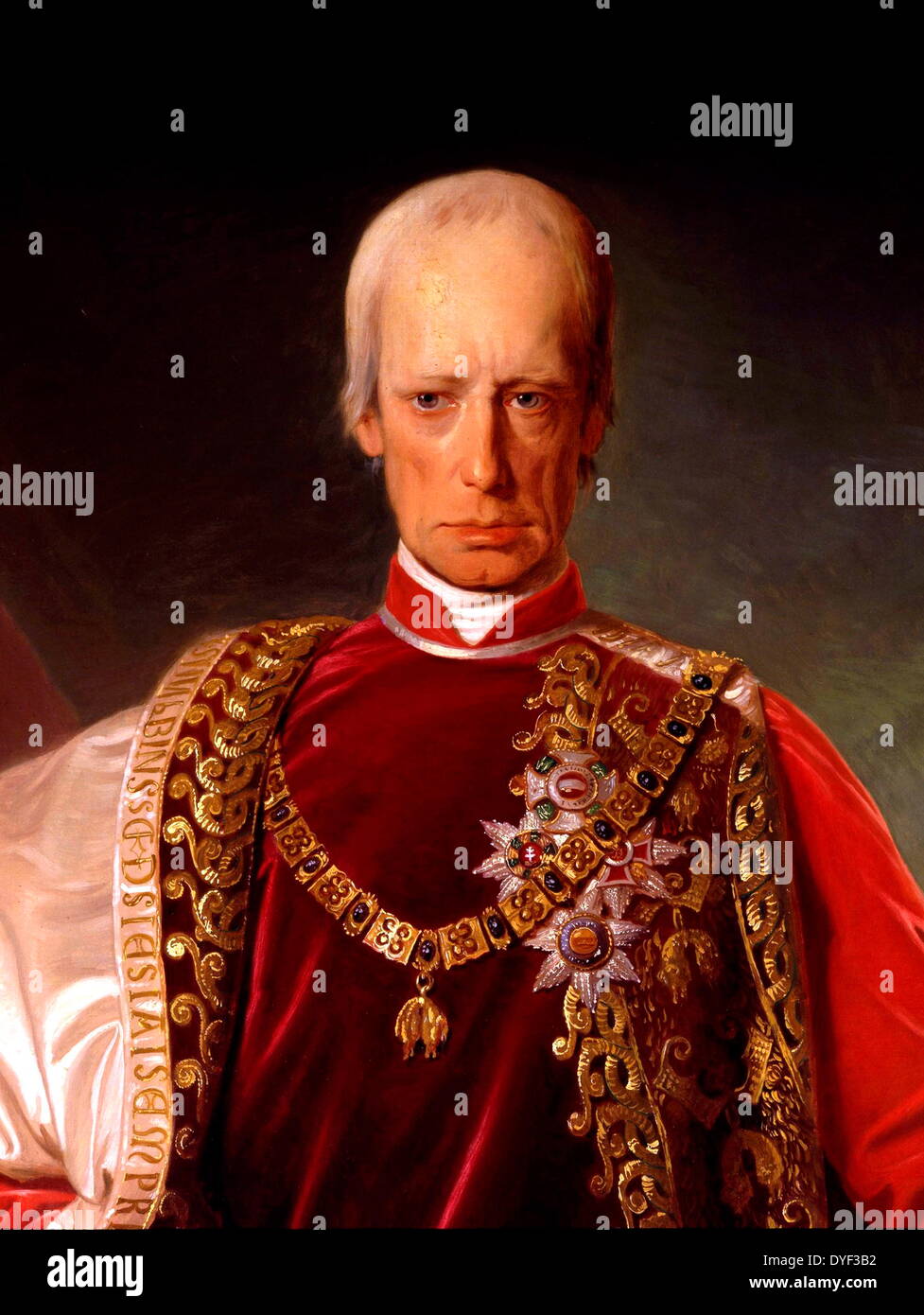 Portrait of Francis II, Holy Roman Emperor 1816. Stock Photohttps://www.alamy.com/image-license-details/?v=1https://www.alamy.com/portrait-of-francis-ii-holy-roman-emperor-1816-image68558758.html
Portrait of Francis II, Holy Roman Emperor 1816. Stock Photohttps://www.alamy.com/image-license-details/?v=1https://www.alamy.com/portrait-of-francis-ii-holy-roman-emperor-1816-image68558758.htmlRMDYF3B2–Portrait of Francis II, Holy Roman Emperor 1816.
 Otto I, 912 – 973, known as Otto the Great, German king emperor of the Holy Roman Empire Stock Photohttps://www.alamy.com/image-license-details/?v=1https://www.alamy.com/stock-image-otto-i-912-973-known-as-otto-the-great-german-king-emperor-of-the-163065474.html
Otto I, 912 – 973, known as Otto the Great, German king emperor of the Holy Roman Empire Stock Photohttps://www.alamy.com/image-license-details/?v=1https://www.alamy.com/stock-image-otto-i-912-973-known-as-otto-the-great-german-king-emperor-of-the-163065474.htmlRMKD87JX–Otto I, 912 – 973, known as Otto the Great, German king emperor of the Holy Roman Empire
 Francis II (1768-1835) Holy Roman Emperor from 1792. Francis I of Austria. Engraving Stock Photohttps://www.alamy.com/image-license-details/?v=1https://www.alamy.com/francis-ii-1768-1835-holy-roman-emperor-from-1792-francis-i-of-austria-engraving-image483535261.html
Francis II (1768-1835) Holy Roman Emperor from 1792. Francis I of Austria. Engraving Stock Photohttps://www.alamy.com/image-license-details/?v=1https://www.alamy.com/francis-ii-1768-1835-holy-roman-emperor-from-1792-francis-i-of-austria-engraving-image483535261.htmlRM2K2JX4D–Francis II (1768-1835) Holy Roman Emperor from 1792. Francis I of Austria. Engraving
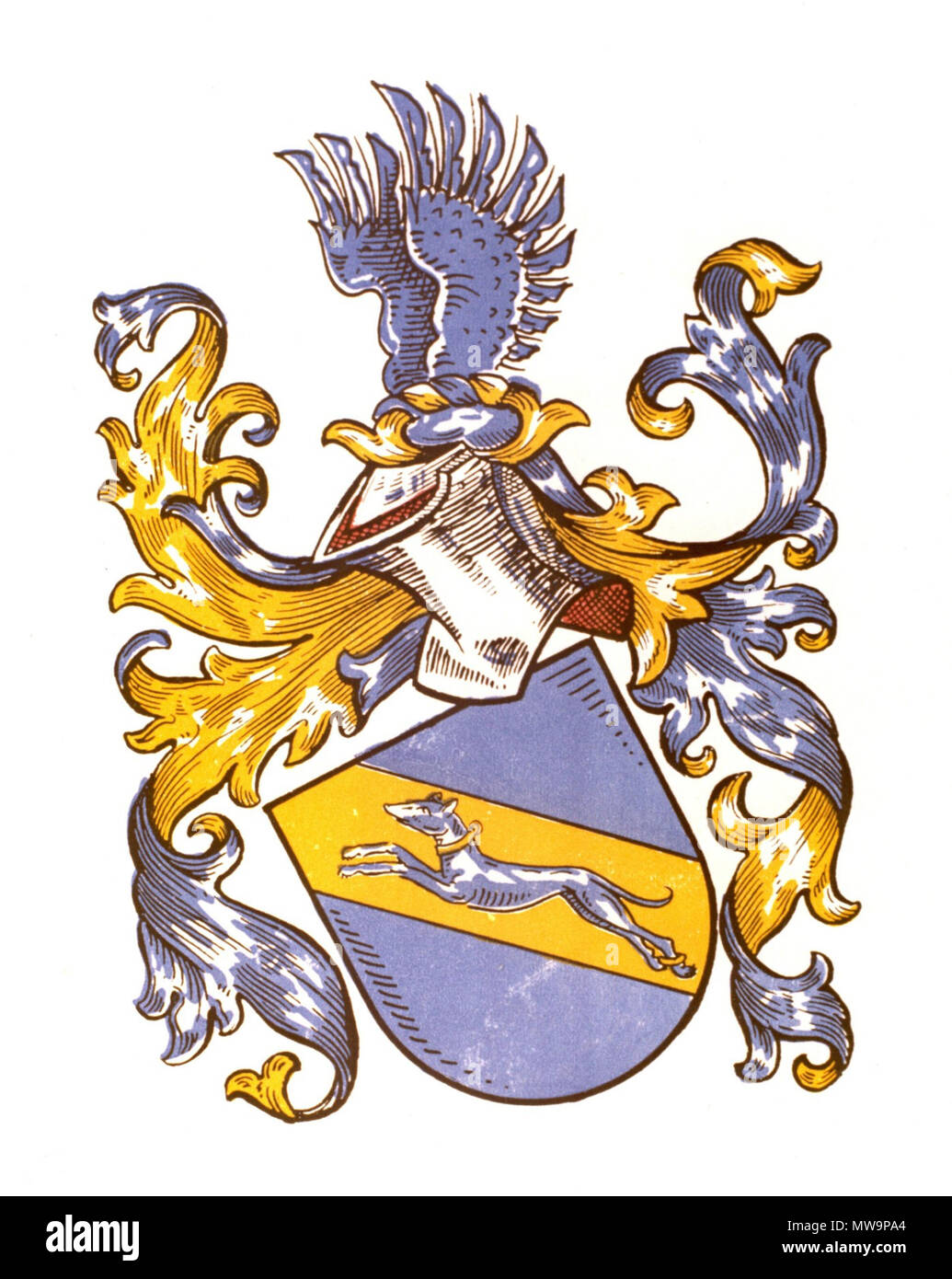 . Coat of arms given to Michael Huttenloch as reeve of Koengen (Baden-Wuerttemberg, Germany) by the Emperor of the Holy Roman Empire Ferdinand I. at the Imperial Diet at Augsburg in the year 1559 . before 1930. Unknown 135 Coat-of-arms-Michael-Huttenloch Stock Photohttps://www.alamy.com/image-license-details/?v=1https://www.alamy.com/coat-of-arms-given-to-michael-huttenloch-as-reeve-of-koengen-baden-wuerttemberg-germany-by-the-emperor-of-the-holy-roman-empire-ferdinand-i-at-the-imperial-diet-at-augsburg-in-the-year-1559-before-1930-unknown-135-coat-of-arms-michael-huttenloch-image187685180.html
. Coat of arms given to Michael Huttenloch as reeve of Koengen (Baden-Wuerttemberg, Germany) by the Emperor of the Holy Roman Empire Ferdinand I. at the Imperial Diet at Augsburg in the year 1559 . before 1930. Unknown 135 Coat-of-arms-Michael-Huttenloch Stock Photohttps://www.alamy.com/image-license-details/?v=1https://www.alamy.com/coat-of-arms-given-to-michael-huttenloch-as-reeve-of-koengen-baden-wuerttemberg-germany-by-the-emperor-of-the-holy-roman-empire-ferdinand-i-at-the-imperial-diet-at-augsburg-in-the-year-1559-before-1930-unknown-135-coat-of-arms-michael-huttenloch-image187685180.htmlRMMW9PA4–. Coat of arms given to Michael Huttenloch as reeve of Koengen (Baden-Wuerttemberg, Germany) by the Emperor of the Holy Roman Empire Ferdinand I. at the Imperial Diet at Augsburg in the year 1559 . before 1930. Unknown 135 Coat-of-arms-Michael-Huttenloch
 Portrait of Maximilian II (Vienna, July 31, 1527 - Regensburg, October 12, 1576), elected emperor of the Holy Roman Empire, King of Hungary Stock Photohttps://www.alamy.com/image-license-details/?v=1https://www.alamy.com/portrait-of-maximilian-ii-vienna-july-31-1527-regensburg-october-12-1576-elected-emperor-of-the-holy-roman-empire-king-of-hungary-image342956166.html
Portrait of Maximilian II (Vienna, July 31, 1527 - Regensburg, October 12, 1576), elected emperor of the Holy Roman Empire, King of Hungary Stock Photohttps://www.alamy.com/image-license-details/?v=1https://www.alamy.com/portrait-of-maximilian-ii-vienna-july-31-1527-regensburg-october-12-1576-elected-emperor-of-the-holy-roman-empire-king-of-hungary-image342956166.htmlRM2AWY02E–Portrait of Maximilian II (Vienna, July 31, 1527 - Regensburg, October 12, 1576), elected emperor of the Holy Roman Empire, King of Hungary
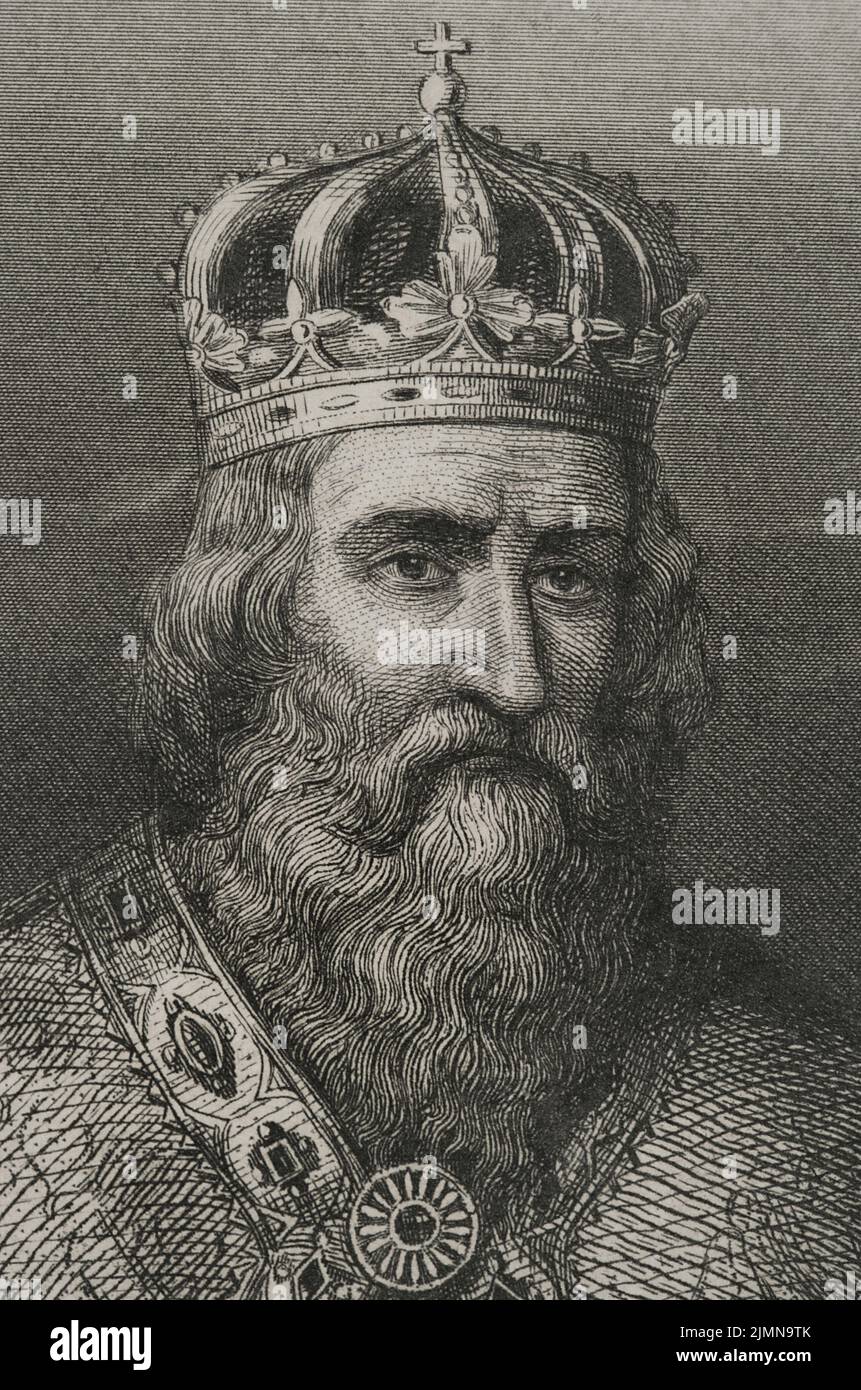 Charlemagne (742-814). King of the Franks (768-814), king of the Lombards (774-814), and emperor of the Holy Roman Empire (800-814). Portrait. Engraving. Detail. 'Historia Universal', by César Cantú. Volume III, 1855. Stock Photohttps://www.alamy.com/image-license-details/?v=1https://www.alamy.com/charlemagne-742-814-king-of-the-franks-768-814-king-of-the-lombards-774-814-and-emperor-of-the-holy-roman-empire-800-814-portrait-engraving-detail-historia-universal-by-csar-cant-volume-iii-1855-image477441795.html
Charlemagne (742-814). King of the Franks (768-814), king of the Lombards (774-814), and emperor of the Holy Roman Empire (800-814). Portrait. Engraving. Detail. 'Historia Universal', by César Cantú. Volume III, 1855. Stock Photohttps://www.alamy.com/image-license-details/?v=1https://www.alamy.com/charlemagne-742-814-king-of-the-franks-768-814-king-of-the-lombards-774-814-and-emperor-of-the-holy-roman-empire-800-814-portrait-engraving-detail-historia-universal-by-csar-cant-volume-iii-1855-image477441795.htmlRM2JMN9TK–Charlemagne (742-814). King of the Franks (768-814), king of the Lombards (774-814), and emperor of the Holy Roman Empire (800-814). Portrait. Engraving. Detail. 'Historia Universal', by César Cantú. Volume III, 1855.
 Charles V (1500-1558), Emperor of the Holy Roman Empire, in 1521, after a woodcut by Albrecht Dürer. From a pamphlet of Ulrich von Hutten, Albrecht Dürer 1899 Stock Photohttps://www.alamy.com/image-license-details/?v=1https://www.alamy.com/charles-v-1500-1558-emperor-of-the-holy-roman-empire-in-1521-after-a-woodcut-by-albrecht-drer-from-a-pamphlet-of-ulrich-von-hutten-albrecht-drer-1899-image223720061.html
Charles V (1500-1558), Emperor of the Holy Roman Empire, in 1521, after a woodcut by Albrecht Dürer. From a pamphlet of Ulrich von Hutten, Albrecht Dürer 1899 Stock Photohttps://www.alamy.com/image-license-details/?v=1https://www.alamy.com/charles-v-1500-1558-emperor-of-the-holy-roman-empire-in-1521-after-a-woodcut-by-albrecht-drer-from-a-pamphlet-of-ulrich-von-hutten-albrecht-drer-1899-image223720061.htmlRMPYY965–Charles V (1500-1558), Emperor of the Holy Roman Empire, in 1521, after a woodcut by Albrecht Dürer. From a pamphlet of Ulrich von Hutten, Albrecht Dürer 1899
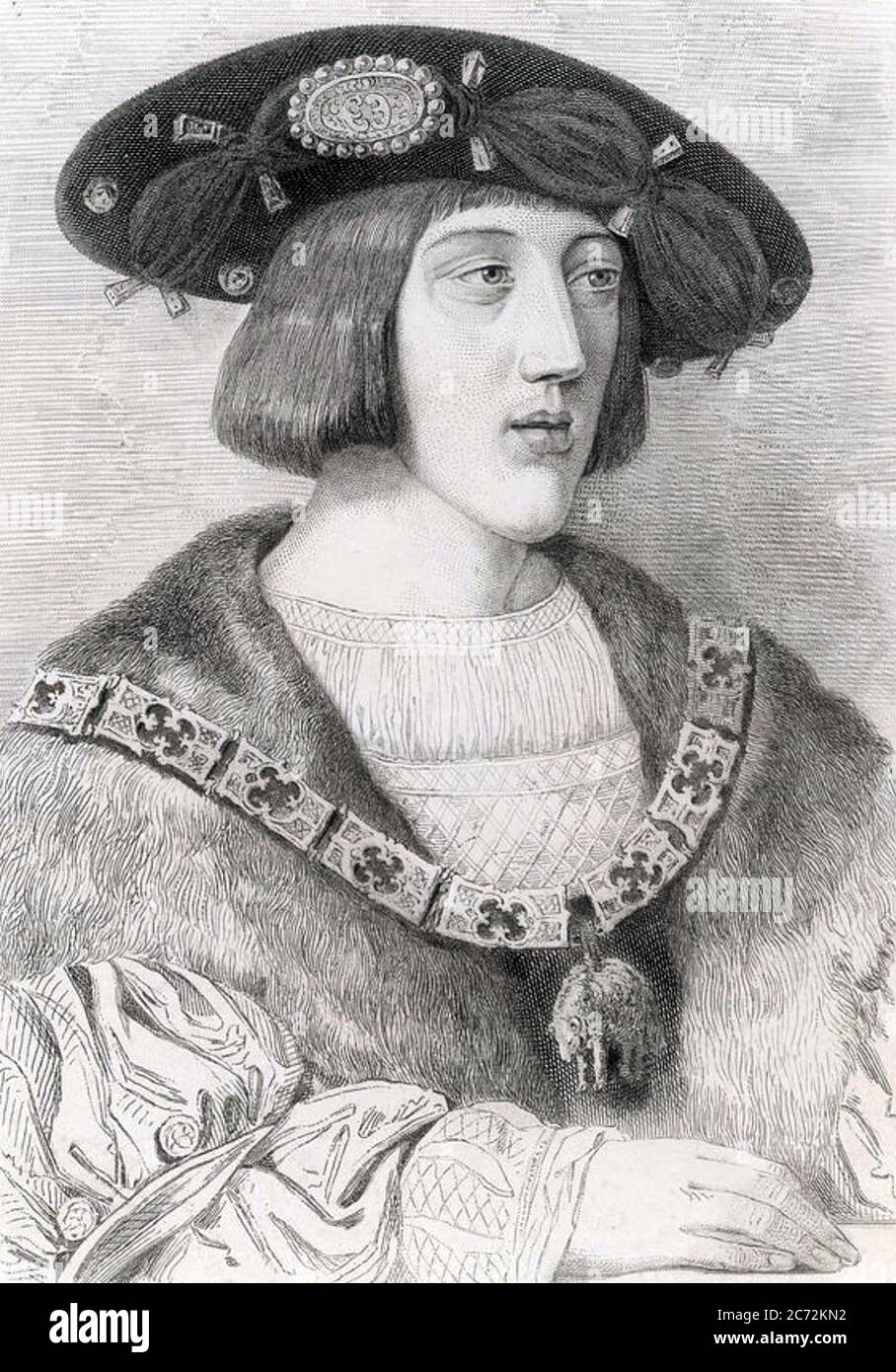 CHARLES V, Holy Roman Emperor (1500-1558) Stock Photohttps://www.alamy.com/image-license-details/?v=1https://www.alamy.com/charles-v-holy-roman-emperor-1500-1558-image365779710.html
CHARLES V, Holy Roman Emperor (1500-1558) Stock Photohttps://www.alamy.com/image-license-details/?v=1https://www.alamy.com/charles-v-holy-roman-emperor-1500-1558-image365779710.htmlRM2C72KN2–CHARLES V, Holy Roman Emperor (1500-1558)
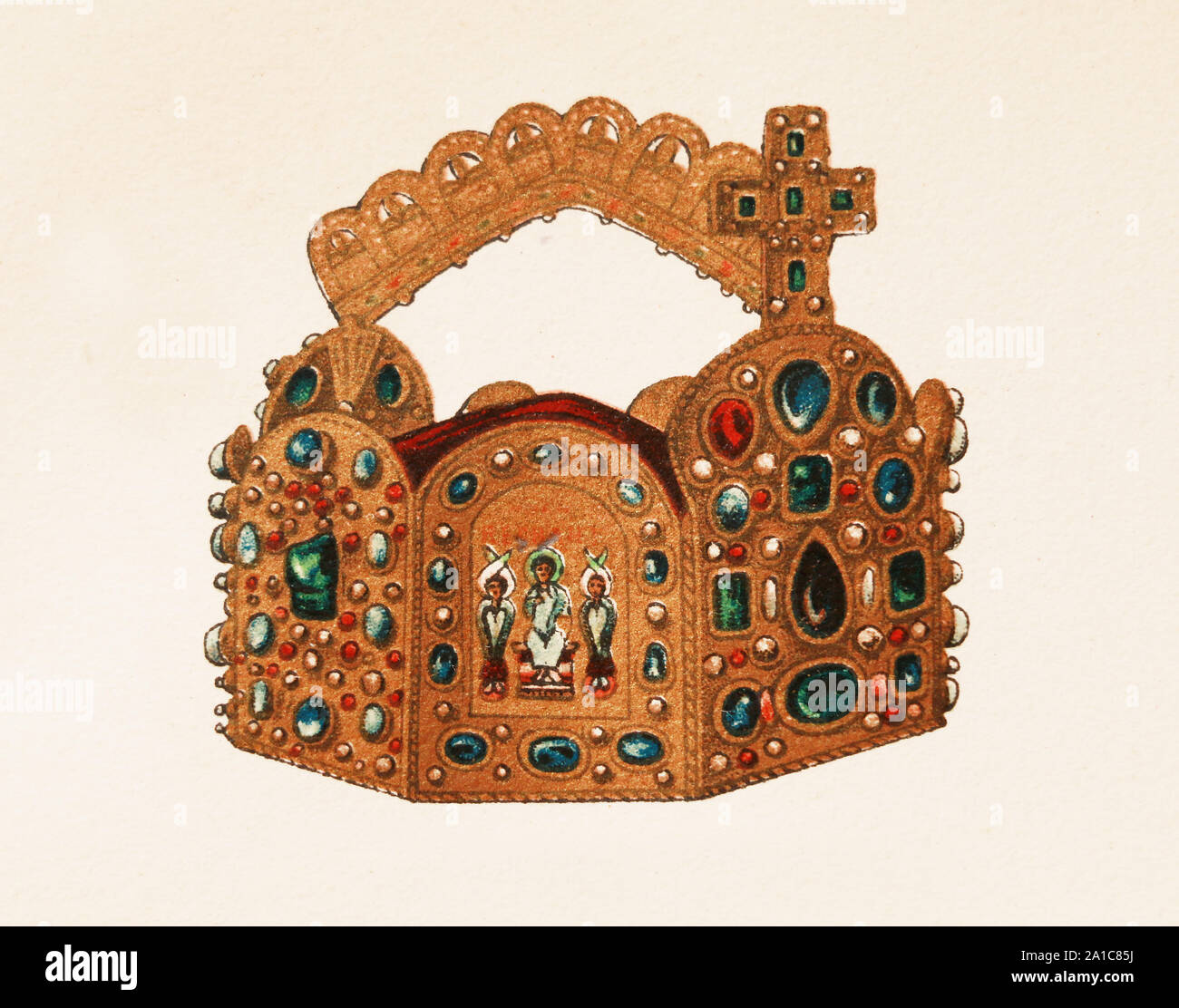 Imperial crown - relic of the Holy Roman Empire. Stock Photohttps://www.alamy.com/image-license-details/?v=1https://www.alamy.com/imperial-crown-relic-of-the-holy-roman-empire-image327881502.html
Imperial crown - relic of the Holy Roman Empire. Stock Photohttps://www.alamy.com/image-license-details/?v=1https://www.alamy.com/imperial-crown-relic-of-the-holy-roman-empire-image327881502.htmlRM2A1C85J–Imperial crown - relic of the Holy Roman Empire.
 Charles V, Holy Roman Emperor (1500-1558) on engraving from 1859. Emperor of the Holy Roman Empire. Stock Photohttps://www.alamy.com/image-license-details/?v=1https://www.alamy.com/stock-photo-charles-v-holy-roman-emperor-1500-1558-on-engraving-from-1859-emperor-50351147.html
Charles V, Holy Roman Emperor (1500-1558) on engraving from 1859. Emperor of the Holy Roman Empire. Stock Photohttps://www.alamy.com/image-license-details/?v=1https://www.alamy.com/stock-photo-charles-v-holy-roman-emperor-1500-1558-on-engraving-from-1859-emperor-50351147.htmlRFCWWKB7–Charles V, Holy Roman Emperor (1500-1558) on engraving from 1859. Emperor of the Holy Roman Empire.
 Allegory of the Abdication of Emperor Charles V Holy Roman Empire 1630 Frans Francken II 1581-1642 Belgian, Belgium, Flemish, ( Charles V is enthroned at centre. Battle weary and wracked by illness, in 1555 he divided up his empire. ) Stock Photohttps://www.alamy.com/image-license-details/?v=1https://www.alamy.com/allegory-of-the-abdication-of-emperor-charles-v-holy-roman-empire-1630-frans-francken-ii-1581-1642-belgian-belgium-flemish-charles-v-is-enthroned-at-centre-battle-weary-and-wracked-by-illness-in-1555-he-divided-up-his-empire-image376736026.html
Allegory of the Abdication of Emperor Charles V Holy Roman Empire 1630 Frans Francken II 1581-1642 Belgian, Belgium, Flemish, ( Charles V is enthroned at centre. Battle weary and wracked by illness, in 1555 he divided up his empire. ) Stock Photohttps://www.alamy.com/image-license-details/?v=1https://www.alamy.com/allegory-of-the-abdication-of-emperor-charles-v-holy-roman-empire-1630-frans-francken-ii-1581-1642-belgian-belgium-flemish-charles-v-is-enthroned-at-centre-battle-weary-and-wracked-by-illness-in-1555-he-divided-up-his-empire-image376736026.htmlRM2CTWPJ2–Allegory of the Abdication of Emperor Charles V Holy Roman Empire 1630 Frans Francken II 1581-1642 Belgian, Belgium, Flemish, ( Charles V is enthroned at centre. Battle weary and wracked by illness, in 1555 he divided up his empire. )
 Martin Luther's trial at the Diet of Worms, before Holy Roman Emperor Charles V. Stock Photohttps://www.alamy.com/image-license-details/?v=1https://www.alamy.com/martin-luthers-trial-at-the-diet-of-worms-before-holy-roman-emperor-charles-v-image552928194.html
Martin Luther's trial at the Diet of Worms, before Holy Roman Emperor Charles V. Stock Photohttps://www.alamy.com/image-license-details/?v=1https://www.alamy.com/martin-luthers-trial-at-the-diet-of-worms-before-holy-roman-emperor-charles-v-image552928194.htmlRM2R3G1FE–Martin Luther's trial at the Diet of Worms, before Holy Roman Emperor Charles V.
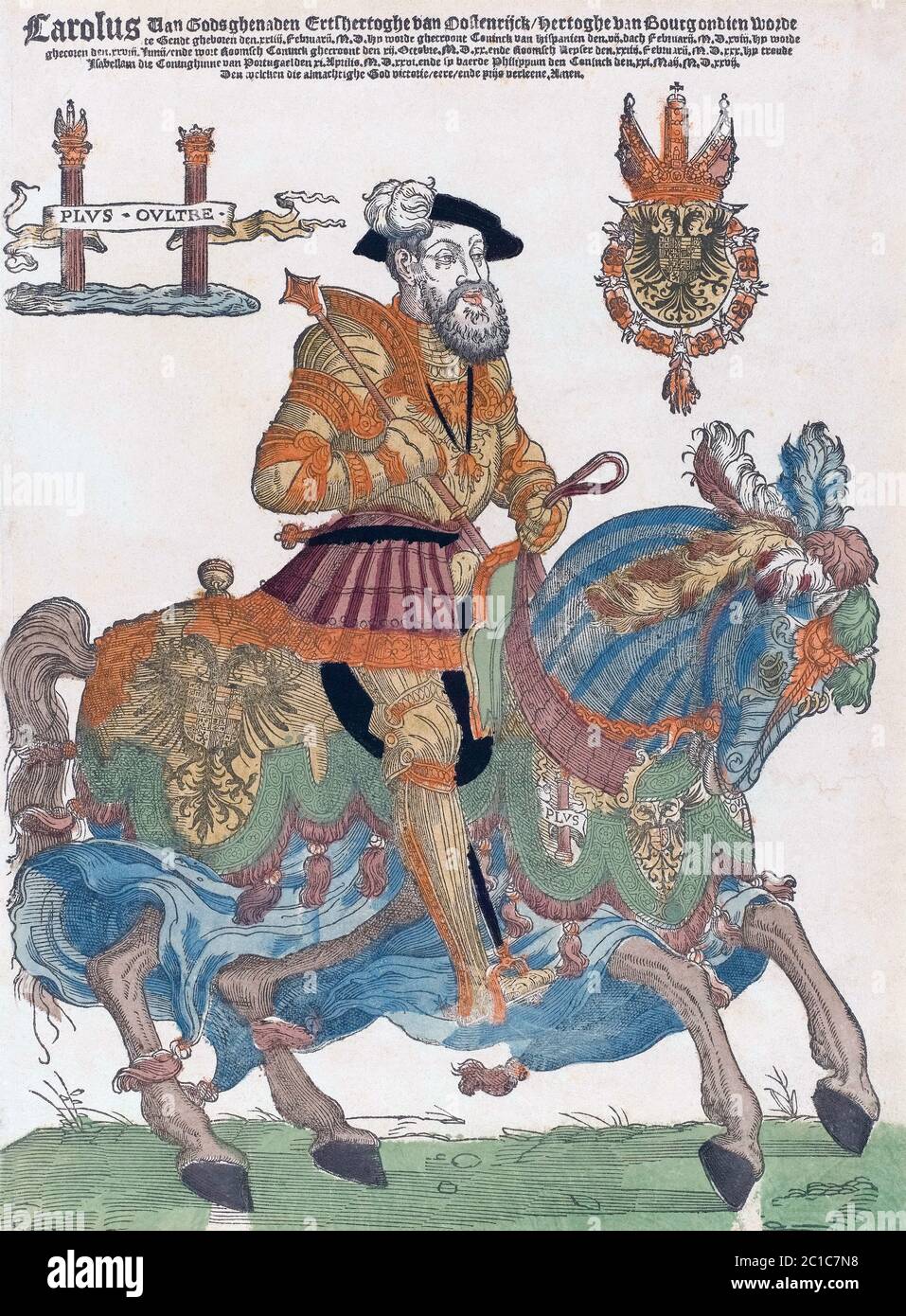 Charles V, 1500-1558. Emperor of the Holy Roman Empire. Carlos V. King of Spain as Charles I. Carlos I. After a work possibly by Cornelis Anthonisz. Stock Photohttps://www.alamy.com/image-license-details/?v=1https://www.alamy.com/charles-v-1500-1558-emperor-of-the-holy-roman-empire-carlos-v-king-of-spain-as-charles-i-carlos-i-after-a-work-possibly-by-cornelis-anthonisz-image362301892.html
Charles V, 1500-1558. Emperor of the Holy Roman Empire. Carlos V. King of Spain as Charles I. Carlos I. After a work possibly by Cornelis Anthonisz. Stock Photohttps://www.alamy.com/image-license-details/?v=1https://www.alamy.com/charles-v-1500-1558-emperor-of-the-holy-roman-empire-carlos-v-king-of-spain-as-charles-i-carlos-i-after-a-work-possibly-by-cornelis-anthonisz-image362301892.htmlRM2C1C7N8–Charles V, 1500-1558. Emperor of the Holy Roman Empire. Carlos V. King of Spain as Charles I. Carlos I. After a work possibly by Cornelis Anthonisz.
 Granada, Spain, August 14, 2011: Palace of Charles V in the Alhambra of Granada, Spain. Charles V, King of Spain and Emperor of the Holy Roman Empire Stock Photohttps://www.alamy.com/image-license-details/?v=1https://www.alamy.com/granada-spain-august-14-2011-palace-of-charles-v-in-the-alhambra-of-granada-spain-charles-v-king-of-spain-and-emperor-of-the-holy-roman-empire-image619442208.html
Granada, Spain, August 14, 2011: Palace of Charles V in the Alhambra of Granada, Spain. Charles V, King of Spain and Emperor of the Holy Roman Empire Stock Photohttps://www.alamy.com/image-license-details/?v=1https://www.alamy.com/granada-spain-august-14-2011-palace-of-charles-v-in-the-alhambra-of-granada-spain-charles-v-king-of-spain-and-emperor-of-the-holy-roman-empire-image619442208.htmlRM2XYP0T0–Granada, Spain, August 14, 2011: Palace of Charles V in the Alhambra of Granada, Spain. Charles V, King of Spain and Emperor of the Holy Roman Empire
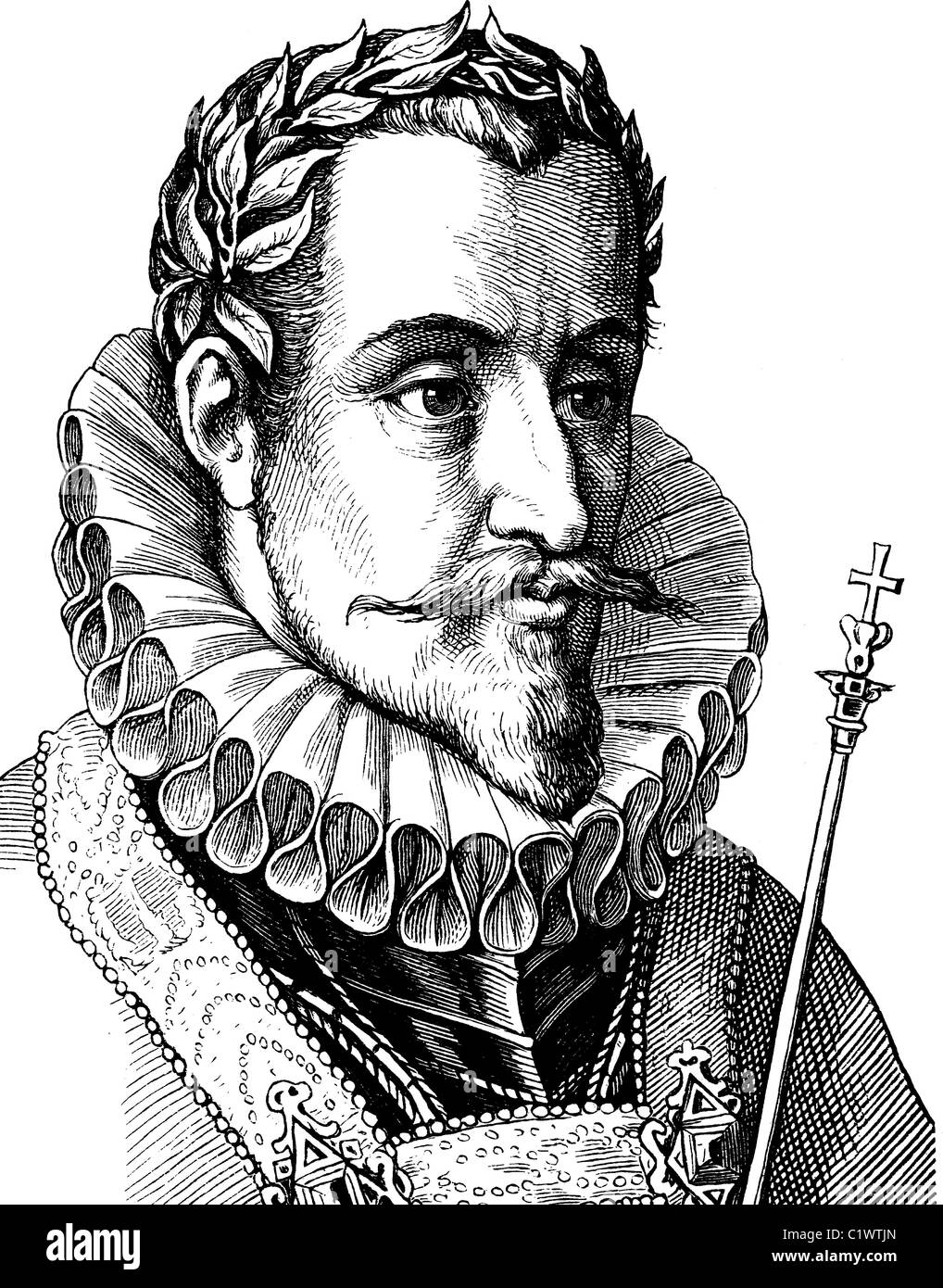 Digital improved image of Ferdinand I, German Emperor of the Holy Roman Empire, 1503 - 1564, historical illustration, portrait, Stock Photohttps://www.alamy.com/image-license-details/?v=1https://www.alamy.com/stock-photo-digital-improved-image-of-ferdinand-i-german-emperor-of-the-holy-roman-35603533.html
Digital improved image of Ferdinand I, German Emperor of the Holy Roman Empire, 1503 - 1564, historical illustration, portrait, Stock Photohttps://www.alamy.com/image-license-details/?v=1https://www.alamy.com/stock-photo-digital-improved-image-of-ferdinand-i-german-emperor-of-the-holy-roman-35603533.htmlRFC1WTJN–Digital improved image of Ferdinand I, German Emperor of the Holy Roman Empire, 1503 - 1564, historical illustration, portrait,
 A patent of nobility for the Schürer Family, granted by the Emperor Rudolf II (1576 - 1612) Large parchment certificate raising the Schürer family to the nobility. Dimensions 78 x 65 cm. Calligraphic text with a coat of arms in colour, granted at Prague on 1 July 1592, with the signature of Rudolf II, Emperor of the Holy Roman Empire of the German Nation, in his own hand. A notary's certification on the back from 1777. historic, historical, 16th century, Imperial, Austria, Austrian, Danube Monarchy, Empire, object, objects, stills, clipping, clip, Additional-Rights-Clearance-Info-Not-Available Stock Photohttps://www.alamy.com/image-license-details/?v=1https://www.alamy.com/a-patent-of-nobility-for-the-schrer-family-granted-by-the-emperor-rudolf-ii-1576-1612-large-parchment-certificate-raising-the-schrer-family-to-the-nobility-dimensions-78-x-65-cm-calligraphic-text-with-a-coat-of-arms-in-colour-granted-at-prague-on-1-july-1592-with-the-signature-of-rudolf-ii-emperor-of-the-holy-roman-empire-of-the-german-nation-in-his-own-hand-a-notarys-certification-on-the-back-from-1777-historic-historical-16th-century-imperial-austria-austrian-danube-monarchy-empire-object-objects-stills-clipping-clip-additional-rights-clearance-info-not-available-image243068594.html
A patent of nobility for the Schürer Family, granted by the Emperor Rudolf II (1576 - 1612) Large parchment certificate raising the Schürer family to the nobility. Dimensions 78 x 65 cm. Calligraphic text with a coat of arms in colour, granted at Prague on 1 July 1592, with the signature of Rudolf II, Emperor of the Holy Roman Empire of the German Nation, in his own hand. A notary's certification on the back from 1777. historic, historical, 16th century, Imperial, Austria, Austrian, Danube Monarchy, Empire, object, objects, stills, clipping, clip, Additional-Rights-Clearance-Info-Not-Available Stock Photohttps://www.alamy.com/image-license-details/?v=1https://www.alamy.com/a-patent-of-nobility-for-the-schrer-family-granted-by-the-emperor-rudolf-ii-1576-1612-large-parchment-certificate-raising-the-schrer-family-to-the-nobility-dimensions-78-x-65-cm-calligraphic-text-with-a-coat-of-arms-in-colour-granted-at-prague-on-1-july-1592-with-the-signature-of-rudolf-ii-emperor-of-the-holy-roman-empire-of-the-german-nation-in-his-own-hand-a-notarys-certification-on-the-back-from-1777-historic-historical-16th-century-imperial-austria-austrian-danube-monarchy-empire-object-objects-stills-clipping-clip-additional-rights-clearance-info-not-available-image243068594.htmlRMT3CMD6–A patent of nobility for the Schürer Family, granted by the Emperor Rudolf II (1576 - 1612) Large parchment certificate raising the Schürer family to the nobility. Dimensions 78 x 65 cm. Calligraphic text with a coat of arms in colour, granted at Prague on 1 July 1592, with the signature of Rudolf II, Emperor of the Holy Roman Empire of the German Nation, in his own hand. A notary's certification on the back from 1777. historic, historical, 16th century, Imperial, Austria, Austrian, Danube Monarchy, Empire, object, objects, stills, clipping, clip, Additional-Rights-Clearance-Info-Not-Available
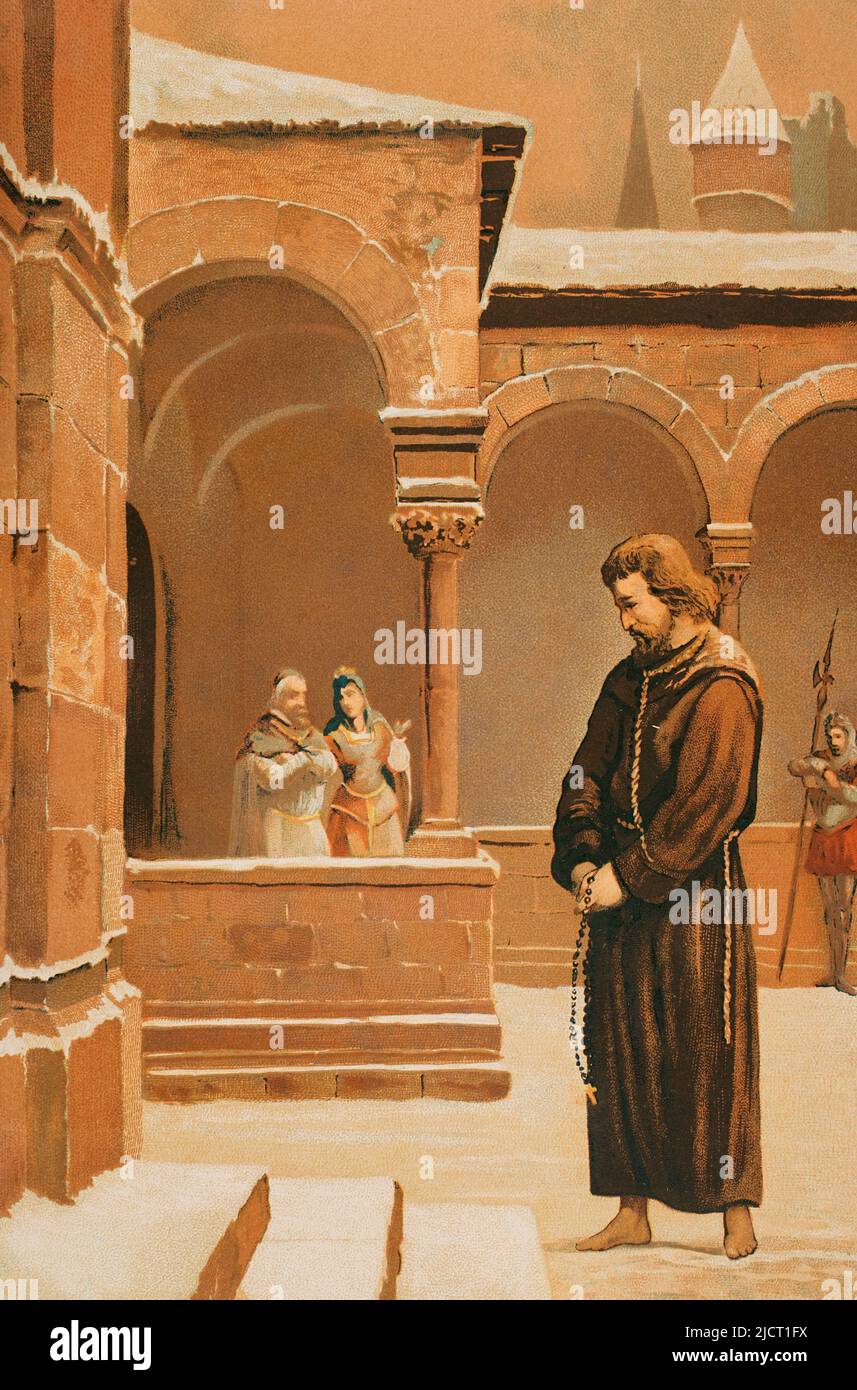 Henry IV (1050-1106). German king (1056-1105). Emperor of the Holy Roman Empire. Humiliation of Canossa (January 1077). Pope Gregory VII ordered Henry IV to present before him wearing the clothes of a penitent and barefoot, handing the crown to him, acknowledging that he was unworthy to wear it. After three days in the open, the Pope received him and absolved him, on condition that he would appear before the assembly of German princes, submitting any decision to the Pope's approval, and that he would not possess the authority and privileges of royal dignity. Penance of Henry IV. Chromolithogra Stock Photohttps://www.alamy.com/image-license-details/?v=1https://www.alamy.com/henry-iv-1050-1106-german-king-1056-1105-emperor-of-the-holy-roman-empire-humiliation-of-canossa-january-1077-pope-gregory-vii-ordered-henry-iv-to-present-before-him-wearing-the-clothes-of-a-penitent-and-barefoot-handing-the-crown-to-him-acknowledging-that-he-was-unworthy-to-wear-it-after-three-days-in-the-open-the-pope-received-him-and-absolved-him-on-condition-that-he-would-appear-before-the-assembly-of-german-princes-submitting-any-decision-to-the-popes-approval-and-that-he-would-not-possess-the-authority-and-privileges-of-royal-dignity-penance-of-henry-iv-chromolithogra-image472583886.html
Henry IV (1050-1106). German king (1056-1105). Emperor of the Holy Roman Empire. Humiliation of Canossa (January 1077). Pope Gregory VII ordered Henry IV to present before him wearing the clothes of a penitent and barefoot, handing the crown to him, acknowledging that he was unworthy to wear it. After three days in the open, the Pope received him and absolved him, on condition that he would appear before the assembly of German princes, submitting any decision to the Pope's approval, and that he would not possess the authority and privileges of royal dignity. Penance of Henry IV. Chromolithogra Stock Photohttps://www.alamy.com/image-license-details/?v=1https://www.alamy.com/henry-iv-1050-1106-german-king-1056-1105-emperor-of-the-holy-roman-empire-humiliation-of-canossa-january-1077-pope-gregory-vii-ordered-henry-iv-to-present-before-him-wearing-the-clothes-of-a-penitent-and-barefoot-handing-the-crown-to-him-acknowledging-that-he-was-unworthy-to-wear-it-after-three-days-in-the-open-the-pope-received-him-and-absolved-him-on-condition-that-he-would-appear-before-the-assembly-of-german-princes-submitting-any-decision-to-the-popes-approval-and-that-he-would-not-possess-the-authority-and-privileges-of-royal-dignity-penance-of-henry-iv-chromolithogra-image472583886.htmlRM2JCT1FX–Henry IV (1050-1106). German king (1056-1105). Emperor of the Holy Roman Empire. Humiliation of Canossa (January 1077). Pope Gregory VII ordered Henry IV to present before him wearing the clothes of a penitent and barefoot, handing the crown to him, acknowledging that he was unworthy to wear it. After three days in the open, the Pope received him and absolved him, on condition that he would appear before the assembly of German princes, submitting any decision to the Pope's approval, and that he would not possess the authority and privileges of royal dignity. Penance of Henry IV. Chromolithogra
![a servant, a pope and an emperor of the Holy Roman Empire in contemporary dress. [automated translation] Stock Photo a servant, a pope and an emperor of the Holy Roman Empire in contemporary dress. [automated translation] Stock Photo](https://c8.alamy.com/comp/2PYX60M/a-servant-a-pope-and-an-emperor-of-the-holy-roman-empire-in-contemporary-dress-automated-translation-2PYX60M.jpg) a servant, a pope and an emperor of the Holy Roman Empire in contemporary dress. [automated translation] Stock Photohttps://www.alamy.com/image-license-details/?v=1https://www.alamy.com/a-servant-a-pope-and-an-emperor-of-the-holy-roman-empire-in-contemporary-dress-automated-translation-image550692596.html
a servant, a pope and an emperor of the Holy Roman Empire in contemporary dress. [automated translation] Stock Photohttps://www.alamy.com/image-license-details/?v=1https://www.alamy.com/a-servant-a-pope-and-an-emperor-of-the-holy-roman-empire-in-contemporary-dress-automated-translation-image550692596.htmlRM2PYX60M–a servant, a pope and an emperor of the Holy Roman Empire in contemporary dress. [automated translation]
![Portrait of Maria Anna of Spain Ferdinandus II [us] and III [us] Imperatorum Domus Austriacae (series title), Portrait of Maria Anna of Spain, wife of the emperor of the Holy Roman Empire Ferdinand III, Maria Anna of Austria (German Empress), Jacob Louys (mentioned on object), Haarlem, 1644 - 1650, paper, etching, h 411 mm × w 278 mm Stock Photo Portrait of Maria Anna of Spain Ferdinandus II [us] and III [us] Imperatorum Domus Austriacae (series title), Portrait of Maria Anna of Spain, wife of the emperor of the Holy Roman Empire Ferdinand III, Maria Anna of Austria (German Empress), Jacob Louys (mentioned on object), Haarlem, 1644 - 1650, paper, etching, h 411 mm × w 278 mm Stock Photo](https://c8.alamy.com/comp/W57YR6/portrait-of-maria-anna-of-spain-ferdinandus-ii-us-and-iii-us-imperatorum-domus-austriacae-series-title-portrait-of-maria-anna-of-spain-wife-of-the-emperor-of-the-holy-roman-empire-ferdinand-iii-maria-anna-of-austria-german-empress-jacob-louys-mentioned-on-object-haarlem-1644-1650-paper-etching-h-411-mm-w-278-mm-W57YR6.jpg) Portrait of Maria Anna of Spain Ferdinandus II [us] and III [us] Imperatorum Domus Austriacae (series title), Portrait of Maria Anna of Spain, wife of the emperor of the Holy Roman Empire Ferdinand III, Maria Anna of Austria (German Empress), Jacob Louys (mentioned on object), Haarlem, 1644 - 1650, paper, etching, h 411 mm × w 278 mm Stock Photohttps://www.alamy.com/image-license-details/?v=1https://www.alamy.com/portrait-of-maria-anna-of-spain-ferdinandus-ii-us-and-iii-us-imperatorum-domus-austriacae-series-title-portrait-of-maria-anna-of-spain-wife-of-the-emperor-of-the-holy-roman-empire-ferdinand-iii-maria-anna-of-austria-german-empress-jacob-louys-mentioned-on-object-haarlem-1644-1650-paper-etching-h-411-mm-w-278-mm-image261404282.html
Portrait of Maria Anna of Spain Ferdinandus II [us] and III [us] Imperatorum Domus Austriacae (series title), Portrait of Maria Anna of Spain, wife of the emperor of the Holy Roman Empire Ferdinand III, Maria Anna of Austria (German Empress), Jacob Louys (mentioned on object), Haarlem, 1644 - 1650, paper, etching, h 411 mm × w 278 mm Stock Photohttps://www.alamy.com/image-license-details/?v=1https://www.alamy.com/portrait-of-maria-anna-of-spain-ferdinandus-ii-us-and-iii-us-imperatorum-domus-austriacae-series-title-portrait-of-maria-anna-of-spain-wife-of-the-emperor-of-the-holy-roman-empire-ferdinand-iii-maria-anna-of-austria-german-empress-jacob-louys-mentioned-on-object-haarlem-1644-1650-paper-etching-h-411-mm-w-278-mm-image261404282.htmlRMW57YR6–Portrait of Maria Anna of Spain Ferdinandus II [us] and III [us] Imperatorum Domus Austriacae (series title), Portrait of Maria Anna of Spain, wife of the emperor of the Holy Roman Empire Ferdinand III, Maria Anna of Austria (German Empress), Jacob Louys (mentioned on object), Haarlem, 1644 - 1650, paper, etching, h 411 mm × w 278 mm
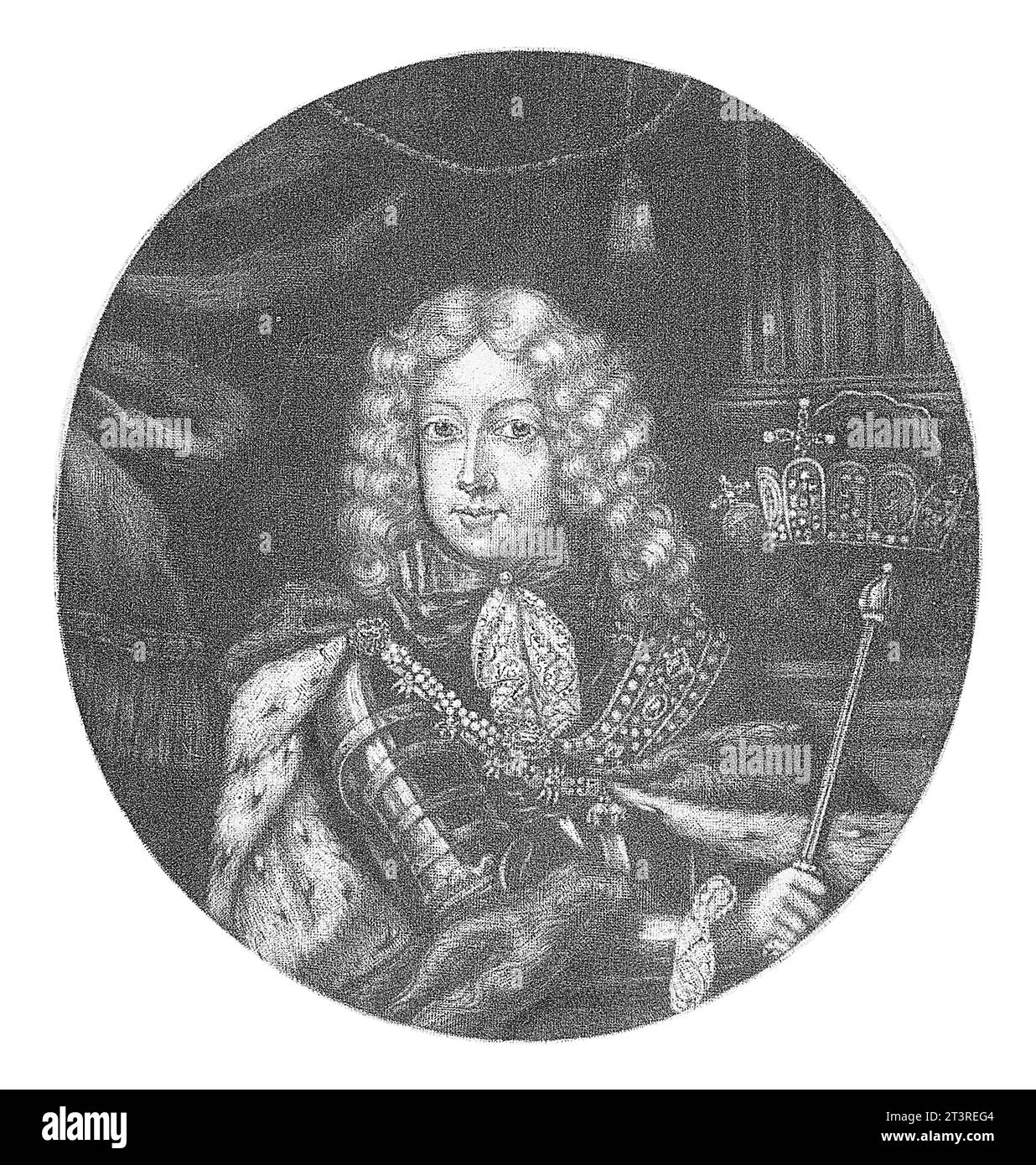 Portrait of Emperor Joseph I, Pieter Schenk (I), 1690 - 1713 Portrait of Joseph I, Emperor of the Holy Roman Empire and King of Hungary. Stock Photohttps://www.alamy.com/image-license-details/?v=1https://www.alamy.com/portrait-of-emperor-joseph-i-pieter-schenk-i-1690-1713-portrait-of-joseph-i-emperor-of-the-holy-roman-empire-and-king-of-hungary-image570302436.html
Portrait of Emperor Joseph I, Pieter Schenk (I), 1690 - 1713 Portrait of Joseph I, Emperor of the Holy Roman Empire and King of Hungary. Stock Photohttps://www.alamy.com/image-license-details/?v=1https://www.alamy.com/portrait-of-emperor-joseph-i-pieter-schenk-i-1690-1713-portrait-of-joseph-i-emperor-of-the-holy-roman-empire-and-king-of-hungary-image570302436.htmlRF2T3REG4–Portrait of Emperor Joseph I, Pieter Schenk (I), 1690 - 1713 Portrait of Joseph I, Emperor of the Holy Roman Empire and King of Hungary.
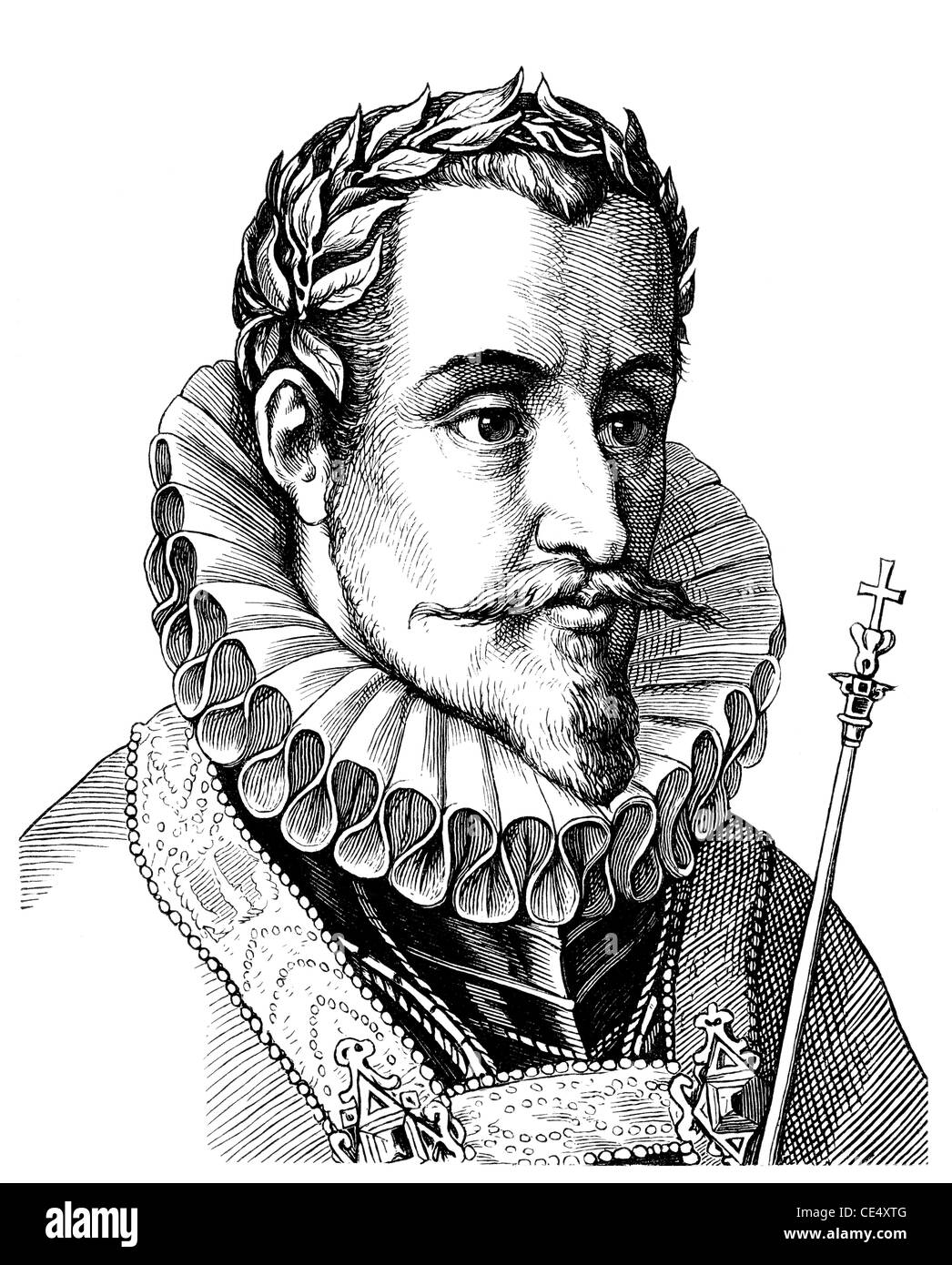 Ferdinand I, 1503 - 1564, Habsburg, Emperor of the Holy Roman Empire, Roman-German King Stock Photohttps://www.alamy.com/image-license-details/?v=1https://www.alamy.com/stock-photo-ferdinand-i-1503-1564-habsburg-emperor-of-the-holy-roman-empire-roman-43134800.html
Ferdinand I, 1503 - 1564, Habsburg, Emperor of the Holy Roman Empire, Roman-German King Stock Photohttps://www.alamy.com/image-license-details/?v=1https://www.alamy.com/stock-photo-ferdinand-i-1503-1564-habsburg-emperor-of-the-holy-roman-empire-roman-43134800.htmlRMCE4XTG–Ferdinand I, 1503 - 1564, Habsburg, Emperor of the Holy Roman Empire, Roman-German King
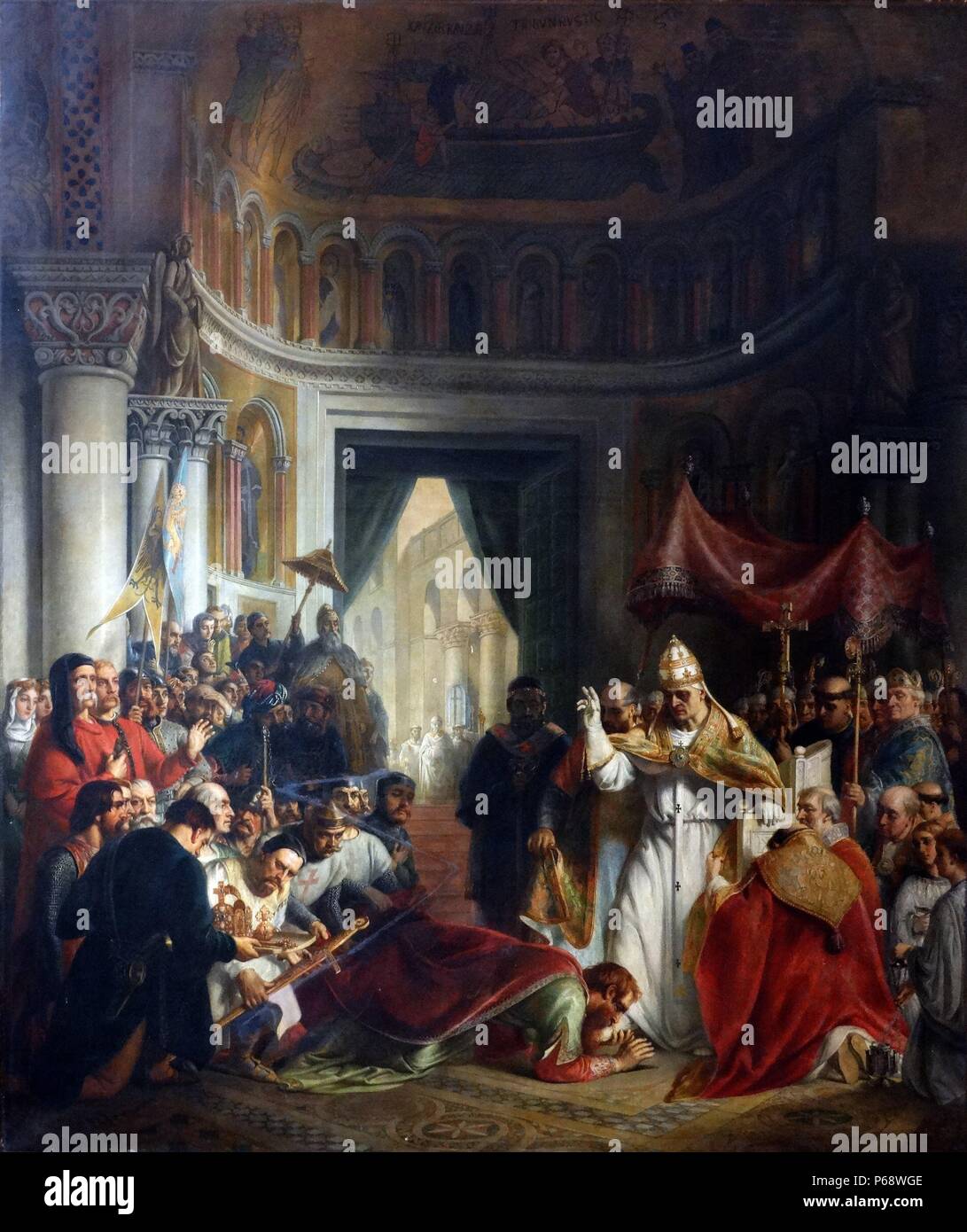 Submission of the emperor Barbarossa to Pope Alexander III; 1867 by Solomon Hart 1806-1881. Frederick I ; 1122 – 10 June 1190), known as Barbarossa, was the Holy Roman Emperor from 1155 until his death. Frederick had to humble himself before Alexander III at Venice. In 1177 The emperor acknowledged the pope's sovereignty over the Papal States, and in return Alexander acknowledged the emperor's over lordship of the Imperial Church Stock Photohttps://www.alamy.com/image-license-details/?v=1https://www.alamy.com/submission-of-the-emperor-barbarossa-to-pope-alexander-iii-1867-by-solomon-hart-1806-1881-frederick-i-1122-10-june-1190-known-as-barbarossa-was-the-holy-roman-emperor-from-1155-until-his-death-frederick-had-to-humble-himself-before-alexander-iii-at-venice-in-1177-the-emperor-acknowledged-the-popes-sovereignty-over-the-papal-states-and-in-return-alexander-acknowledged-the-emperors-over-lordship-of-the-imperial-church-image210408030.html
Submission of the emperor Barbarossa to Pope Alexander III; 1867 by Solomon Hart 1806-1881. Frederick I ; 1122 – 10 June 1190), known as Barbarossa, was the Holy Roman Emperor from 1155 until his death. Frederick had to humble himself before Alexander III at Venice. In 1177 The emperor acknowledged the pope's sovereignty over the Papal States, and in return Alexander acknowledged the emperor's over lordship of the Imperial Church Stock Photohttps://www.alamy.com/image-license-details/?v=1https://www.alamy.com/submission-of-the-emperor-barbarossa-to-pope-alexander-iii-1867-by-solomon-hart-1806-1881-frederick-i-1122-10-june-1190-known-as-barbarossa-was-the-holy-roman-emperor-from-1155-until-his-death-frederick-had-to-humble-himself-before-alexander-iii-at-venice-in-1177-the-emperor-acknowledged-the-popes-sovereignty-over-the-papal-states-and-in-return-alexander-acknowledged-the-emperors-over-lordship-of-the-imperial-church-image210408030.htmlRMP68WGE–Submission of the emperor Barbarossa to Pope Alexander III; 1867 by Solomon Hart 1806-1881. Frederick I ; 1122 – 10 June 1190), known as Barbarossa, was the Holy Roman Emperor from 1155 until his death. Frederick had to humble himself before Alexander III at Venice. In 1177 The emperor acknowledged the pope's sovereignty over the Papal States, and in return Alexander acknowledged the emperor's over lordship of the Imperial Church
 . Coat of arms given to Michael Huttenloch as reeve of Koengen (Baden-Wuerttemberg, Germany) by the Emperor of the Holy Roman Empire Ferdinand I. at the Imperial Diet at Augsburg in the year 1559 . before 1930. Unknown 116 Coat-of-arms-Michael-Huttenloch Stock Photohttps://www.alamy.com/image-license-details/?v=1https://www.alamy.com/coat-of-arms-given-to-michael-huttenloch-as-reeve-of-koengen-baden-wuerttemberg-germany-by-the-emperor-of-the-holy-roman-empire-ferdinand-i-at-the-imperial-diet-at-augsburg-in-the-year-1559-before-1930-unknown-116-coat-of-arms-michael-huttenloch-image188963130.html
. Coat of arms given to Michael Huttenloch as reeve of Koengen (Baden-Wuerttemberg, Germany) by the Emperor of the Holy Roman Empire Ferdinand I. at the Imperial Diet at Augsburg in the year 1559 . before 1930. Unknown 116 Coat-of-arms-Michael-Huttenloch Stock Photohttps://www.alamy.com/image-license-details/?v=1https://www.alamy.com/coat-of-arms-given-to-michael-huttenloch-as-reeve-of-koengen-baden-wuerttemberg-germany-by-the-emperor-of-the-holy-roman-empire-ferdinand-i-at-the-imperial-diet-at-augsburg-in-the-year-1559-before-1930-unknown-116-coat-of-arms-michael-huttenloch-image188963130.htmlRMMYC0B6–. Coat of arms given to Michael Huttenloch as reeve of Koengen (Baden-Wuerttemberg, Germany) by the Emperor of the Holy Roman Empire Ferdinand I. at the Imperial Diet at Augsburg in the year 1559 . before 1930. Unknown 116 Coat-of-arms-Michael-Huttenloch
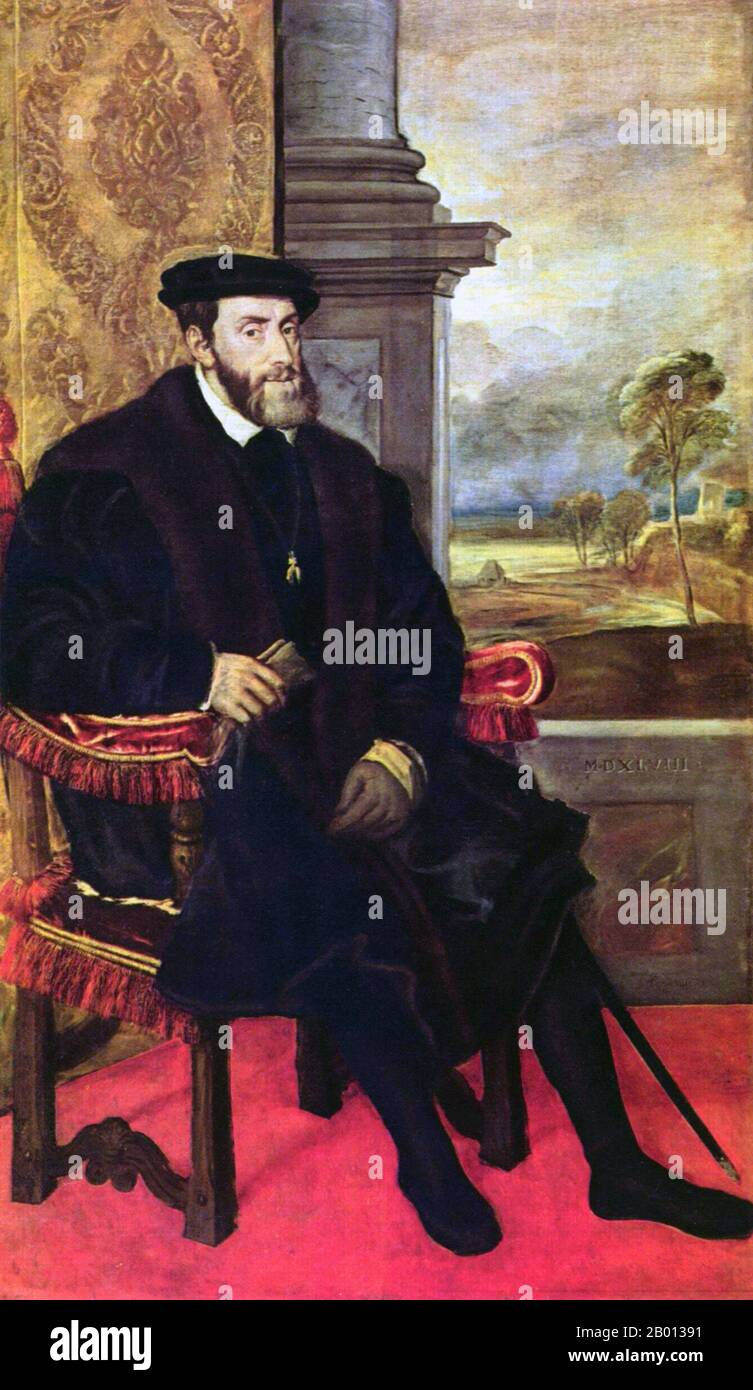 Spain: The Holy Roman Emperor Charles V (r. 1519-1556), joint signatory of the Treaty of Zaragoza dividing the Orient between Spain and Portugal. Oil on canvas painting by Lambert Sustris (1515-1584), 1548. The Treaty of Zaragoza, also referred to as the capitulation of Zaragoza, was a peace treaty between Spain and Portugal signed on 22 April of 1529 by King John III and the Emperor Charles V, in the city of Zaragoza. The treaty defined the areas of Spanish and Portuguese influence in Asia to resolve the 'Moluccas issue', when both kingdoms claimed those islands for themselves. Stock Photohttps://www.alamy.com/image-license-details/?v=1https://www.alamy.com/spain-the-holy-roman-emperor-charles-v-r-1519-1556-joint-signatory-of-the-treaty-of-zaragoza-dividing-the-orient-between-spain-and-portugal-oil-on-canvas-painting-by-lambert-sustris-1515-1584-1548-the-treaty-of-zaragoza-also-referred-to-as-the-capitulation-of-zaragoza-was-a-peace-treaty-between-spain-and-portugal-signed-on-22-april-of-1529-by-king-john-iii-and-the-emperor-charles-v-in-the-city-of-zaragoza-the-treaty-defined-the-areas-of-spanish-and-portuguese-influence-in-asia-to-resolve-the-moluccas-issue-when-both-kingdoms-claimed-those-islands-for-themselves-image344231917.html
Spain: The Holy Roman Emperor Charles V (r. 1519-1556), joint signatory of the Treaty of Zaragoza dividing the Orient between Spain and Portugal. Oil on canvas painting by Lambert Sustris (1515-1584), 1548. The Treaty of Zaragoza, also referred to as the capitulation of Zaragoza, was a peace treaty between Spain and Portugal signed on 22 April of 1529 by King John III and the Emperor Charles V, in the city of Zaragoza. The treaty defined the areas of Spanish and Portuguese influence in Asia to resolve the 'Moluccas issue', when both kingdoms claimed those islands for themselves. Stock Photohttps://www.alamy.com/image-license-details/?v=1https://www.alamy.com/spain-the-holy-roman-emperor-charles-v-r-1519-1556-joint-signatory-of-the-treaty-of-zaragoza-dividing-the-orient-between-spain-and-portugal-oil-on-canvas-painting-by-lambert-sustris-1515-1584-1548-the-treaty-of-zaragoza-also-referred-to-as-the-capitulation-of-zaragoza-was-a-peace-treaty-between-spain-and-portugal-signed-on-22-april-of-1529-by-king-john-iii-and-the-emperor-charles-v-in-the-city-of-zaragoza-the-treaty-defined-the-areas-of-spanish-and-portuguese-influence-in-asia-to-resolve-the-moluccas-issue-when-both-kingdoms-claimed-those-islands-for-themselves-image344231917.htmlRM2B01391–Spain: The Holy Roman Emperor Charles V (r. 1519-1556), joint signatory of the Treaty of Zaragoza dividing the Orient between Spain and Portugal. Oil on canvas painting by Lambert Sustris (1515-1584), 1548. The Treaty of Zaragoza, also referred to as the capitulation of Zaragoza, was a peace treaty between Spain and Portugal signed on 22 April of 1529 by King John III and the Emperor Charles V, in the city of Zaragoza. The treaty defined the areas of Spanish and Portuguese influence in Asia to resolve the 'Moluccas issue', when both kingdoms claimed those islands for themselves.
 Charlemagne (742-814). King of the Franks (768-814), king of the Lombards (774-814), and emperor of the Holy Roman Empire (800-814). Portrait. Facsimile of a late 16th century engraving. 'Moeurs, usages et costumes au moyen-âge et à l'époque de la Renaissance', by Paul Lacroix. Paris, 1878. Stock Photohttps://www.alamy.com/image-license-details/?v=1https://www.alamy.com/charlemagne-742-814-king-of-the-franks-768-814-king-of-the-lombards-774-814-and-emperor-of-the-holy-roman-empire-800-814-portrait-facsimile-of-a-late-16th-century-engraving-moeurs-usages-et-costumes-au-moyen-ge-et-lpoque-de-la-renaissance-by-paul-lacroix-paris-1878-image602125816.html
Charlemagne (742-814). King of the Franks (768-814), king of the Lombards (774-814), and emperor of the Holy Roman Empire (800-814). Portrait. Facsimile of a late 16th century engraving. 'Moeurs, usages et costumes au moyen-âge et à l'époque de la Renaissance', by Paul Lacroix. Paris, 1878. Stock Photohttps://www.alamy.com/image-license-details/?v=1https://www.alamy.com/charlemagne-742-814-king-of-the-franks-768-814-king-of-the-lombards-774-814-and-emperor-of-the-holy-roman-empire-800-814-portrait-facsimile-of-a-late-16th-century-engraving-moeurs-usages-et-costumes-au-moyen-ge-et-lpoque-de-la-renaissance-by-paul-lacroix-paris-1878-image602125816.htmlRM2WYH5HC–Charlemagne (742-814). King of the Franks (768-814), king of the Lombards (774-814), and emperor of the Holy Roman Empire (800-814). Portrait. Facsimile of a late 16th century engraving. 'Moeurs, usages et costumes au moyen-âge et à l'époque de la Renaissance', by Paul Lacroix. Paris, 1878.
 The throne of the Emperor of Constantinople, the capital city of the Roman/Byzantine Empire. From the mid-5th century to the early 13th century, it was the largest and wealthiest city in Europe. Constantinople was instrumental in the advancement of Christianity during Roman and Byzantine times as the home of the Ecumenical Patriarch of Constantinople and as the guardian of Christendom's holiest relics such as the Crown of Thorns and the True Cross. Stock Photohttps://www.alamy.com/image-license-details/?v=1https://www.alamy.com/the-throne-of-the-emperor-of-constantinople-the-capital-city-of-the-romanbyzantine-empire-from-the-mid-5th-century-to-the-early-13th-century-it-was-the-largest-and-wealthiest-city-in-europe-constantinople-was-instrumental-in-the-advancement-of-christianity-during-roman-and-byzantine-times-as-the-home-of-the-ecumenical-patriarch-of-constantinople-and-as-the-guardian-of-christendoms-holiest-relics-such-as-the-crown-of-thorns-and-the-true-cross-image185845810.html
The throne of the Emperor of Constantinople, the capital city of the Roman/Byzantine Empire. From the mid-5th century to the early 13th century, it was the largest and wealthiest city in Europe. Constantinople was instrumental in the advancement of Christianity during Roman and Byzantine times as the home of the Ecumenical Patriarch of Constantinople and as the guardian of Christendom's holiest relics such as the Crown of Thorns and the True Cross. Stock Photohttps://www.alamy.com/image-license-details/?v=1https://www.alamy.com/the-throne-of-the-emperor-of-constantinople-the-capital-city-of-the-romanbyzantine-empire-from-the-mid-5th-century-to-the-early-13th-century-it-was-the-largest-and-wealthiest-city-in-europe-constantinople-was-instrumental-in-the-advancement-of-christianity-during-roman-and-byzantine-times-as-the-home-of-the-ecumenical-patriarch-of-constantinople-and-as-the-guardian-of-christendoms-holiest-relics-such-as-the-crown-of-thorns-and-the-true-cross-image185845810.htmlRMMPA06A–The throne of the Emperor of Constantinople, the capital city of the Roman/Byzantine Empire. From the mid-5th century to the early 13th century, it was the largest and wealthiest city in Europe. Constantinople was instrumental in the advancement of Christianity during Roman and Byzantine times as the home of the Ecumenical Patriarch of Constantinople and as the guardian of Christendom's holiest relics such as the Crown of Thorns and the True Cross.
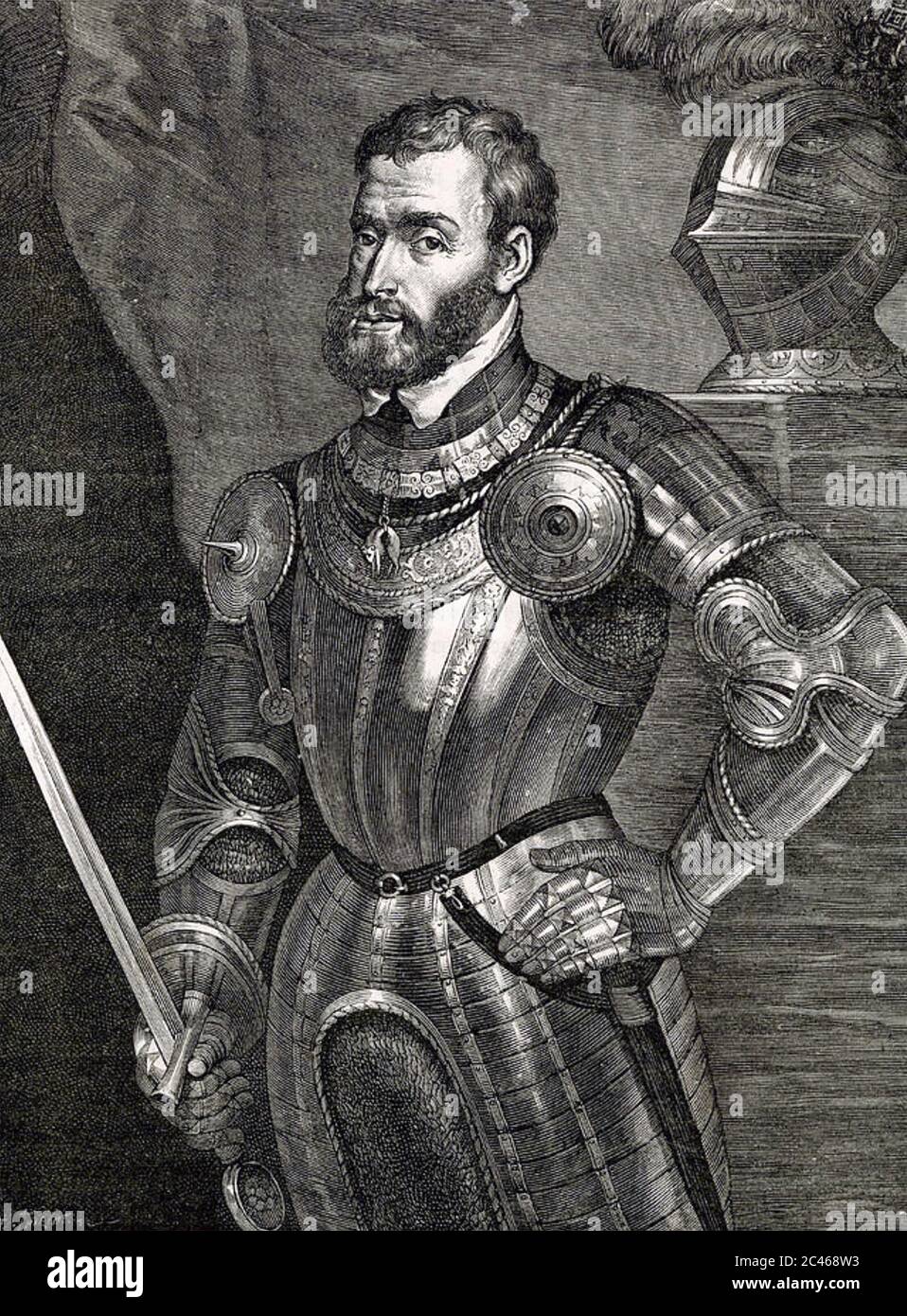 CHARLES V, Holy Roman Emperor (1500-1558) Stock Photohttps://www.alamy.com/image-license-details/?v=1https://www.alamy.com/charles-v-holy-roman-emperor-1500-1558-image364015039.html
CHARLES V, Holy Roman Emperor (1500-1558) Stock Photohttps://www.alamy.com/image-license-details/?v=1https://www.alamy.com/charles-v-holy-roman-emperor-1500-1558-image364015039.htmlRM2C468W3–CHARLES V, Holy Roman Emperor (1500-1558)
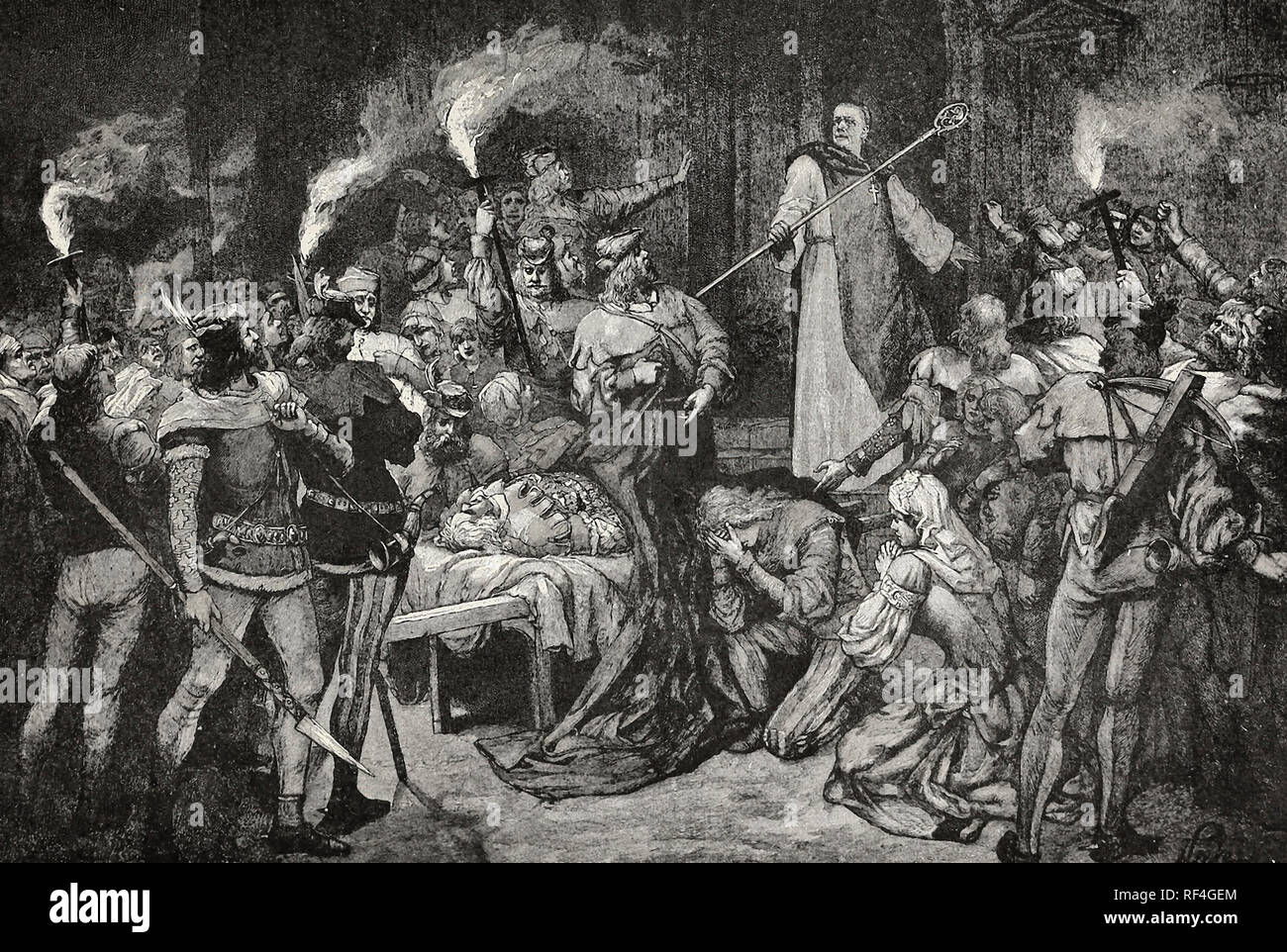 The Emperor Ludwig IV, Louis IV, Holy Roman Emperor, having been expelled by the Church, is refused Christian Burial, 1347 Stock Photohttps://www.alamy.com/image-license-details/?v=1https://www.alamy.com/the-emperor-ludwig-iv-louis-iv-holy-roman-emperor-having-been-expelled-by-the-church-is-refused-christian-burial-1347-image233055388.html
The Emperor Ludwig IV, Louis IV, Holy Roman Emperor, having been expelled by the Church, is refused Christian Burial, 1347 Stock Photohttps://www.alamy.com/image-license-details/?v=1https://www.alamy.com/the-emperor-ludwig-iv-louis-iv-holy-roman-emperor-having-been-expelled-by-the-church-is-refused-christian-burial-1347-image233055388.htmlRMRF4GEM–The Emperor Ludwig IV, Louis IV, Holy Roman Emperor, having been expelled by the Church, is refused Christian Burial, 1347
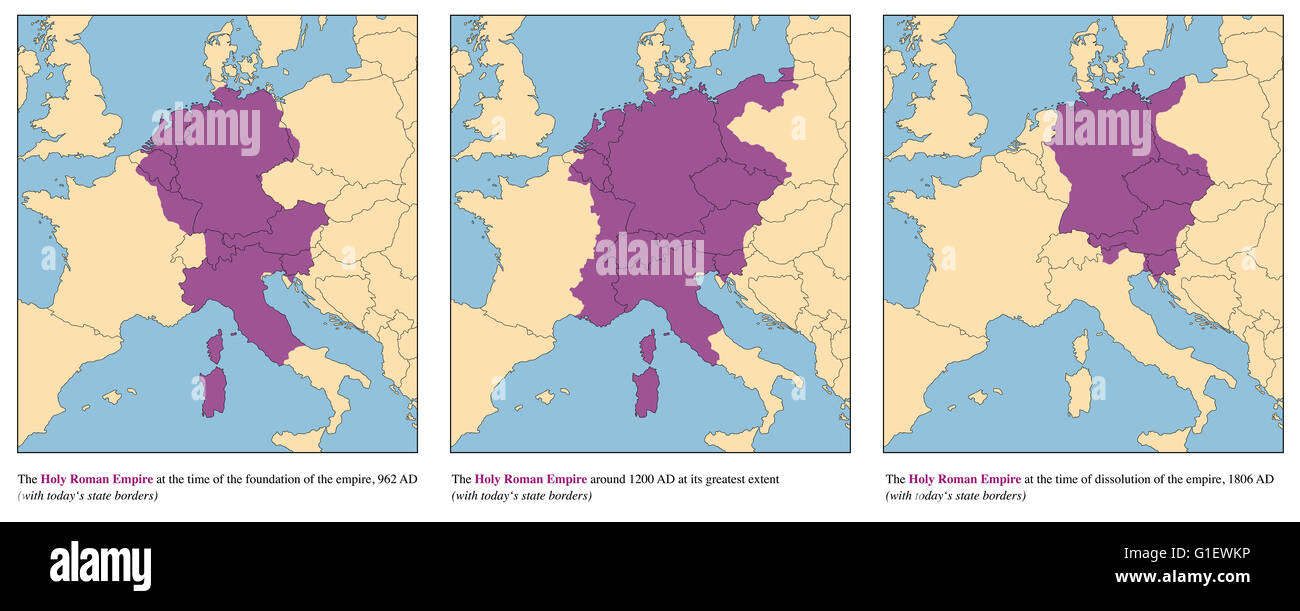 Holy Roman Empire - rise and fall of the medieval europe empire from 962 AD to 1806 AD - with todays state borders. Stock Photohttps://www.alamy.com/image-license-details/?v=1https://www.alamy.com/stock-photo-holy-roman-empire-rise-and-fall-of-the-medieval-europe-empire-from-104204346.html
Holy Roman Empire - rise and fall of the medieval europe empire from 962 AD to 1806 AD - with todays state borders. Stock Photohttps://www.alamy.com/image-license-details/?v=1https://www.alamy.com/stock-photo-holy-roman-empire-rise-and-fall-of-the-medieval-europe-empire-from-104204346.htmlRFG1EWKP–Holy Roman Empire - rise and fall of the medieval europe empire from 962 AD to 1806 AD - with todays state borders.
 Allegory of the Abdication of Emperor Charles V Holy Roman Empire 1630 Frans Francken II 1581-1642 Belgian, Belgium, Flemish, ( Charles V is enthroned at centre. Battle weary and wracked by illness, in 1555 he divided up his empire. ) Stock Photohttps://www.alamy.com/image-license-details/?v=1https://www.alamy.com/allegory-of-the-abdication-of-emperor-charles-v-holy-roman-empire-1630-frans-francken-ii-1581-1642-belgian-belgium-flemish-charles-v-is-enthroned-at-centre-battle-weary-and-wracked-by-illness-in-1555-he-divided-up-his-empire-image376736072.html
Allegory of the Abdication of Emperor Charles V Holy Roman Empire 1630 Frans Francken II 1581-1642 Belgian, Belgium, Flemish, ( Charles V is enthroned at centre. Battle weary and wracked by illness, in 1555 he divided up his empire. ) Stock Photohttps://www.alamy.com/image-license-details/?v=1https://www.alamy.com/allegory-of-the-abdication-of-emperor-charles-v-holy-roman-empire-1630-frans-francken-ii-1581-1642-belgian-belgium-flemish-charles-v-is-enthroned-at-centre-battle-weary-and-wracked-by-illness-in-1555-he-divided-up-his-empire-image376736072.htmlRM2CTWPKM–Allegory of the Abdication of Emperor Charles V Holy Roman Empire 1630 Frans Francken II 1581-1642 Belgian, Belgium, Flemish, ( Charles V is enthroned at centre. Battle weary and wracked by illness, in 1555 he divided up his empire. )
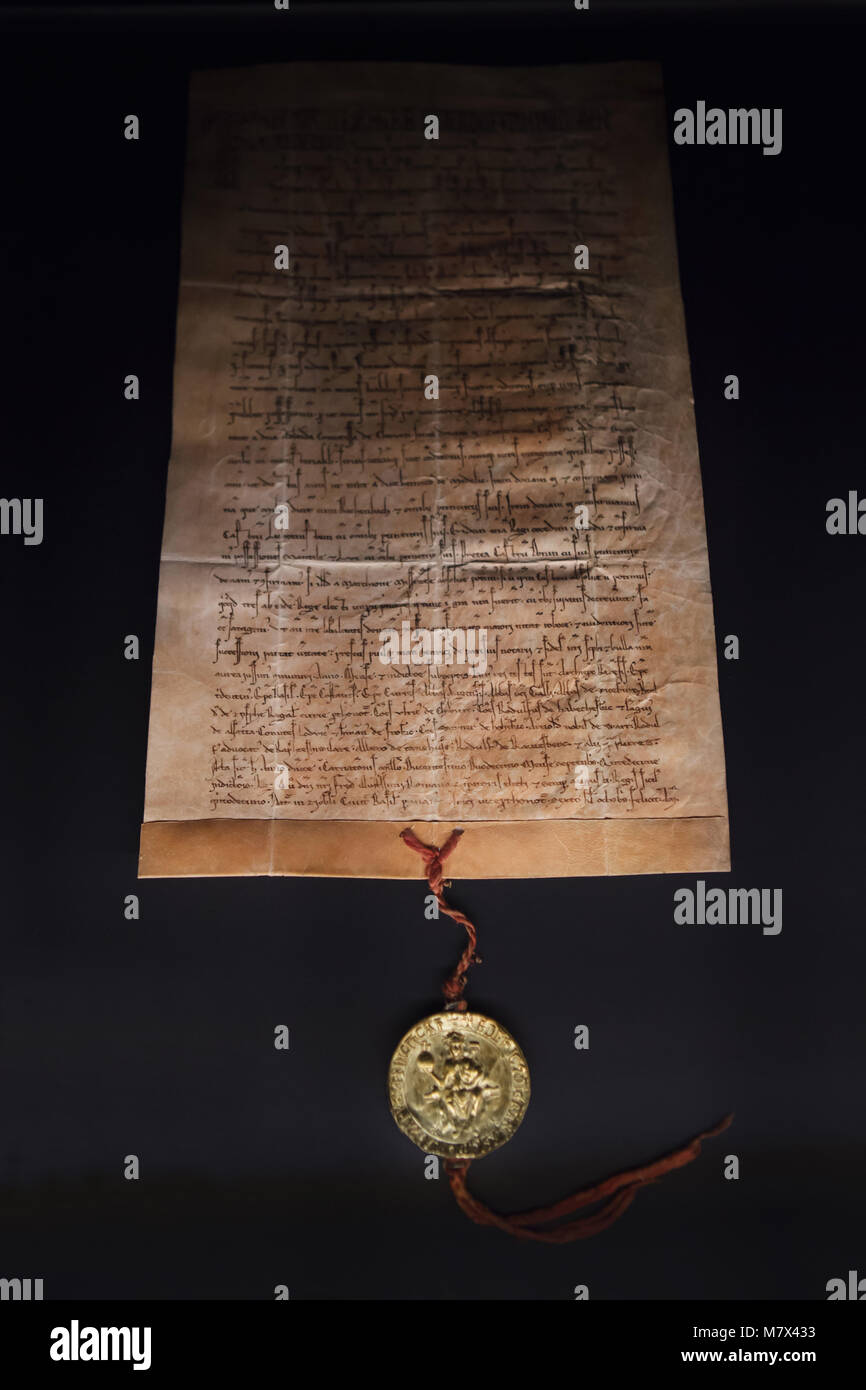 Golden Bull of Sicily (Zlatá bula sicilská) on display at the exhibition 'At the Beginning of the Statehood' in Prague, Czech Republic. The Golden Bull of Sicily was a decree issued by Holy Roman Emperor Frederick II in Basel on 26 September 1212 that confirmed the royal title obtained by Ottokar I of Bohemia in 1198, declaring him and his heirs Kings of Bohemia. The exhibition to celebrate the 100th anniversary of Czechoslovakia runs for only five days from January 10 to January 15, 2018 in the Imperial Stables of Prague Castle. Stock Photohttps://www.alamy.com/image-license-details/?v=1https://www.alamy.com/stock-photo-golden-bull-of-sicily-zlat-bula-sicilsk-on-display-at-the-exhibition-176980247.html
Golden Bull of Sicily (Zlatá bula sicilská) on display at the exhibition 'At the Beginning of the Statehood' in Prague, Czech Republic. The Golden Bull of Sicily was a decree issued by Holy Roman Emperor Frederick II in Basel on 26 September 1212 that confirmed the royal title obtained by Ottokar I of Bohemia in 1198, declaring him and his heirs Kings of Bohemia. The exhibition to celebrate the 100th anniversary of Czechoslovakia runs for only five days from January 10 to January 15, 2018 in the Imperial Stables of Prague Castle. Stock Photohttps://www.alamy.com/image-license-details/?v=1https://www.alamy.com/stock-photo-golden-bull-of-sicily-zlat-bula-sicilsk-on-display-at-the-exhibition-176980247.htmlRMM7X433–Golden Bull of Sicily (Zlatá bula sicilská) on display at the exhibition 'At the Beginning of the Statehood' in Prague, Czech Republic. The Golden Bull of Sicily was a decree issued by Holy Roman Emperor Frederick II in Basel on 26 September 1212 that confirmed the royal title obtained by Ottokar I of Bohemia in 1198, declaring him and his heirs Kings of Bohemia. The exhibition to celebrate the 100th anniversary of Czechoslovakia runs for only five days from January 10 to January 15, 2018 in the Imperial Stables of Prague Castle.
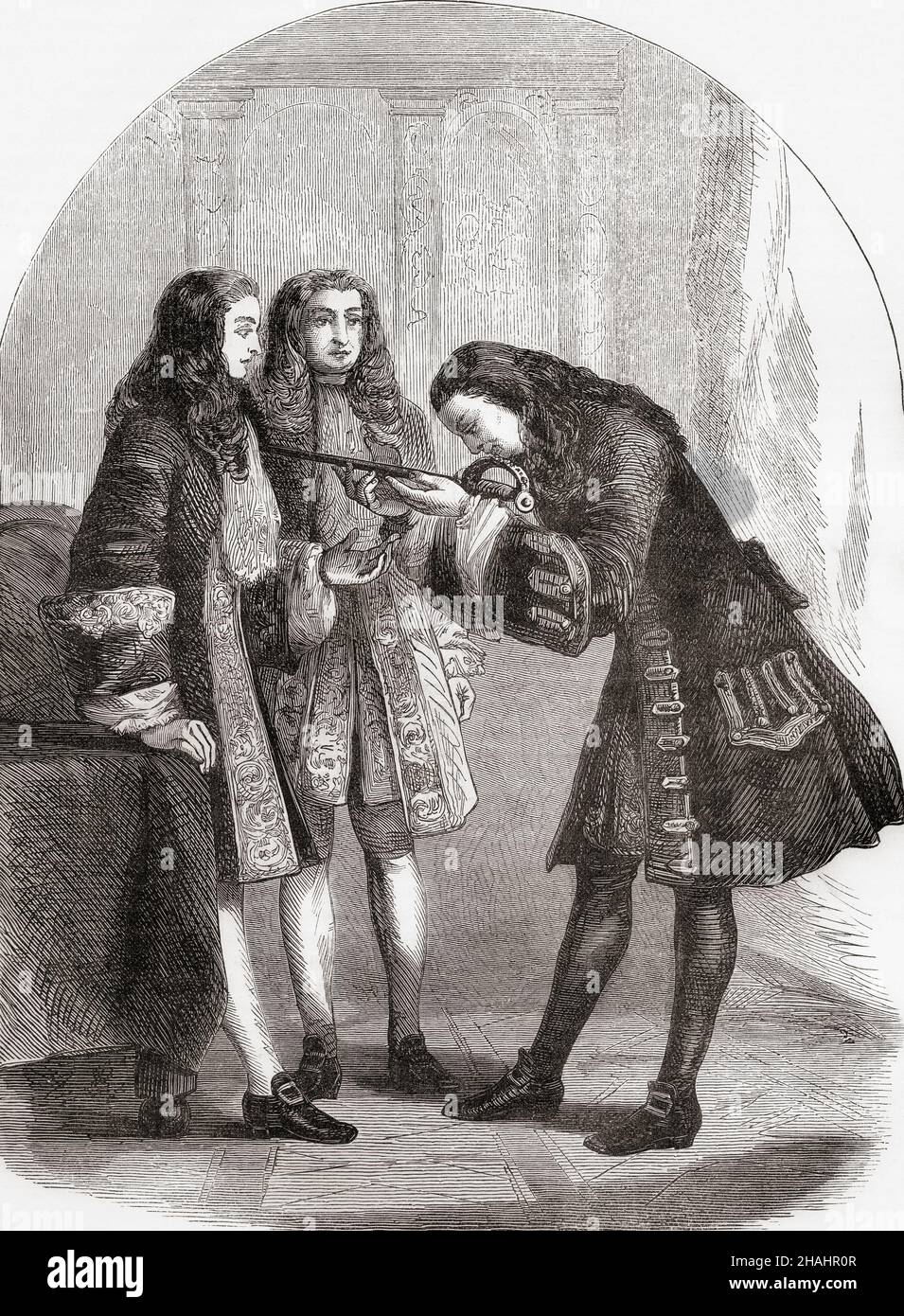 Archduke Charles, claimant to the Spanish throne after the death of Charles II in 1700, presents his sword to the Duke of Marlborough who had been commissioned by Queen Anne to present his congratulations. Charles VI, right, 1685 –1740. Holy Roman Emperor and ruler of the Austrian Habsburg Monarchy. General John Churchill, 1st Duke of Marlborough, 1st Prince of Mindelheim, 1st Count of Nellenburg, Prince of the Holy Roman Empire, 1650 – 1722. English soldier and statesman. From Cassell's Illustrated History of England, published c.1890. Stock Photohttps://www.alamy.com/image-license-details/?v=1https://www.alamy.com/archduke-charles-claimant-to-the-spanish-throne-after-the-death-of-charles-ii-in-1700-presents-his-sword-to-the-duke-of-marlborough-who-had-been-commissioned-by-queen-anne-to-present-his-congratulations-charles-vi-right-1685-1740-holy-roman-emperor-and-ruler-of-the-austrian-habsburg-monarchy-general-john-churchill-1st-duke-of-marlborough-1st-prince-of-mindelheim-1st-count-of-nellenburg-prince-of-the-holy-roman-empire-1650-1722-english-soldier-and-statesman-from-cassells-illustrated-history-of-england-published-c1890-image454007367.html
Archduke Charles, claimant to the Spanish throne after the death of Charles II in 1700, presents his sword to the Duke of Marlborough who had been commissioned by Queen Anne to present his congratulations. Charles VI, right, 1685 –1740. Holy Roman Emperor and ruler of the Austrian Habsburg Monarchy. General John Churchill, 1st Duke of Marlborough, 1st Prince of Mindelheim, 1st Count of Nellenburg, Prince of the Holy Roman Empire, 1650 – 1722. English soldier and statesman. From Cassell's Illustrated History of England, published c.1890. Stock Photohttps://www.alamy.com/image-license-details/?v=1https://www.alamy.com/archduke-charles-claimant-to-the-spanish-throne-after-the-death-of-charles-ii-in-1700-presents-his-sword-to-the-duke-of-marlborough-who-had-been-commissioned-by-queen-anne-to-present-his-congratulations-charles-vi-right-1685-1740-holy-roman-emperor-and-ruler-of-the-austrian-habsburg-monarchy-general-john-churchill-1st-duke-of-marlborough-1st-prince-of-mindelheim-1st-count-of-nellenburg-prince-of-the-holy-roman-empire-1650-1722-english-soldier-and-statesman-from-cassells-illustrated-history-of-england-published-c1890-image454007367.htmlRM2HAHR0R–Archduke Charles, claimant to the Spanish throne after the death of Charles II in 1700, presents his sword to the Duke of Marlborough who had been commissioned by Queen Anne to present his congratulations. Charles VI, right, 1685 –1740. Holy Roman Emperor and ruler of the Austrian Habsburg Monarchy. General John Churchill, 1st Duke of Marlborough, 1st Prince of Mindelheim, 1st Count of Nellenburg, Prince of the Holy Roman Empire, 1650 – 1722. English soldier and statesman. From Cassell's Illustrated History of England, published c.1890.
 Granada, Spain, August 14, 2011: Palace of Charles V in the Alhambra of Granada, Spain. Charles V, King of Spain and Emperor of the Holy Roman Empire Stock Photohttps://www.alamy.com/image-license-details/?v=1https://www.alamy.com/granada-spain-august-14-2011-palace-of-charles-v-in-the-alhambra-of-granada-spain-charles-v-king-of-spain-and-emperor-of-the-holy-roman-empire-image619694307.html
Granada, Spain, August 14, 2011: Palace of Charles V in the Alhambra of Granada, Spain. Charles V, King of Spain and Emperor of the Holy Roman Empire Stock Photohttps://www.alamy.com/image-license-details/?v=1https://www.alamy.com/granada-spain-august-14-2011-palace-of-charles-v-in-the-alhambra-of-granada-spain-charles-v-king-of-spain-and-emperor-of-the-holy-roman-empire-image619694307.htmlRM2Y05EBF–Granada, Spain, August 14, 2011: Palace of Charles V in the Alhambra of Granada, Spain. Charles V, King of Spain and Emperor of the Holy Roman Empire
 Digital improved image of Maximilian I of Habsburg, German Emperor of the Holy Roman Empire, 1459 - 1519, historical illustratio Stock Photohttps://www.alamy.com/image-license-details/?v=1https://www.alamy.com/stock-photo-digital-improved-image-of-maximilian-i-of-habsburg-german-emperor-35603863.html
Digital improved image of Maximilian I of Habsburg, German Emperor of the Holy Roman Empire, 1459 - 1519, historical illustratio Stock Photohttps://www.alamy.com/image-license-details/?v=1https://www.alamy.com/stock-photo-digital-improved-image-of-maximilian-i-of-habsburg-german-emperor-35603863.htmlRFC1WW2F–Digital improved image of Maximilian I of Habsburg, German Emperor of the Holy Roman Empire, 1459 - 1519, historical illustratio